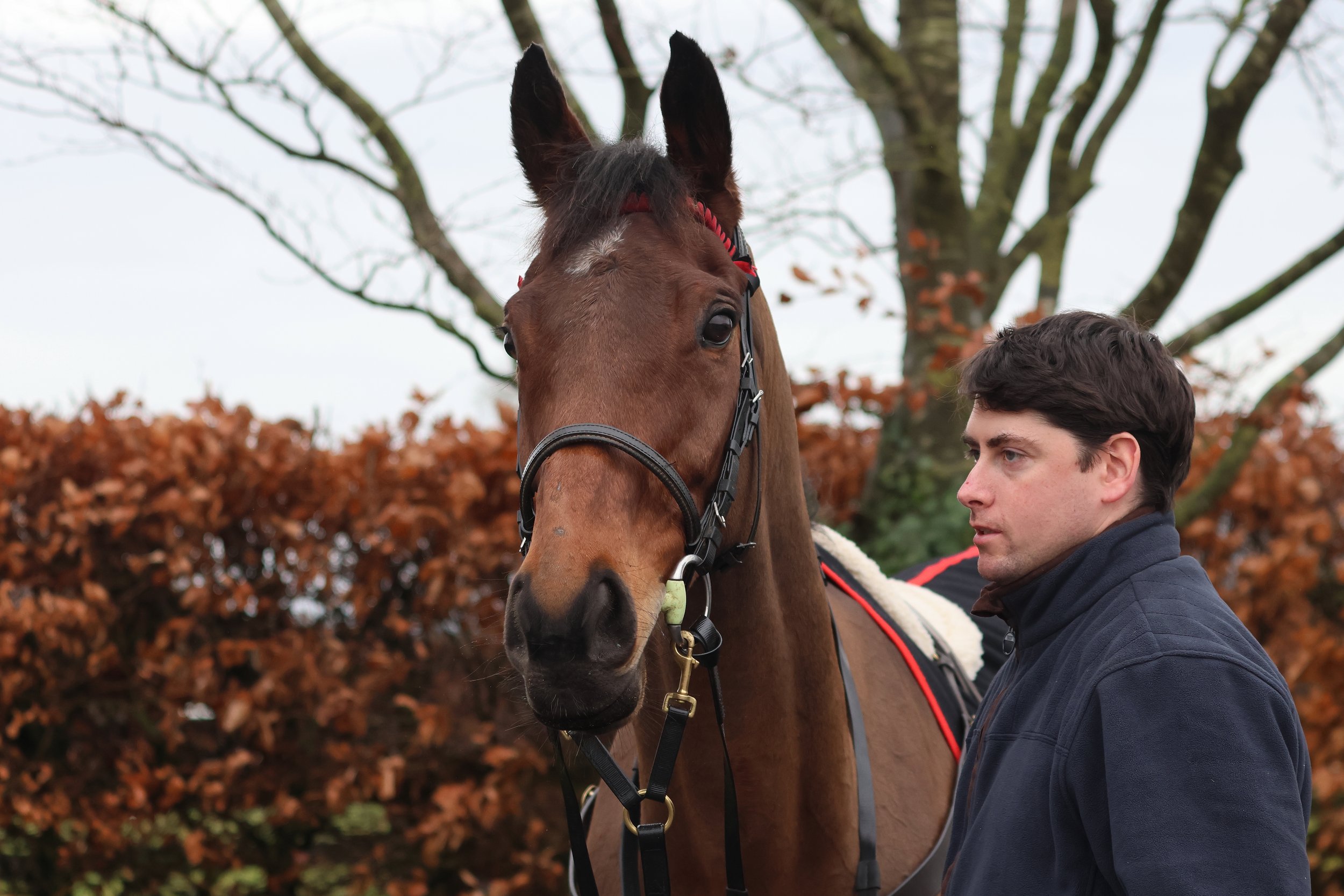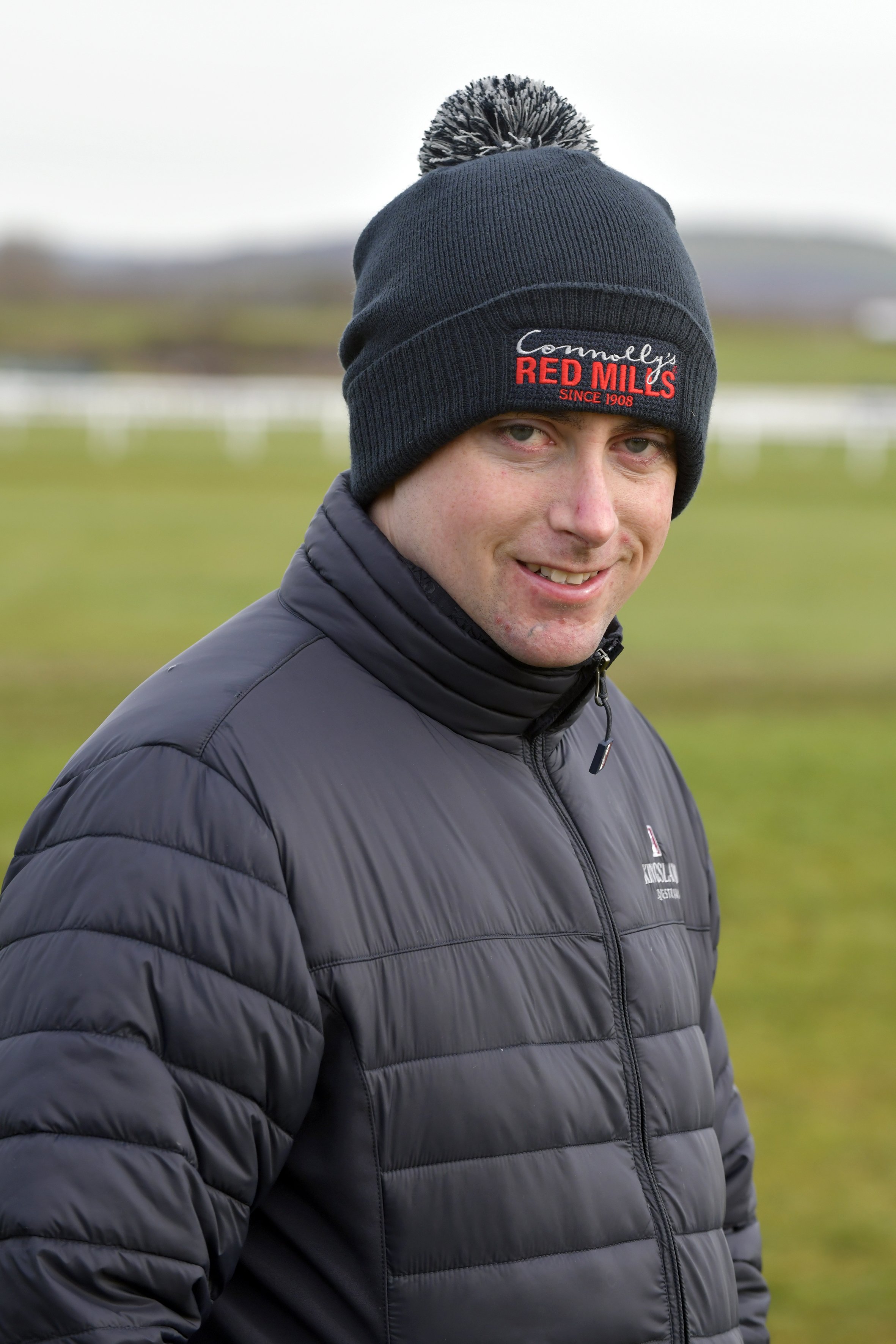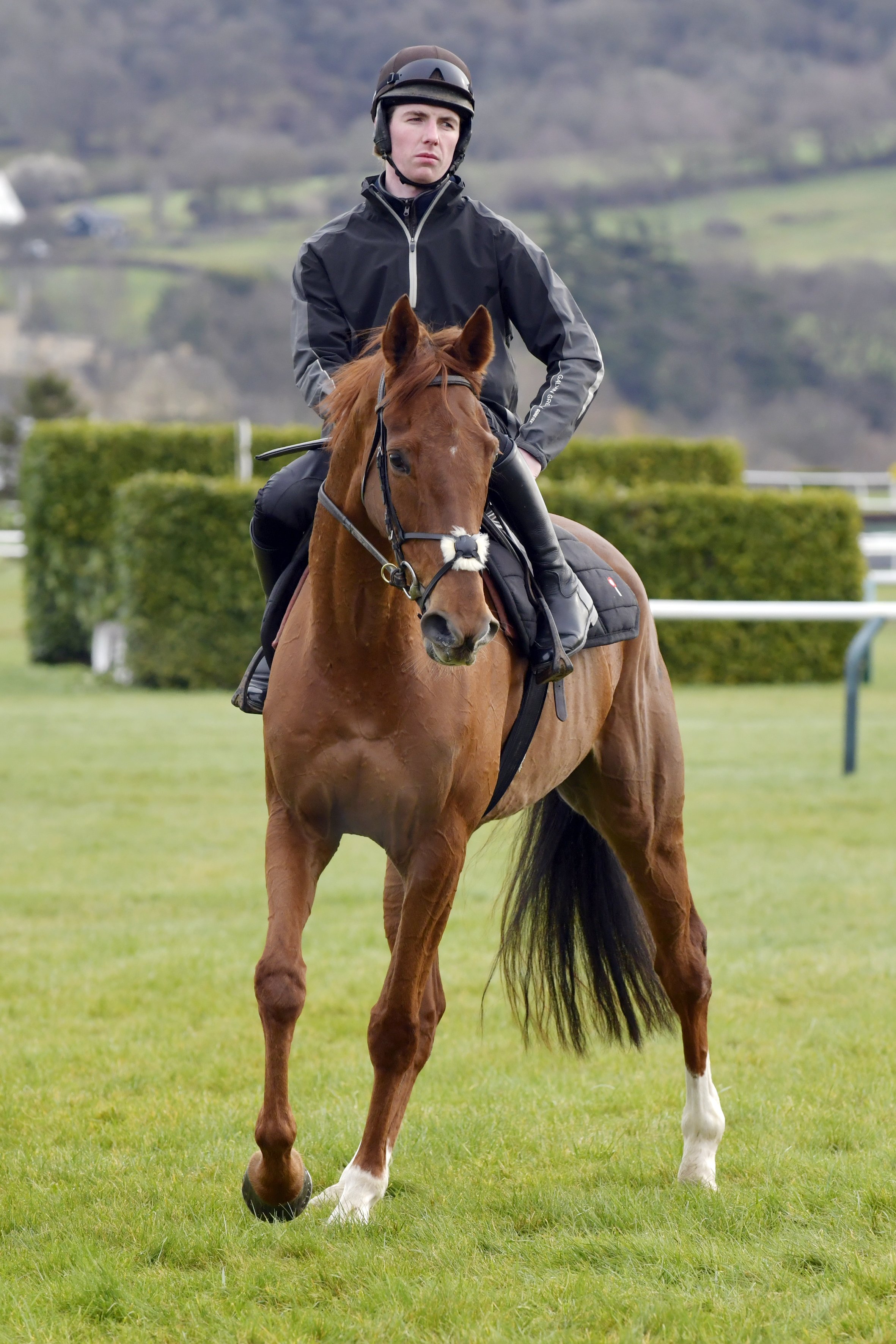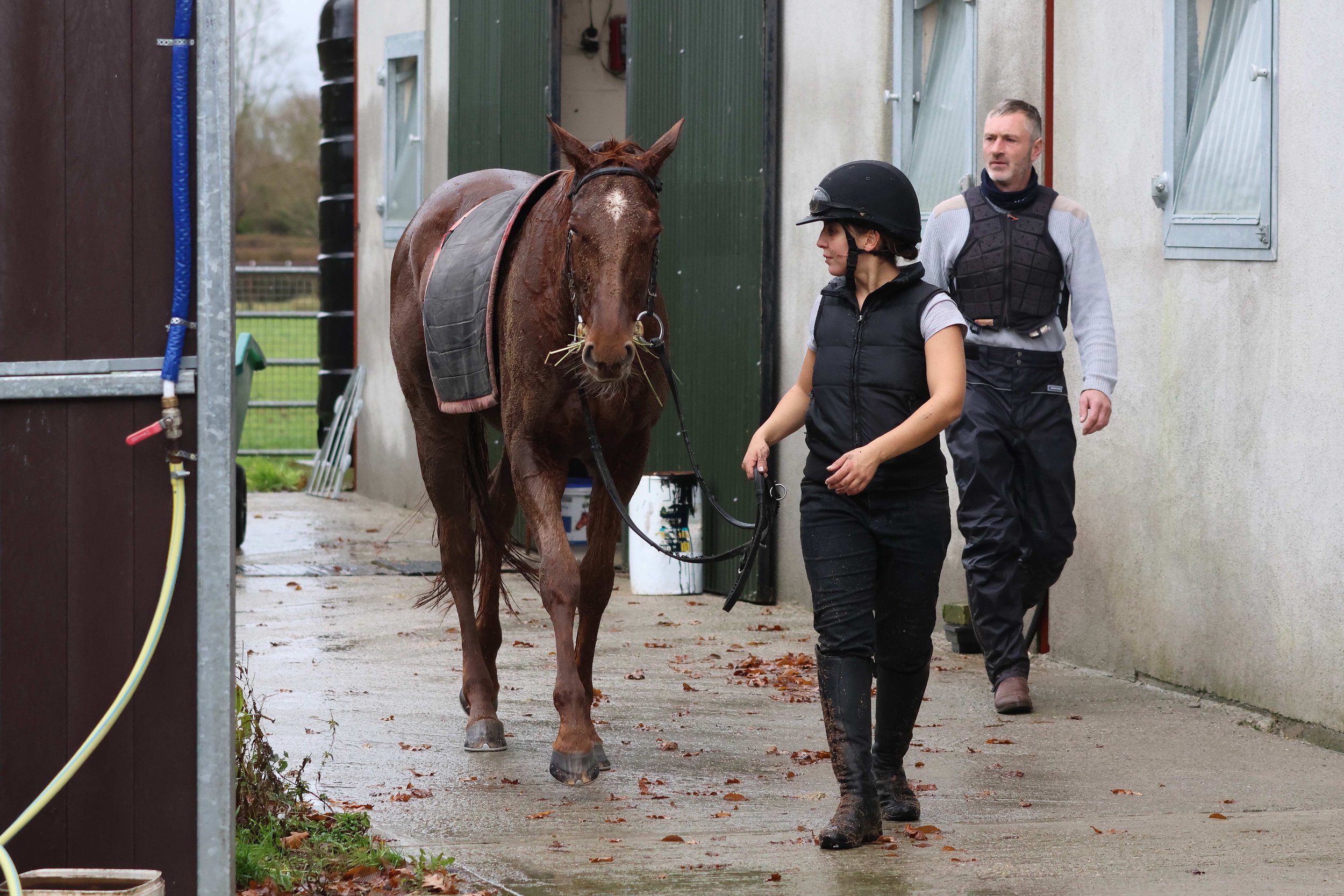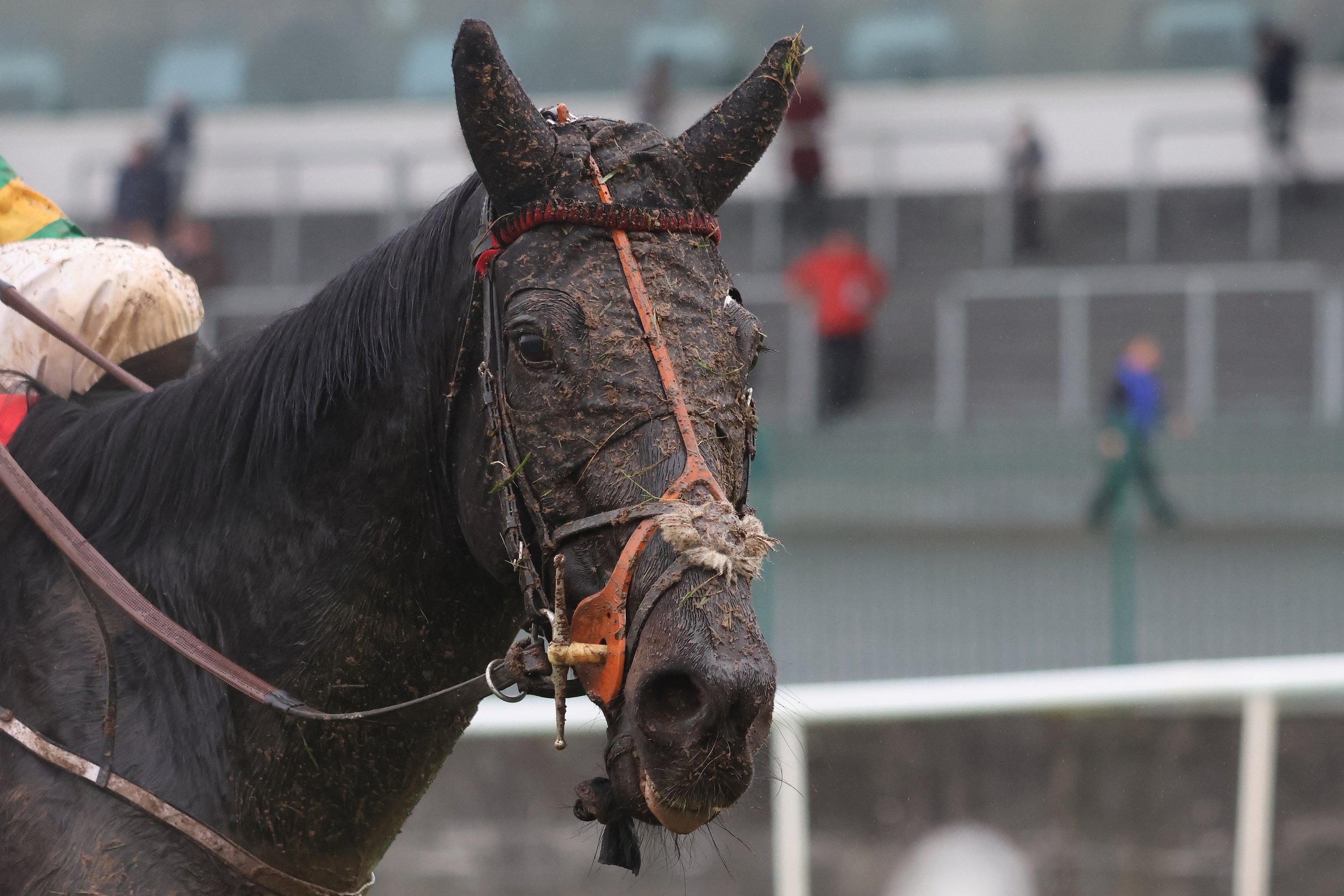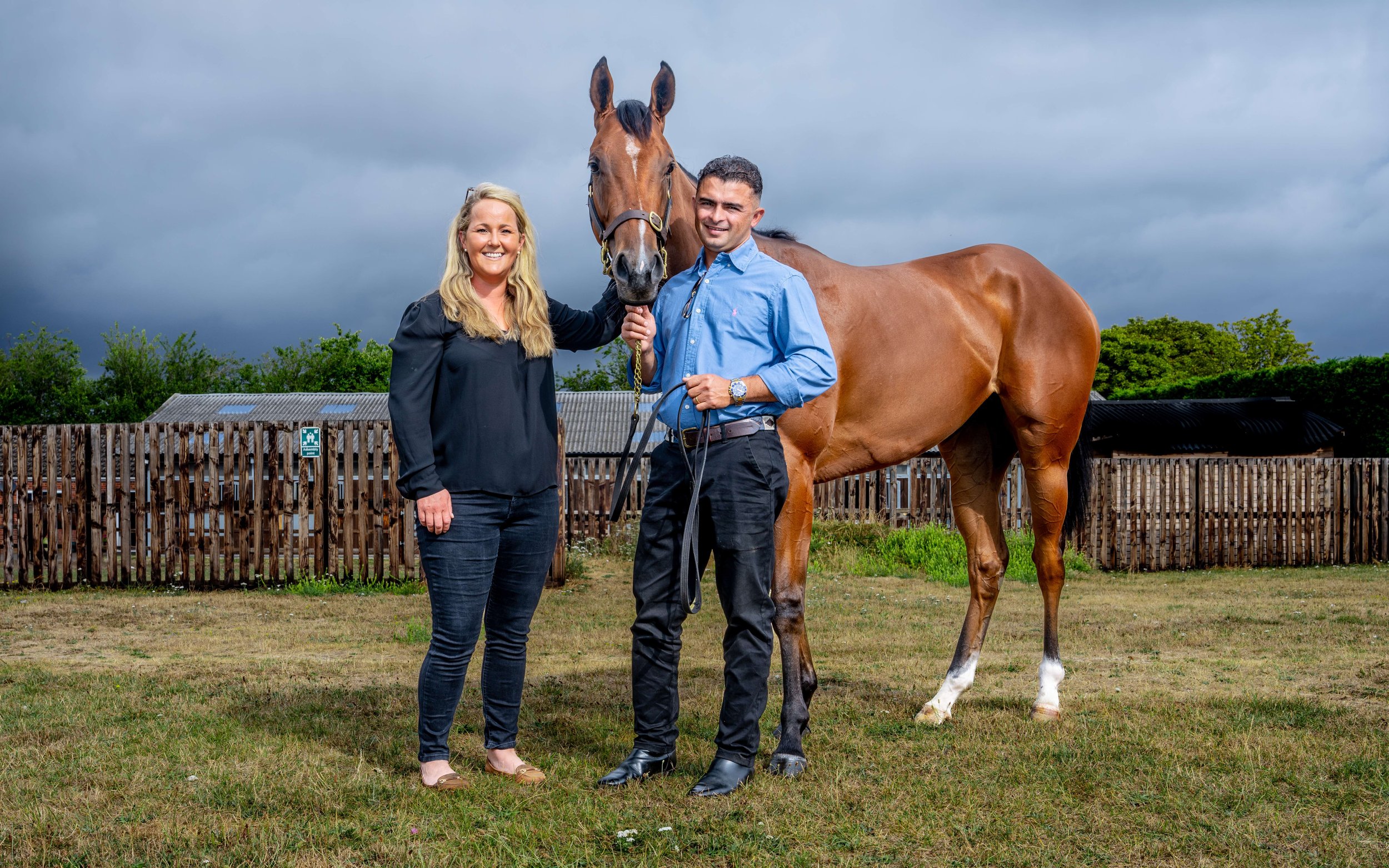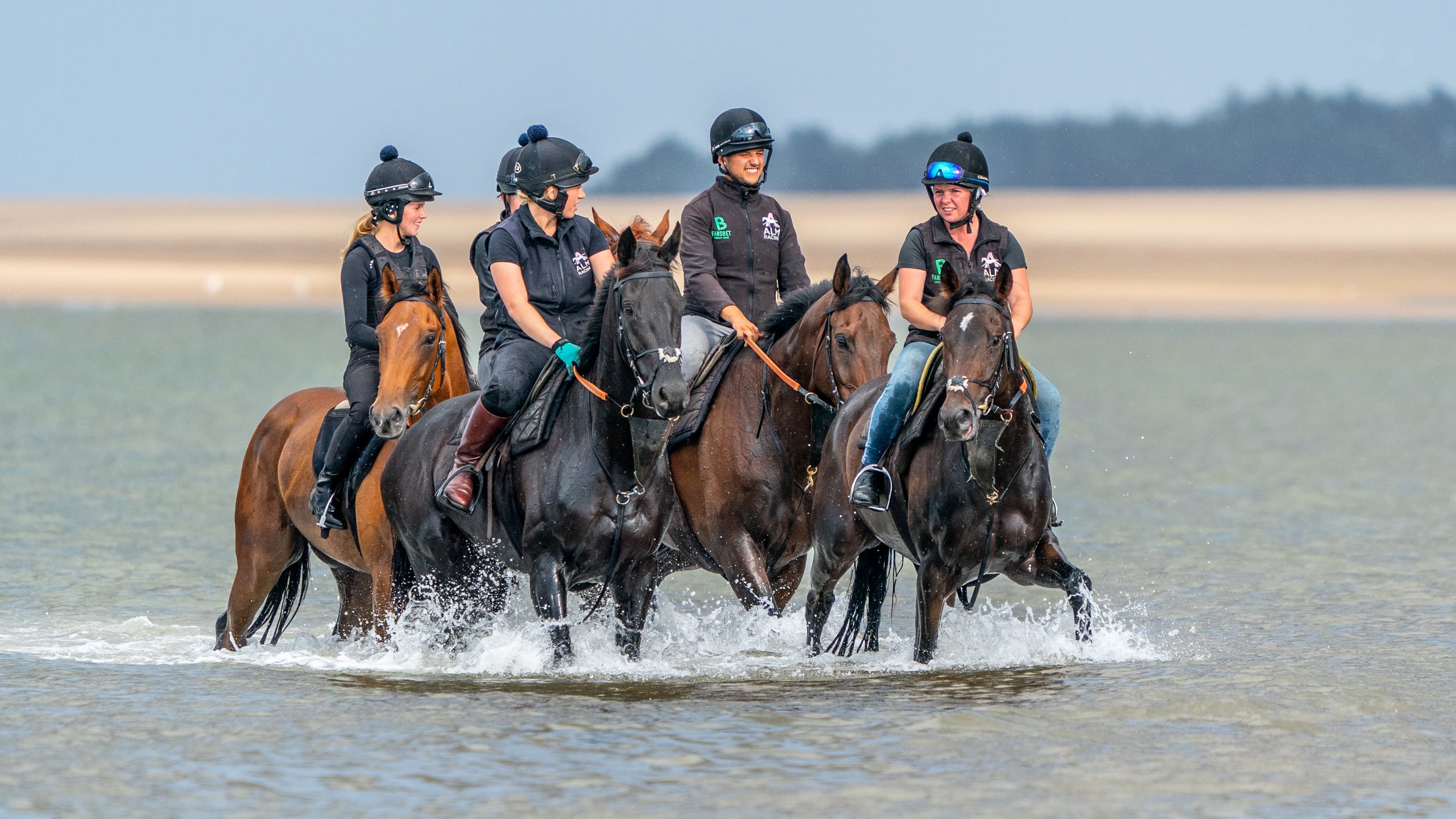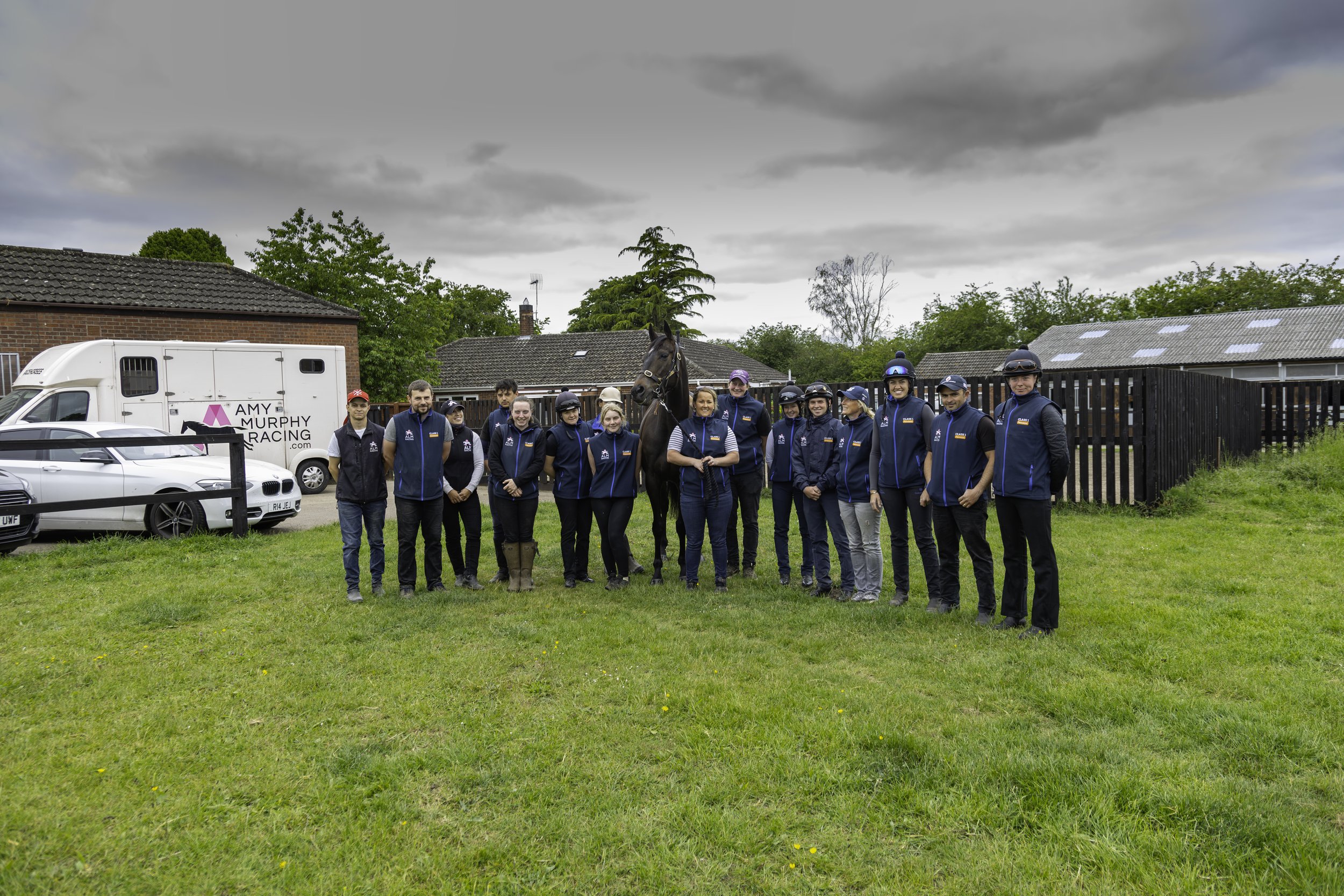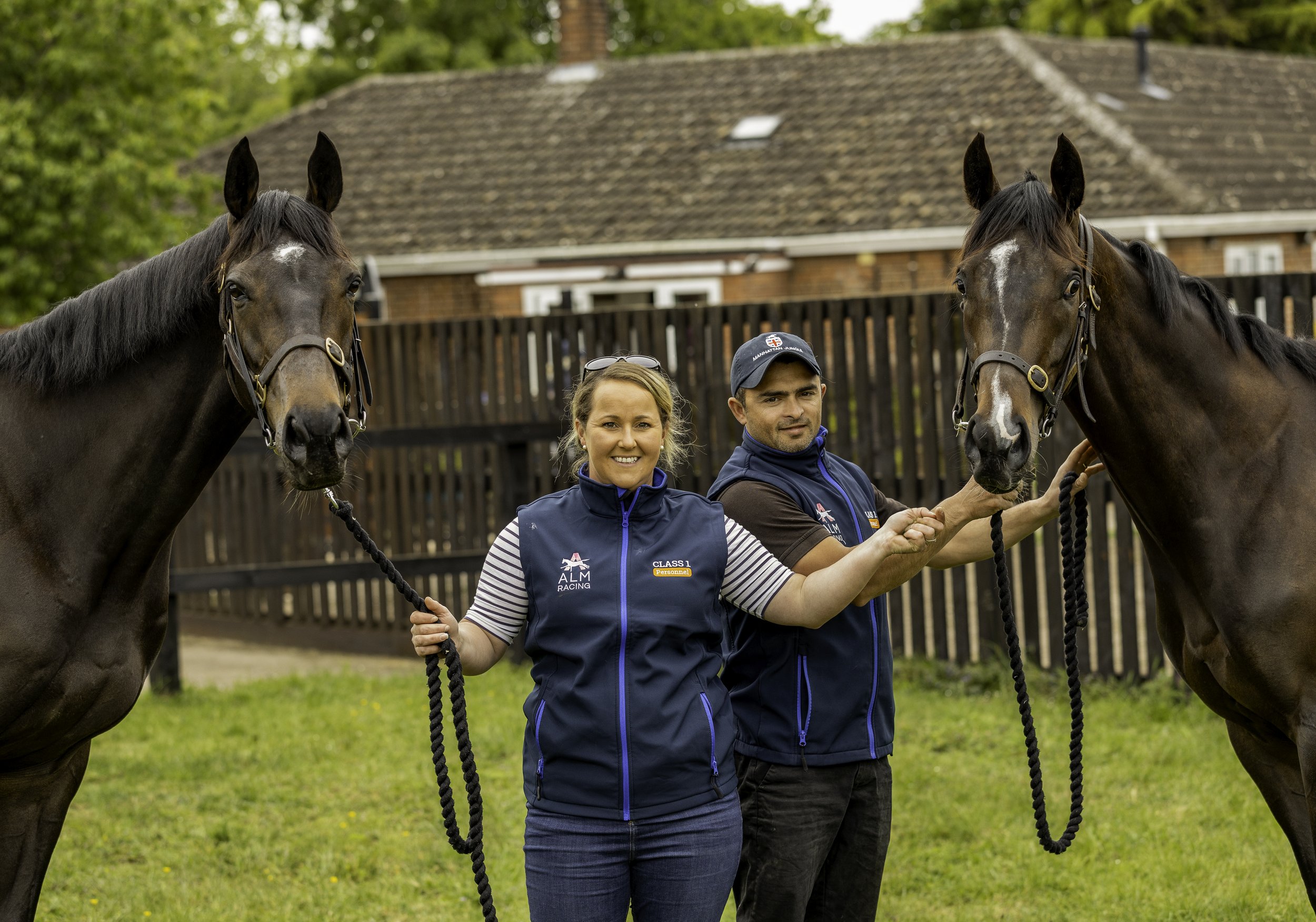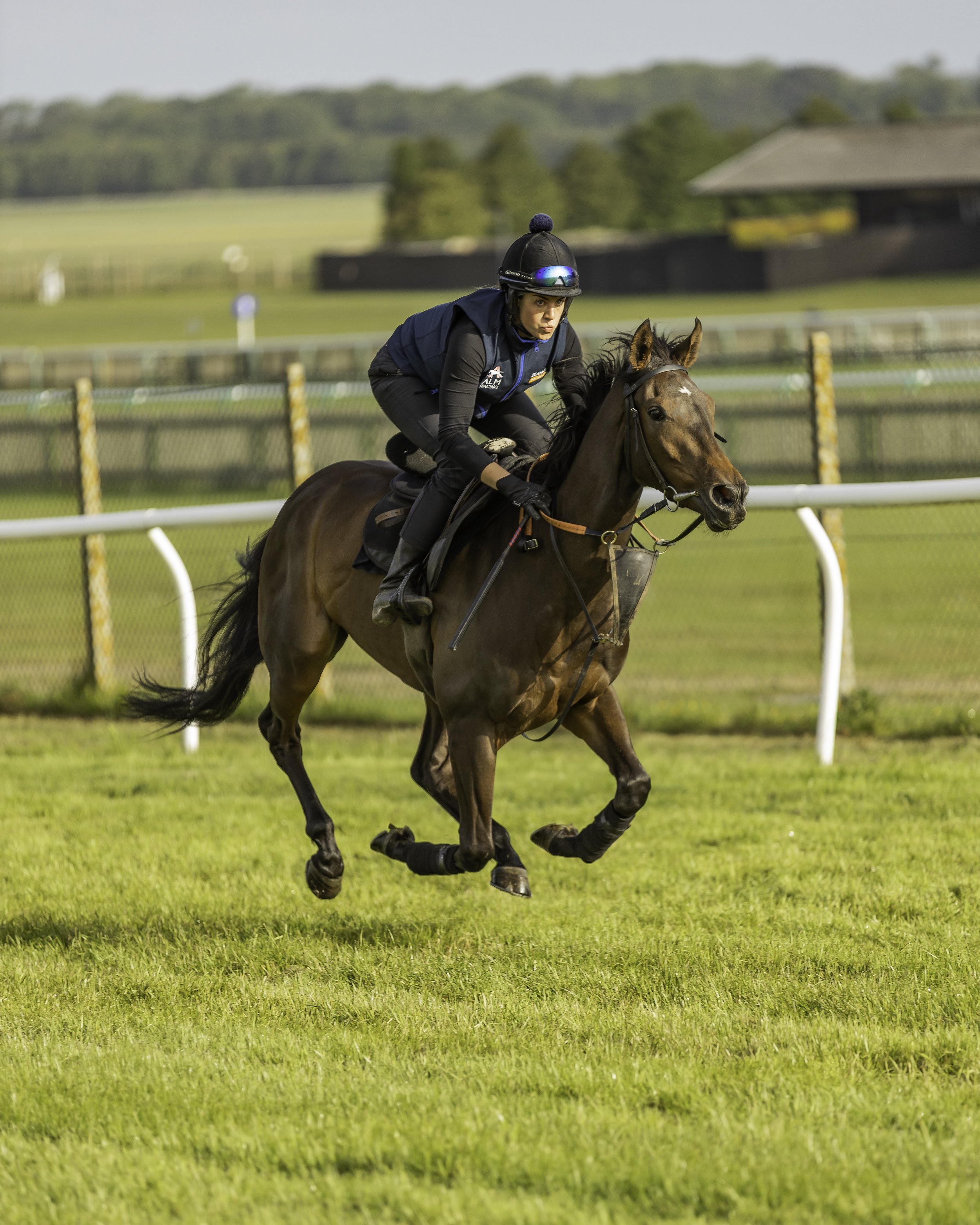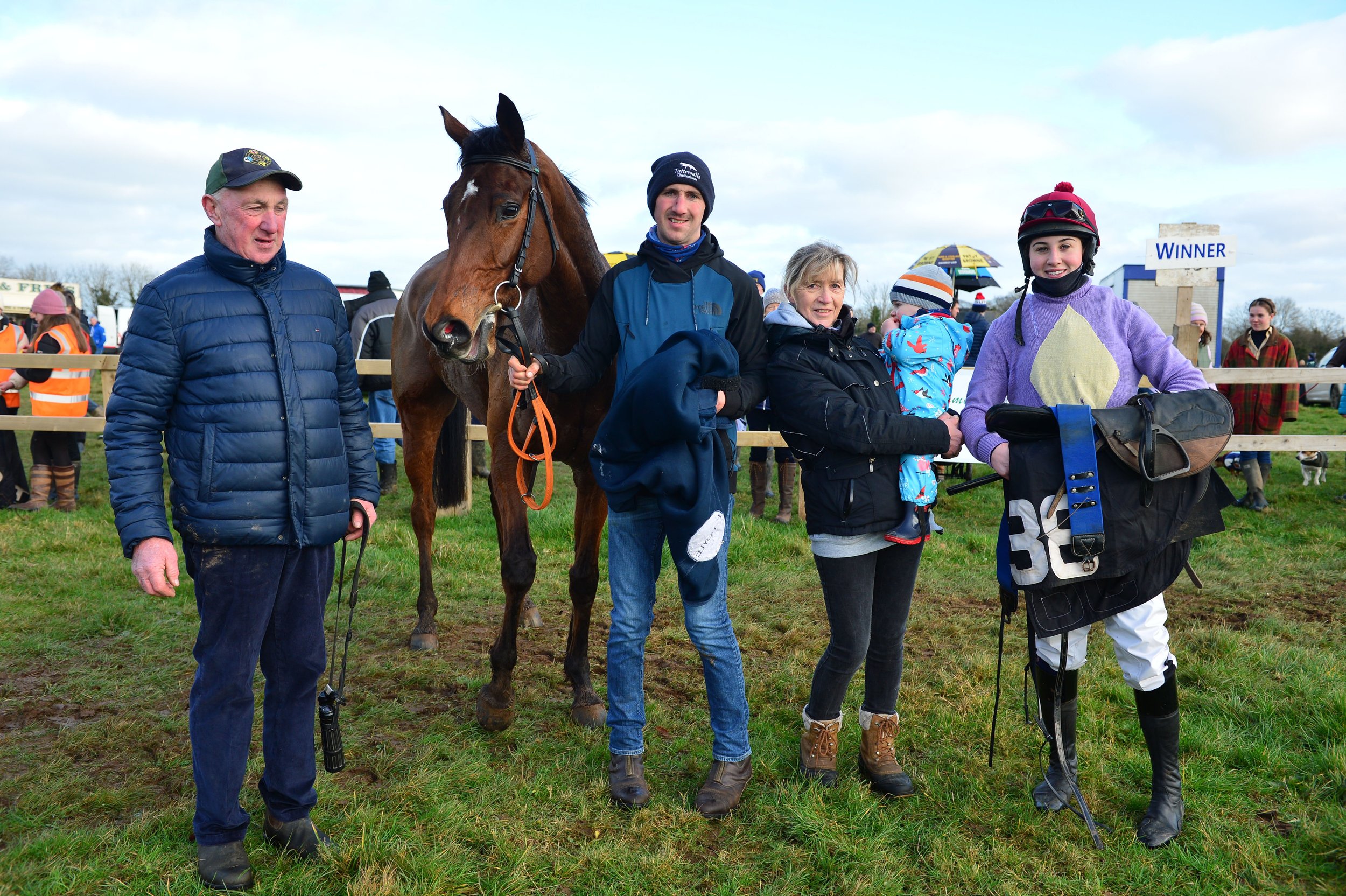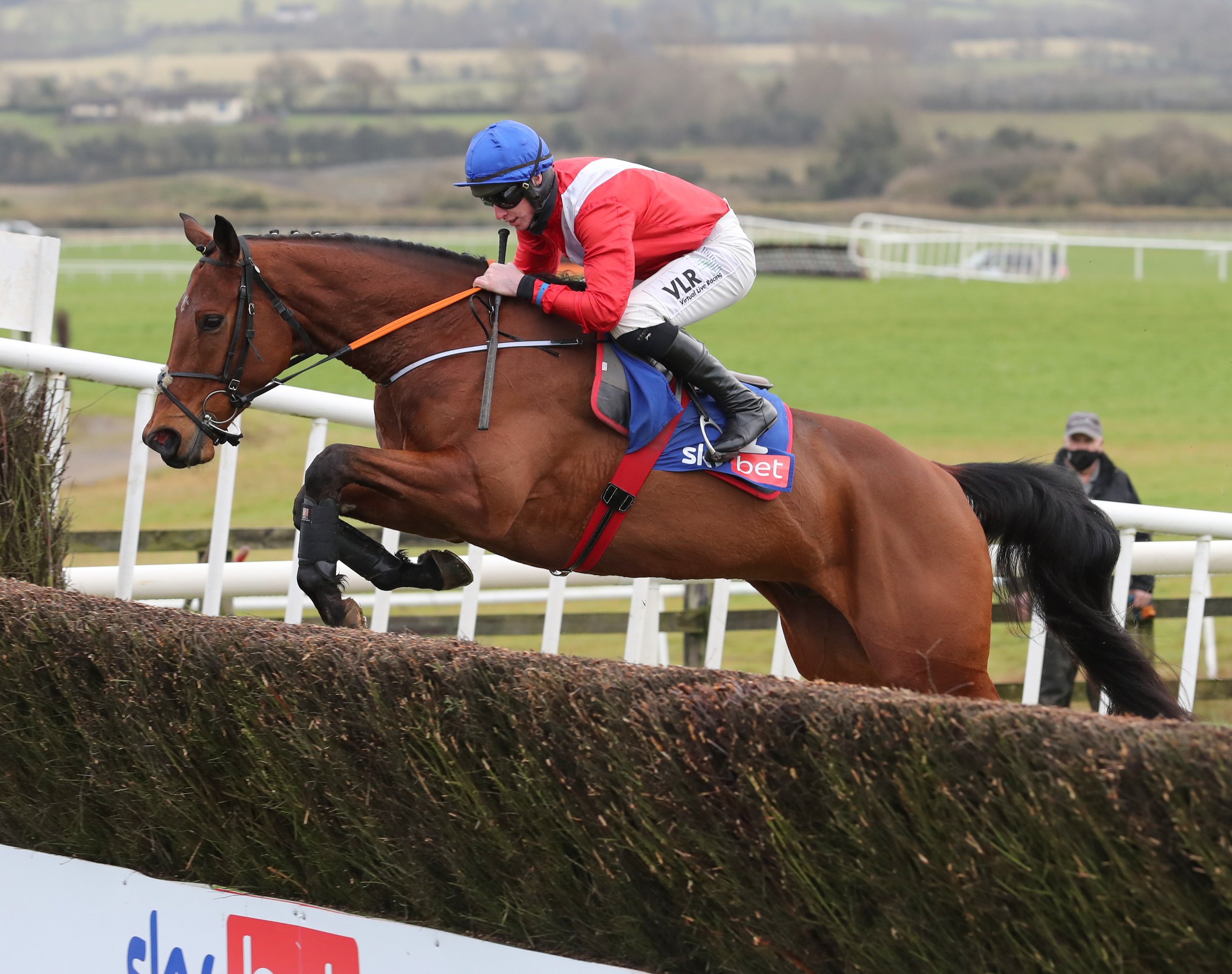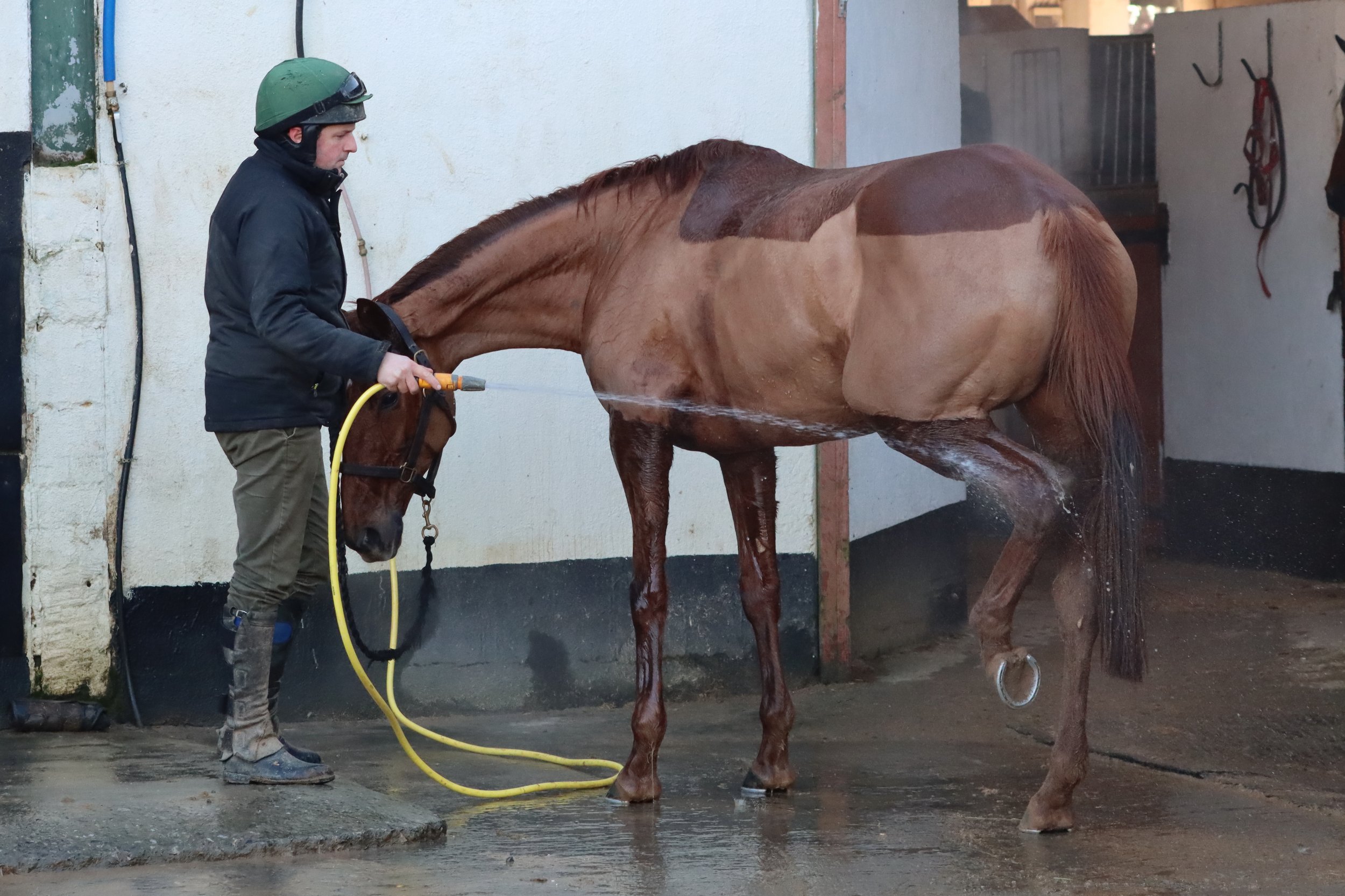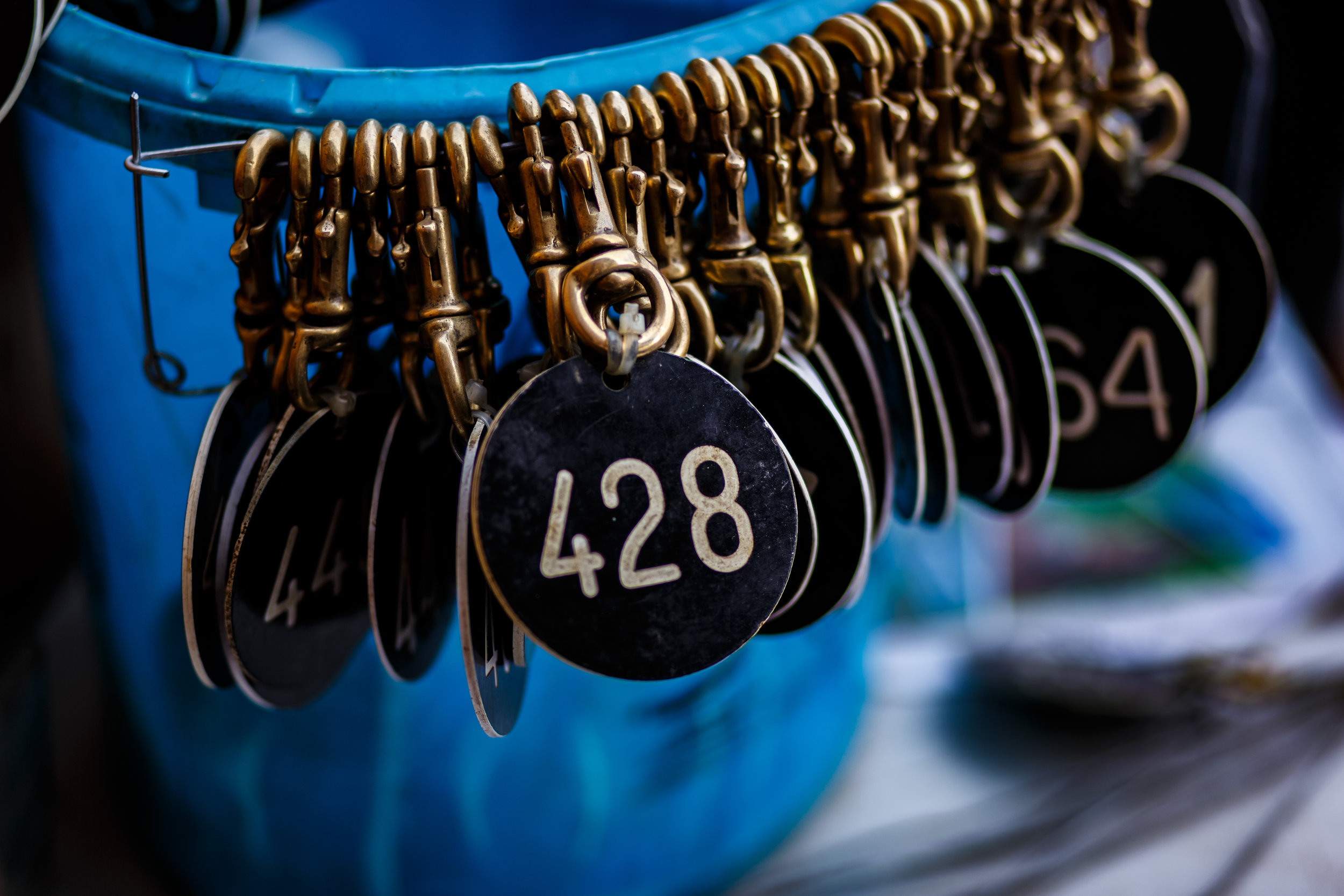Gavin Cromwell - the leading dual-purpose trainer
Words by Daragh Ó Conchúir
Gavin Cromwell has just arrived at Goresbridge for the Point-to-Point and National Hunt Horses-in-Training Sale.
This is off-Broadway fare, with a top-priced lot of €62,000 taken home by Charles Byrnes. Only a handful of Irish trainers are active. Most of the stock is bound for Britain.
It offers a glimpse as to why Cromwell is no longer a farrier but an eight-time Grade One and six-time Cheltenham Festival-winning trainer, with three victories in Prestbury Park’s signature championship contests.
He may now be officially categorised in a so-called Big Four in the Irish jumps game but is bemused by the association with Messrs Mullins, Elliott and de Bromhead given their relative rolls of honour. His market remains primarily at far lower levels.
Three days previously, Cromwell acquired three horses at the Tattersalls December Yearling Sale. Lest one has forgotten, the Meath man has saddled group winners on the Flat too, at two of the most exalted venues of that sphere, ParisLongchamp and Ascot. He has enjoyed the thrill of Royal success at the latter course twice.
Princess Yaiza scored in the Prix de Royallieu in 2018, nine months after Raz De Maree delivered in the Welsh Grand National. Raz de Maree was a 13-year-old gelding galloping over nearly 3m6f on heavy ground and jumping 18 fences (four were omitted). About three and a half years later, two-year-old filly Quick Suzy scorched to glory in the 5f Queen Mary Stakes on good-to-firm going at Royal Ascot.
The three yearlings were bought for an accumulated £108,000, a Ghaiyyath colt being the most expensive at £40,000. Later on, Cromwell would add another trio to his burgeoning army, costing a grand total of €49,000 between them. The €25,000 for Aspurofthemoment is his largest single outlay.
They type of horses he has bought over these few days not only magnify his achievements, and his talents, but offer a glimpse of his all-inclusive approach to training and sourcing, of his ambition and tireless endeavour. There is no pigeon-holing this guy. Juveniles, veterans, handicappers, elite performers, over obstacles or on the level. You have a horse with some ability, he will get it to win.
And while he has had some significant support from JP McManus in particular over jumps and Lindsay Laroche on the Flat, both relationships grew out of their attraction to his results and were cemented by continuing success thereafter. In the same way, he will train a couple of horses for Qatar Racing next season, having sold them one this year. These affiliations developed from the foundation stone of the entire operation: sourcing stock cheaply as most of his owners do not have deep pockets. If they are good, they are often acquired by people that do.
What being in Goresbridge tells us is that Gavin Cromwell is always on it, to use modern sporting parlance. He does not switch off. And the results speak for themselves.
How recently was Gavin Cromwell still a farrier? Many will be surprised to hear that he only finished “four or five years ago.” That’s after he had become a Cheltenham Champion Hurdle winner.
The 50-year-old is now a six-time Festival victor at Prestbury Park, with half of those successes coming in championship races, Flooring Porter’s Stayers’ Hurdle double arriving in the wake of Espoir D’Allen’s Champion Hurdle triumph in 2019.
His tally of winners over jumps and on the Flat continues to rise, while his numerous cross-channel raids have yielded 14 winners at a 23% clip last season in National Hunt and an even better percentage of 5/20 since the start of 2023 in the summer code.
This has been achieved within a clear business strategy that focuses on a sound financial footing while marrying that with a philosophy based on ambition, and a development of leadership techniques that have proven more essential as the operation has grown from his early days on a 14-acre greenfield site, to the 150 stables and state-of-the-art facilities on 80 acres at Danestown. That brings more staff, more owners, more suppliers. More demands.
So you develop a team around you. The likes of right-hand man Garvan Donnelly. Keith Donoghue, the jockey who helped revitalise Tiger Roll and Labaik in his days working for Cromwell’s former housemate, Gordon Elliott. Race planner, Troy Cullen. Kevin and Anna Ross, brought on board to oversee the purchase of more Flat horses, many of which have been sold at a considerable profit.
Being among the aforementioned quartet excluded from some races by Horse Racing Ireland as a strategy to increase opportunities for the rest of the trainers came as a shock. Not least because he has not had a Grade One winner in Ireland since Flooring Porter announced himself a star of the future in the Christmas Hurdle at Leopardstown four years ago. That was his fourth top-flight triumph and that tally has been doubled across the water at Cheltenham and Aintree.
For context, Willie Mullins saddled a world record 39 last season alone.
Cromwell should really be heralded as a poster boy for what is possible in what some observers have argued is an unproductive, overly polarised environment, unconducive to fresh blood breaking through.
While he would love a yard of Grade One horses and dreams of registering a maiden Group One, most of his stock comprises handicappers. Therefore, the selling angle is vital. The paradox of that model is he sees the negative impact that has had on the depth of the Flat game, as well as the National Hunt.
This all makes for a riveting conversation.
Given that there isn’t a category of race Cromwell does not have a horse or an owner for, talent acquisition is a round-the-clock consideration. And it is one of the areas he has had to outsource because of his expansion.
“Kevin and Anna Ross have been helping to buy the yearlings for the last season, and this season. That’s working out great,” he says and with good cause.
Among the selections last year are dual group-placed Fiery Lucy, who finished her season a slightly unlucky three-length fourth to Lake Victoria in the Breeders’ Cup Juvenile Fillies Turf at Del Mar. Mighty Eriu was sold to Qatar Racing after finishing second on debut and went on to be runner-up in the Queen Mary, Cromwell’s worst result from his three juvenile runners at Royal Ascot. And Chorr Dubh was sold to America for six figures after winning on debut at Gowran Park. That trio cost less than €80,000 between them.
Diego Ventura was more expensive, relatively, at €72,000 but that was at the Tattersalls Breeze-Up Sale in May. He won on debut two months later under Cromwell’s go-to Flat pilot, Gary Carroll, and was promptly sold to Wathnan Racing, transferring to the tutelage of Hamad Al Jehani in Newmarket.
“I’ve always bought all my own horses up to this but it’s very hard to find time to do everything, and then, of course, to try and find someone that you trust, so Kevin and Anna have been great for the Flat horses.
“I’m taking a run down here to Goresbridge today and it’s the lesser point-to-point horses but we have lots of lesser orders. Predominantly, it’s the lesser horses that we have.
“You’re constantly trying to think outside the box and trying to buy value, and trying to buy a horse that could potentially turn out to be a decent horse. You would always be trying to buy an unlucky horse. A horse that was second or third maybe, in some of those maidens, and the winner maybe made three or four hundred thousand. And maybe he had three or four runs, and it didn’t happen for him. Maybe he could have a fall mixed into the form.”
It brings to mind Emmet Mullins revealing in this publication last year that he always had an eye on strong finishers in point-to-point maidens. He prefers a horse galloping through the line in third to a winner hanging on. The market can miss a horse like that. When you don’t have a huge reservoir of funding, you have to be smart, identify a gap that few, if any, have noticed or have interest in.
“The other thing you have to do is, you have to take a chance. I would buy some of these horses on spec; find them and bring them home. I bought Will The Wise last year on spec, £95,000. It was as much money as I’ve ever spent on spec on a horse. But thankfully, I got someone to buy him.
“I suppose when things are going well, you can have the confidence to do that. You’ll find someone. It’s a little bit easier for me to say that than it is for a smaller trainer that has a handful of horses and no access to any owners. It is difficult but listen, I was that person one time. I remember buying a horse in Newmarket and he stood me 20 grand. I couldn’t find anybody for him, and I had to sell him to another trainer.”
But he kept going back. After stints with Dessie Hughes and Paul Kellaway, and at Flemington Racecourse, while he chased a dream of being a jockey, he took out his licence to train in 2005, having learned his trade as a farrier. Dodder Walk was his first NH winner, in Cork on April 7, 2007. Five Two broke the duck on the Flat at Dundalk on November 26, 2010. Balrath Hope bagged the Ulster Oaks two years later and Sretaw delivered a big pot with the Irish Cambridgeshire in 2014. Elusive Ivy won the JLT Handicap Hurdle and Mallards In Flight the Glencarraig Lady Handicap Chase.
By now, his services as a farrier were much in demand, with the high-flying Elliott a major client. As he notes himself, it is only until very recently that being the man that shod 2015 Gold Cup winner, Don Cossack wasn’t what people tended to mention when his name came up.
Having started with a barn for eight horses to train as a hobby, with an apartment above it that he lived in, Cromwell added a second for 13. The recession gazumped all progress but he would not be deterred. Picking up horses and making contacts brought better results. Further barns were built, housing 25, then 30 and then 50. An isolation yard was added also.
The five-furlong straight, uphill woodchip gallop has worked splendidly with the Flat juveniles ready, and while his jumpers will use it too, they are generally worked on the round, deep sand gallop complete with speedometer.
While the share in prize money is considerable, it is moving the Flat horses through the international market that really greases the wheels and facilitates the improvement of the amenities. It is a delicate balance, when you are hungry to climb the ladder and improve the quality of your string, but pragmatism ensures you are still in business next year.
“We’ve got plenty of yearlings this year and sold plenty of two-year-olds. I suppose it’s a business model that we’re buying them with the view to trading them. I have a few Flat owners, the likes of Lindsay LaRoche, who owned Princess Yaiza and Snellen, who won at Royal Ascot. Those horses are bred to race and bought to race. So that’s slightly different to the rest of the business model.
“We sold Mighty Eriu this year to Qatar and she stayed with us for a little bit. She went to Royal Ascot and I think we’re going to potentially have a couple of Qatar horses for next season. We have one three year old here at the moment for them.
“So some will stay in training, and then others are in training to be sold, whether they’re sold to existing owners, or maybe someone could buy them and they stay at the yard, remains to be seen. But it’s a business model, and it’s been working nicely. We’ve bought plenty of yearlings now for next season and hopefully they will work out.”
The prize money in Australia, Hong Kong and America puts a value, in particular, on a band of horse that cannot be replicated in Europe. So capitalising on big offers will always make sense but it does mean that the pool is thinning, in both codes, with many of those Flat horses having previously transitioned into NH athletes.
“I actually didn’t go to Newmarket Horses-in-Training Sale this year or last year. It’s so hard to buy those three year olds to go hurdling. It’s too expensive for what they are, for what we want them for. The Australian market is too good and lots of those international markets.
“We sent a few to Goffs Horses-in-Training Sale. They were looked at numerous times, and they all sold. They had won a few, but they were only at a level. We had two National Hunt horses at the sale, and they never got looked at once. It’s a world market (on the Flat), and they went to all different countries, and there’s no problem selling them. It’s a great trade. But it means we can’t buy off the Flat to go jumping or to have as good dual-purpose horses.”
Attending sales are about more than going with a shopping list.
“The lads who are getting on are the lads you’ll meet at the sales. You have to be buying your horses all the time. And sure you don’t know who you’re gonna meet. I seldom go to a sale that I don’t come home with a horse, whether I met someone and I got the horse to train, or I bought him.”
The future dividend of networking can be significant too because relationships are at the core of anything that thrives. Gavin Cromwell Racing is no different.
“You spend your whole time trying to surround yourself with good people and if you can keep adding to that, it makes everything work better, and it makes life a lot easier. Someone said to me one day, ‘You spend all your time trying to make yourself redundant.’
“The system is there, and the people are there to implement it. You’ve the 3Ds: decide, delegate and disappear. And I think sometimes, the hardest part of that is to disappear. But if you decide and you delegate, there’s no point doing them unless you disappear. You delegate, you have to pass on the responsibility, and the only way you’ll pass that on is to disappear. And if it’s not done right then, well then you’ve to go back to the start again. But if you’ve decided and you’ve delegated, you have to pass out the responsibility, and you have to do it with confidence. That’s what makes everybody grow.”
A really clever person knows what they do not know. And they go about ensuring that they acquire those skillsets or surround themselves with people that possess them. That’s how it has been with the management of people and Cromwell’s leadership.
“I suppose you learn from other people. I learned an awful lot from some of my owners, who are obviously very good in business, and chat to them. They pass on a lot.”
There have been some personnel additions in recent years that have been pivotal in the upward surge.
“Garvan Donnelly is my head lad/assistant trainer. He’s been a game changer for me, heading for three years now. He was head lad with Arthur Moor back in the day when Arthur was champion trainer. He was training himself. Thankfully, he came to work for us. I’ve Troy Cullen helping with the race planning and he’s been brilliant.
“Keith Donoghue has been a huge asset to the yard. Apart from being a brilliant rider, he’s a huge help to me with the day-to-day stuff, with the training and making plans. I don’t think there’s too many would disagree, he’s one of the best in the country. We’re very lucky that he’s with us.”
It is easy to identify now when the first real significant upswing in fortunes occurred. As happens so often, breeder, Gus Bourke only put Jer’s Girl into training because he could not sell her. It was a different ball game after she won a Listed juvenile hurdle in Aintree under Richard Johnson. Bourke was ready to cash in.
On the day she was declared to run in the Grade One Mares’ Novice Hurdle at Fairyhouse at the end of March 2016, JP McManus completed the deal. She got the new association off to the perfect start, nine days after her trainer had gone to Cheltenham to see Don Cossack and Bryan Cooper gallop to glory in the Gold Cup.
Cromwell had resisted the temptation to bring his stable star across the water and was rewarded, pitching the four-year-old in against the older novices to provide him with his maiden Grade One success. They repeated the trick the following month, this time beating the young boys too in cantering to a ten-length triumph in the Champion Novice Hurdle. All Barry Geraghty had to do was steer.
It prompted McManus to reward him with an increased patronage that has continued to this day. The first youngster they sent that summer happened to be Espoir D’Allen. He was the first five-year-old to win the Champion Hurdle in 15 years and his winning margin of 15 lengths was the widest in the history of the race.
The son of Voix Du Nord never ran again, killed after a freak accident coming back from the gallops as he began his build-up to the following season. It was a devastating blow but it was absorbed, even if it still makes Cromwell wince.
Flooring Porter – owned by a four-man syndicate from Galway, though the numbers in the parade ring when he wins suggest there are countless more tethered to his fortunes – went back-to-back in Stayers’ Hurdles in 2020 and 2021 and had the Grand National in his sights after a sensational victory in the Kerry National at Listowel, only for injury to intervene.
These are the vicissitudes of the equine world.
If Jer’s Girl catapulted him to a different plane, her conditioner struggles to identify when he felt that he was a 24-hour trainer.
“It was very gradual. I don’t think there was any one day that I woke up and said, ‘I can actually be a full-time trainer for the rest of me days.’ I started out as a full-time farrier and a part-time trainer, and then I kind of became more a trainer than a farrier but was clinging on to the farrier job for a number of years because I still hadn’t the confidence that this was going to stay working as well as it was, or I was going to grow any better than it was.
“I suppose eventually I just didn’t have the time to do any shoeing. It got to the stage that I couldn’t shoe my own.”
So when his last apprentice had completed his term, Cromwell officially left his profession of more than 20 years to one side. That apprentice is now his farrier.
So maybe that was when he finally made it, though as befitting the prototype of the Irishman absolutely terrified with the notion of anyone thinking they were running away themselves, it is not a term he would ever, EVER use to describe where he stands in the overall firmament.
In a way, the HRI announcement that he would be precluded from running horses in 60 races, along with Mullins, Elliott and Henry de Bromhead was a PR boon, placing him officially among a grouping of the best in the jumping game.
While he has brought about incredible growth, and the quantity of winners has increased exponentially, hitting a career high 72 over jumps in Ireland last season, in terms of prize money and calibre, he is in the same sort of sphere as Joseph O’Brien, who operates a far smaller jumps team, and only edged ahead of the Carriganóg handler into fourth on the trainers’ table for the first time in 2023/24.
Indeed, since Cromwell’s last Grade One on native shores secured by Flooring Porter four years ago, Shark Hanlon, Noel Meade (2), Paddy Corkery, Barry Connell (2), O’Brien, Emmet Mullins, Martin Brassil (3), Jimmy Mangan (2) have scored at the highest level in Ireland.
Given his journey, no one is more aware of the challenges faced by the so-called small man battling for even a tiny piece of the pie. Being penalised for navigating those challenges so well seems bizarre but Cromwell points out that it isn’t really about the trainers..
“The point that everybody is missing is that they’re punishing the owner. I have so many small owners with low-budget horses. I’m here in Goresbridge today and if I come out with a horse, it’s going to be a horse that’s maybe placed in a point to point or placed somewhere. It’s low level stuff. Why are you punishing that man? Or the group of lads that put a syndicate together and I have lots of syndicates.
“I’ve 150 stables because I’ve chosen to keep building these stables, and keep going to these sales, and keep buying the horses and trying to find an owner for them. I’m hungry enough and work hard to do that. I’ll put my hand up at the sales and the bill will be at home before I’ve left. It doesn’t mean I have a yard full of superstars or big owners.
“I have great owners, many in it for the first time. I have a couple of horses you would be hoping might be competitive in a Grade One. That’s it. There’s some really good trainers out there who choose not to have 150 jumpers there and they have access to really big owners and more Grade One horses and fair play to them.”
He believes that providing more opportunities for lower-grade horses, particularly on the high-profile days, where the prize money is better and the RTÉ or TG4 cameras are in town, is the way to help Irish trainers, and particularly racing’s key constituents.
“I feel they need to change stuff with the system to get the horses competitive earlier and to look after the bottom end of it. Have more racing for the lower end. And have an 80-102, or as they’re all in tens from next year, an 80-110 handicap hurdle at a big festival, like they have the 102 hurdle on Thyestes day. Have a low-grade handicap or some type of race for the small man that Willie or Gordon are not going to have horses for. There’s a good chance I would have something in it because I do have them horses, but give the small man a day out on the big day.
“There’s a huge emphasis on the trainer and the last person to get a mention is the owner, if he gets a mention. It’s the Willie Mullins camp, the Gordon Elliott camp and they have lots of different owners. There should be far more emphasis on the owner. The owner is number one.”
It’s a good point, well made.
The truth is, Cromwell just wants to get on with doing what he has always done. Train winners at whatever level is suited to the animals he is responsible for. And while he would like more top-tier horses, he acknowledges that the quality has improved significantly along with the numbers.
“We don’t have too many empty stables anymore. When you’re doing the entries now there’s, there’s not as many to stick into the 80-95s as there used to be, so the quality is getting better. And sure, I think if you were to ask any trainer, it’s not more numbers that you want, it’s better quality. But sometimes you have to go through the numbers to try and find them. And we cater at all levels, and all sorts of budgets.”
Inothewayurthinkin, a facile Kim Muir victor at Cheltenham, who followed up with a convincing triumph in the Grade One Mildmay Novices’ Chase at Aintree, resumed his campaign this term in the John Durkan Chase last month.
Considered by many to be the best chase ever run in Ireland, it was certainly a case of being plunged into the deep end and while well beaten by Fact To File, there were positives.
“He jumped very well. It was the big concern. Last year he was a bit scratchy. When he gained ground on the flat he’d lose it at a jump, just jumping a bit high and slow. Two and a half miles in a properly run Grade One, his jumping held up. He wants further and he got a bit tired but I’d be happy enough.
“He has an entry for (the Savills Chase) at Christmas there, and he’s up to three miles there and at that stage, we’ll know whether we’re good enough (for a tilt at the Gold Cup) or not.”
Only By Night, Sixandahalf and Hello Neighbour are among the younger talents for which various dreams of more exalted targets are alive, though the real tests are still to come. Only By Night is a point winner, a listed bumper winner and has black type over hurdles but as Cromwell suspected, she is a different animal altogether over fences, bolting up in a hot Grade 2 mares’ novice chase at Punchestown earlier this month.
That earned her quotes for the Mares’ Chase at Cheltenham and Cromwell already has the champion in that sphere in Inothewayurthinkin’s full-sister Limerick Lace, while Brides Hill is another with the same aim. Stumptown and former Albert Bartlett victor and Grand National runner-up, Vanillier are two other more established citizens that will have lofty goals as the season reaches its crescendo.
Either way, Gavin Cromwell’s eye will always be on the ball in a sport and industry that operates 365 days a year. Training winners, no matter the standard, is the objective.
So far, so very good.
Point-to-Point racing and its role in developing jumpers
Article by Daragh Ó Conchúir
There has always been something special about a well organised point-to-point.
It is social, in the truest sense. A communal gathering of like-minded people, with a love of rural pursuits and lifestyle.
It is racing at its purest too, founded on the genesis of steeplechasing in the Irish county of Cork in 1752. That was when Edmund Blake and Cornelius O’Callaghan chose to resolve which of them possessed the best steed by racing the four and a half miles from Buttevant Church to its Doneraile counterpart. Steeple to steeple, taking whatever route they saw fit and clearing whatever obstacle was in the way. Naturally, the money was down to increase the stakes.
Good horses often emerged from this sphere, with Tom Costello a legendary source of Gold Cup winners, but that wasn’t the raison d’être. Pointing was a leisurely pursuit. There was no competition for National Hunt trainers when it came to the acquisition of stores or younger jumping stock.
The landscape began to change with the introduction of an autumn point-to-point season by Irish authorities to make up for the fixtures lost by the outbreak of Foot And Mouth in 2001 but the last decade has seen an increasing commercialism that has altered the face not just of point-to-pointing, but of racing under Rules.
This has only accelerated by the reduction in availability of the good Flat handicappers, now flowing to jurisdictions such as Hong Kong and Australia with mammoth prize money justifying the eye-watering sums that National Hunt people could not justify.
There is always a risk with buying thoroughbreds but for end users, that is alleviated somewhat when there is form with proven depth. Of course there is a premium on that.
The results speak for themselves when it comes to the question of whether or not the sector is developing jumpers to a requisite level. Just look at the recently concluded Cheltenham Festival, where of the 27 races, nine were won by graduates of the point-to-point circuit – eight from Ireland and one from Britain. That latter success was in the point-to-point feature, the Foxhunter Chase, as Sine Nomine repelled the strong raiding challenge for Fiona Needham, her father Robin Tate and jockey John Dawson.
What is notable though is the high level of achievement. Of the other eight graduates from the point scene to score, five did so in Grade 1s: Slade Steel (Supreme Novices’ Hurdle), Ballyburn (Gallagher Novices’ Hurdle), Fact To File (Brown Advisory Novices’ Chase), Jasmin De Vaux (Champion Bumper) and Stellar Story (Albert Bartlett Novices’ Hurdle). There was a clean sweep of placings by ex-pointers in the Brown Advisory and Albert Bartlett.
This is not anything like a one-off, of course. When Colin McKeever’s Loughanmore winner, Ballyburn, sauntered to a 13-length triumph in the Gallagher, he was the fourth alumnus of the sphere to land the spoils in that particular Grade 1 in five seasons. Slade Steel was the fourth to bag the Supreme in the same period. That’s Constitution Hill, Shishkin, Envoi Allen and Bob Olinger we’re talking about between the two.
There is depth in terms of the handlers producing these talents also. Donnchadh Doyle, whose brothers Seán and Cormac are established providers with the likes of Monkfish, Holywell and Bravemansgame included on the roll of honour, was the only provider to have multiple winners, having guided Fact To File and Stellar Story to successes at Bellharbour and Castlelands.
Apart from the aforementioned McKeever, Pierce Power, Colin Bowe, Euguene O’Sullivan, Stuart Crawford and Warren Ewing had the satisfaction of seeing former charges deliver on the biggest stage.
It is significant too that the octet won their maidens at eight different venues, illustrating the calibre of the tracks.
The growth in the sector and the unarguable evidence that this system is working is seen in figures provided by Irish point-to-point website, p2p.ie. If we take the past 15 completed jumps season from 2008/09 to 2022/2023, we see a progression from when graduates won 725 track races, eight of which were at Grade 1 level, to a stunning 1570 winners and 27 elite successes. The total number of black-type winners increases from 39 to 98.
Since 2015/16, the number of winners has only dropped below 1400 once, and that was in the Covid-impacted 2019/2020 term.
While the number of winners has largely been consistent – 1718 in 2020/21 was a high-water mark – the quality continues on an upward climb, with 27 Grade 1s secured by Irish point products in two of the last three seasons with completed figures.
And that is why the prices continue to rise. The record for the most expensive point-to-pointer was set in November 2020, when JP McManus shelled out £570,000 for Jonbon at the Goffs UK Sale in Yorton after the full-brother to multiple Grade 1 winner Douvan had cantered to a 15-length triumph for Ellmarie Holden, Paul Holden and Michael Shefflin.
At the Punchestown Festival Sale 12 months ago, it was a mare that attracted the biggest bonanza, as Mags O’Toole spent €500,000 on behalf of Brian Acheson’s Robcour ownership banner for Qualimita, who had dotted up in a Fairyhouse maiden by 30 lengths for Walter Connors and Bowe.
A highest price for a British filly pointer was set last May, when Saunton Surf was sold in May for £175,000 by Brad Gibbs to Warren Greatrex at the Goffs Spring Sale in Doncaster.
That was matched last December, as Just A Rose was bought by Tom Malone, for British champion trainer Paul Nicholls, from Tom Ellis and breeders Sarah and Nigel Faulks. The same buying combination snapped up Will Biddick’s facile Badbury Rings victor, No Drama This End for £160,000 at the Cheltenham Festival Sale in March.
Meanwhile, Eddie O’Leary signed a chit for €265,000 at the Tattersalls Ireland Derby Sale last June for a store that was heading in Gordon Elliott’s direction and in all, 33 horses sold for €100,000 or more at that auction, making it the third best result in Derby Sale history.
And remember, a Camelot half-brother to Altior realised a staggering €155,000 at the Tattersalls National Hunt Sale in November 2019, purchased by former Republic of Ireland soccer international Kevin Doyle from Coole House Farm on behalf of Paddy Behan Jnr. It was the highest price paid for a foal at the sale for 12 years and the third highest in its history.
While the most recent auctions might finally be suggesting a slight correction, Irish producer and trainer, Liz Doyle wasn’t far wrong when she described the point-to-point sector as ‘pandemic and recession-proof’.
Jerry McGrath is relatively new to the scene as a bloodstock agent, a role he took up upon his injury-enforced retirement at the beginning of 2022. But the Cork native had long been tasked by his boss Nicky Henderson with keeping an eye on the Irish point-to-point circuit during his time at Seven Barrows, during which he rode two Cheltenham Festival winners.
Love Envoi provided him with his first Cheltenham triumph as a buyer. Jango Baie is a Grade 1-winning novice hurdler this year and Jingko Blue is another youngster acquired from racing through the flags that has made a good transition to the track.
“It’s been well documented; it’s harder to get hold of these highly rated, staying flat horses now because there’s such a market for them abroad,” says McGrath. “Because that has happened it has narrowed where you get your jump horses from and I think that’s why maybe the point-to-point thing has come so strong.
“Of course, it has been massively influenced by the point-to-point handlers themselves. I have the utmost respect for those lads. They go out there, they put their money on the line, they invest in horses that they like at the store sales. We’ve seen in the last three or four years, they’ve been outbidding plenty of trainers.
“When you look at it like that, it sounds a bit bonkers that the point-to-point men are outbidding the end users, bearing in mind they have to prove the horse’s ability, with the hope that the end user comes back and buys it as a winning point-to-pointer.”
This is why not every trainer is a fan, as they are now priced out of the market at both potential entry points –sales for stores and pointers. But in an open market, those willing to risk the most, make the most. The vital element to it all is the emergence of talented animals on a consistent basis.
The handlers are clearly discerning in their sourcing too. While there are fashionable stallions, the point graduates that delivered at Cheltenham came from a variety of sires: Flemensfirth (Ballyburn), Shantou (Stellar Story), Poliglote (Fact To File), Telescope (Slade Steel) and Tirwanako (Jasmin De Vaux) were the Grade 1 performers, while Gamut (Corbetts Cross), Milan (Better Days Ahead) and Saint Des Saints, whose three winners at the festival included Sine Nomine, completed the crop.
This is why McGrath’s priority is the model rather than the page, although pedigree has to be taken into account.
“You can have a potential superstar but if he’s a terrible mover, his longevity is going to be very short. It’s a bit like cheap speed, the two-year-old that’s going out very early. You might win a two-year-old maiden at the start of the year but will you be there at the end of the season competing in group races? Probably not. So you do have to have an athletic horse.
“Temperament definitely comes into it but at the same time, these are young horses, and their temperament can be managed, especially if they go into the right hands. If you’ve got a hot and buzzy horse, it doesn’t mean they’ll be hot and buzzy in two years’ time.
“Athleticism and movement is the big thing for me. And you have to have a bit of pedigree. If they’re not bred to be a good racehorse, why would you be surprised they’re not a good racehorse?”
Pat Doyle is one of the enduring characters of the Irish point-to-point sector, having been among the pioneers for using it to sell four and five-year-olds with form before the likes of the Wexford crew of Bowe, Denis Murphy and the unrelated Doyle brothers raised the bar. He kept up with the evolution though and had at least ten graduates running at Cheltenham. The majority of them were trained by Mullins, which is no mean imprimatur.
It is 50 years this year since Doyle broke future dual Champion Hurdle winner Monksfield as a two-year-old. Later on, he pre-trained Minnehoma for his good friend Roddy O’Byrne to sell. Minnehoma followed Cheltenham success with a famous Grand National victory in 1994.
Bob Olinger, Appreciate It, First Lieutenant, Shattered Love, Colreevy, Readin Tommy Wrong, Bacardys, Commander Of Fleet, Champ Kiely and Brindisi Breeze are just some of the other Grade 1 and Cheltenham winners to have emerged from his academy.
The very latest off the production line, Ballycahane winner In The Age, sold at the Cheltenham Festival Sale for £100,000 to Ryan Mahon for the leading British trainer at the festival, Dan Skelton. The headline act at this boutique offering was the purchase of Echoing Silence by Peter Molony from Sam Curling and Correna Bowe for £410,000, to be trained by Henry de Bromhead.
This sale has produced the last two Gold Cup runners-up, Bravemansgame and Gerri Colombe, while three of its graduates from the 2023 sale participated in the Champion Bumper this March, including the runner-up Romeo Coolio and third-placed Jalon D’Oudairies.
“The biggest trick is selling them to good trainers,” Doyle relates. “I’ve been very, very lucky with Willie Mullins, Henry de Bromhead and fellas like that buying horses off me that turned out to be successful. I’m an open market for anyone to buy horses off but Willie Mullins (had) seven or eight horses I sold him running at Cheltenham.”
For a long time, Doyle and his fellow Irish handlers had this niche to themselves. The likes of Sophie and Tom Lacey were trading but the point-to-point arena remained Corinthian in spirit and action.
The old traditions are gradually being cast off with the likes of Gold Cup runner-up Santini (Ed and Polly Walker) and Ahoy Senor (Melanie and Philip Rowley) having emerged and with handlers of the calibre of Tom Ellis and Gina Andrews, Bradley Gibbs, Fran and Charlie Poste, Josh Newman and Kayley Woollacott and Will Biddick in the vanguard of those guiding young talent.
Tom Lacey is now training under Rules, but having produced dual Champion Chase winner Energumene, Sebastapol (this pair won two divisions of the same open maiden at Larkhill in January 2018), Blackbow, Kimberlite Candy and the most expensive British pointer ever Interconnected (sold for £220,000 after winning at Larkhill in a month after Energumene and Sebastapol), remains an ardent advocate of the division on his native shore.
“I think it’s irreplaceable. I don’t believe there’s any better grounding for jumps horses than point-to-points,” Lacey states definitively.
“Ten years ago you could send a well-educated horse 80 per cent fit to an English point-to-point and you’d win it stylishly. Now you need to be well educated and be a 100% fit. There’s plenty of depth there now. There’s more and more people doing it and you’ve got plenty of good, sharp lads doing it.
“I think there’s still an element where the British point-to-point programme needs to be tweaked… For example, this is the time where your four-year-olds start coming to fruition. You know where you are with them, you’re ready to run and this weekend they’ve got a five-year-old and over maiden point-to-point. Well that’s just stupid.
“They have also introduced these point-to-point Flat races. The issue I have with those is they have diluted the maidens. They have taken away a lot of the young horses which would traditionally have run in a point-to-point. And now the people that don’t want to be commercial fiddle around for a season running around in these point-to-point Flat races and to be quite honest with you, they’re dirt. You won’t sell a horse out of one of them. They should never have been allowed to come in.”
Does it damage the reputation of the product?
“Yes it does. All of the boys operating on a commercial basis won’t entertain them. If you want to sell a horse, it needs to be able to jump 16 or 18 fences and do it nicely.”
McGrath has plenty of praise for the British scene.
“There is talent emerging and we’d love for it to be stronger again but sometimes, people struggle to get a grasp on the English form, whereas a lot of people know the Irish point-to-point handlers better, they know the tracks better and can get a better handle on the form but at the same time, it doesn’t mean that there’s not lots of good horses come out of English point-to-points.
“I think sometimes there can be a bit of value and when you are buying pointers, it is important to remember that it is budget driven and you don’t always have to shell out the big numbers to buy a good horse.”
Lacey and Doyle are in agreement about the importance of producing a racehorse over a sales horse. It is the only way to ensure longevity as a commercial entity.
“There’s no point trying to sell a mediocre horse for a lot of money ‘cos you’ll only ever do it once,” Lacey declares. “We had a horse won at Dingley Point-To-Point (by 16 lengths) called Space Safari. Bryan Drew was there that day and rang me up that evening and said, ‘What do you want for that horse?’ I said, ‘Bryan, I can’t sell him to you. Don’t ask me any more questions but I can’t sell him to you.’ And that was because I wanted him to come back and buy another one.”
“I don’t want to sell a bad horse,” is the Doyle mantra. “I had a few horses in Cheltenham at the (February) sale. They made good store prices, but I explained to the guys that bought them, ‘This is what these horses are capable of doing. They’re good horses. Are they Saturday horses? Maybe not, but they’ll win races.’”
When a vendor is known for this sort of honesty, buyers take note when he vouches for a horse. Doyle’s word was enough for Willie Mullins to acquire Appreciate It, Champ Kiely and Readin Tommy Wrong despite them failing to win their maidens but they are all Grade 1 victors now.
And of course, Nicky Henderson bought Constitution Hill because of his respect for Warren Ewing and his former No 1 jockey Barry Geraghty, who had sold him future Gold Cup winner, Bobs Worth. Constitution Hill finished second in his point at Tipperary, after making a terrible mistake at the last. What’s more, the physical exertions left a toll. It was only the word of men he knew and trusted that maintained Henderson’s interest. As we know, the Blue Bresil seven-year-old has yet to lose a race on the track and sauntered to a Champion Hurdle success last year before illness ruled him out this time around.
Some horses are just slower developers. Grand National winner Corach Rambler, who ran a stormer to be third in the Gold Cup and is a short price to back up his Aintree heroics, took five attempts to win a point for John Walsh, finally getting his head in front in a six-year-old’s and older maiden at Monksgrange in September 2020. So a relationship and trust with the vendor is critical.
“A very good example was Love Envoi,” McGrath explains. “She didn’t show herself very well on the day and there was a minor vetting issue but Seán (Doyle) assured me it had not stopped her and it would have surprised him if it ever did cause an issue. We paid thirty-eight grand for her and she turned out to be a Cheltenham Festival winner, a multiple black-type filly and a Grade 1-placed filly. That was a perfect example of trust.”
It is noteworthy how often Mullins’ name crops up in the course of these discussions, reflective perhaps of his dominance. What is interesting is how often he gets his business done privately, via his agent, Harold Kirk, with Pierre Boulard his man on the ground in France when it comes to acquiring the talent emerging from French three and four-year-old hurdles. Lacey is adamant that this, more than anything else, is why he is the leviathan of jump racing.
“People say, ‘What’s Willie Mullins doing that allows him to get all these best horses?’”, the Cottage Field Stables conditioner begins.
“If you’ve got a good horse and you genuinely believe it’s a graded horse, if you ring Harold Kirk and say, ‘Harold, I’ve got one for you,’ he will say, ‘What do you want for it?’ You’ll name your price and he will say, ‘I’ll have it.’
“That is what Willie Mullins does differently. He doesn’t say, ‘I’ll come back to you in a week’s time.’ The vet’s there within the week and they just get the business done. They do not sit on the fence and allow horses to be sold from underneath them. That is one of the things he does that no one else does. They are so straightforward.
“He’s got Harold Kirk working from November onwards with all the point-to-point handlers working in Ireland, with the point-to-point handlers in England. He used to come over and see all mine before Christmas, see which ones he liked, asked me which ones I liked and if they did what I expected them to do, I rang him up and said, ‘Harold, you should buy that horse.’
“‘I’ll have it.’
“That’s what Willie Mullins does that no one else does.”
Horse Racing Ireland has intimated a willingness to develop a programme of bumpers and hurdles for three-year-old store horses, while there is a programme of junior NH hurdles in Britain, though for paltry prize money.
This comes on the back of the success of the French programme of three-year-old hurdles that is backed with significant prize money by France Galop and is producing major talent. The first of the year was held at Compiegne on March 5, with the connections of Willie De Houelle landing €27,140 for a four-length triumph, the total prize fund amounting to €59,000.
The Beaumec De Houellle gelding is trained by Arnaud Chaille-Chaille, who also was responsible for the sire winning at Grade 1 level. His best graduate, however, is Galopin Des Champs, who won a four-year-old hurdle at Auteuil on debut before relocating to Ireland and becoming a two-time Gold Cup hero.
McGrath has a number of Gallic contacts and sourced the highly promising juvenile, Sir Gino for Henderson from an April maiden at Auteuil. He is a huge fan of a system that also produced the new Champion Hurdler, State Man.
Doyle has reservations about racing moving in this direction though concedes that he would get involved in two-year-old sales if they were to come on stream.
For his part, Lacey believes that this method, while suitable to French-breds, is not necessarily transferable.
“I’d be very old school,” says Lacey. “I think we are all expecting too much too soon from a lot of these young horses. The powers that be want us to follow the French model with Irish pedigrees. We’re breaking a lot of horses at two, turning them away, bringing them back at three and turning them away. They’re still not ready. I don’t know if it’s the breed or the way we produce them or the way we train them or what, but our horses just don’t come to hand like they do in France.”
And you have to do right by the horse.
“Course you have. But when Energumene was here, the ease with which he did everything was astonishing. The gulf between a good horse and a Grade 1 horse is vast. You see it on the gallops, it just floats everywhere. Everything is so effortless.”
He jokes that he had to buy a lot of stores to find that Grade 1 winner – to be fair, Energumene is a six-time Grade 1 winner – but that is the role the handlers play, taking on risk, filtering the wheat from the chaff.
“They go out, they put their own money on the line, they buy these horses as three-year-olds, they take all the risk. They break them. They canter, they school, they gallop the horses, they run the horses in a short space of time. Ideally they like to sell them as four-year-olds, sometimes they carry over till they’re five-year-olds. The good ones go on and make a lot of money and a profit, but there’s an awful lot of horses don’t even see the track, they don’t make the grade. And there’s plenty ones aren’t as good as they want them to be and if they’re lucky, they wipe their faces with them. That’s why they need the big priced ones because they’re covering the cost of the ones we don’t see or hear about.”
High risk, high reward, providing the ultimate quality control service.
Still special.
Emmet Mullins - the Irish National Hunt trainer who has had no shortage of success - a common trait in the Mullins clan!
Article by Daragh Ó Conchúir
Emmet Mullins possesses the sense of mischievousness that is common in many of the Mullins clan, and there are times when one wonders if it might be a contributory factor in his approach to training racehorses. Or at least his race planning.
We know from a significant sample of more than eight years as a trainer, that Mullins doesn’t throw darts without having given them due consideration. It’s just that his way of getting to the double is more Mensur Suljoviç than Michael van Gerwen. Convention is a constraint he sees no sense in burdening himself with.
So, it is not just plucking outlandish plans out of the ether. That would be idiotic and Mullins is no idiot. He is not unaware that he might be doing something others would not consider however, and when he delivers with an apparently off-kilter plot, he most definitely gets a kick out of it.
Examples of eschewing custom? Landing a listed three-year-old fillies’ hurdle race in Auteuil in 2019 with Fujimoto Flyer, acquired as a yearling on a trip to Japan two years previously. Scoring in a Grade 2 three-year-old hurdle race at the same venue last year with McTigue.
Winning a Grade 1 novice chase at Punchestown last April with Feronily, a horse having his second ever run over fences, just a month after shedding his maiden hurdle status, having been given his debut over both national hunt disciplines at graded level. That elite Punchestown triumph was less than five months removed from the Getaway gelding winning a point-to-point on his first ever public appearance at Rathcannon.
How about preparing ten-year-old The Shunter to bag the £103,080 first prize in the Cesarewitch at Newmarket last October? In March 2021, the same horse plundered a £100,000 bonus on offer for any winner of the Morebattle Hurdle that subsequently won at the Cheltenham Festival, doing so over fences in the Plate.
And then there’s capturing the Grand National with Noble Yeats in 2022, the first seven-year-old to be victorious in the Aintree feature since Bogskar, 82 years previously. And that came just 14 months after running in a bumper, 13 from obliging in his maiden hurdle.
For the most part, these aren’t campaigns his uncle Willie would consider and he is the most successful trainer in jumps racing. That said, when it comes to campaigning internationally at least, Willie has been all over the world and taken a punt in places like Nakayama and Merrano, and his own father Paddy (Emmet’s grandfather) did it before him, winning the $750,000 Grabel International Hurdle at Dueling Grounds – now Kentucky Downs – in 1990.
So there is a bit of nature in the ambition, the refusal to be hemmed in by the norm. He’s even had a runner in an Irish Derby, legging up Rachael Blackmore on King Of The Throne in 2020. But certainly, he has taken pioneering thinking to another level. It is his oeuvre. It takes a lot of confidence but the self-assurance is well placed. The CV tells us the methods produce results at a sustained and very exalted level.
For all that, and despite an average strike rate of around one in five over jumps in Ireland since he began in 2015, 28% over jumps in Britain over the same period (four from six at the time of writing this season alone) and a career high eight winners on the flat in Ireland this year (15% SR). Success for the Closutton 34-year-old – his 30 boxes are located at the HQ of his father, George’s equine transport business and next door to the gallops used by Uncle Willie to condition his legion of champions –is primarily about getting horses sold.
Sometimes they stay in the yard, which is the case if JP McManus gets involved as he has done on a number of occasions with The Shunter, Filey Bay, So Scottish, Corbett’s Cross and Feronily, and with Noble Yeats after the Waley-Cohens acquired the subsequent Grand National hero.
Most of them don’t though, particularly the flat horses, with a global market. Of the jumpers, McTigue is one of the more recent to have been bought to race in America.
In an interview in last year’s Irish Racing Yearbook, Mullins said he wasn’t good enough to be a jockey, even though he was a Cheltenham Festival winner in the Martin Pipe Conditional Jockeys’ Hurdle on Sir Des Champs for Willie in 2011.
He won a graded novice chase on the same horse at Limerick the following December and then two years later at the same meeting, was entrusted with the responsibility of steering Faugheen around in a graded novice hurdle. But he couldn’t see himself having enough of those sorts of days.
“I didn’t want to be mediocre. Move on to the next thing and do better,” he explained in that feature.
So he retired at 24, just as his younger cousin David did, having won a Grand National as a teenager. They know their own minds, the Mullins boys.
That independent streak is evident in his second career. Being given the responsibility by Willie of travelling with Blackstairmountain to Japan and overseeing the eight-year-old’s preparations prior to landing the valuable Nakayama Grand Jump planted the seed for training, as well as leaving a very positive impression of racing in the land of the rising sun.
He knew he wasn’t going to be champion trainer but given his disinterest in being a journeyman, resolved to operate commercially and improve the quality while he could.
Making money on a horse is success in his eyes, as evidenced when in the aforementioned Irish Racing Yearbook feature, he posited that saddling a two-year-old to score in an auction maiden on the flat at Gowran Park was arguably his most important winner of a year that also included Noble Yeats’ Liverpool romp.
“Grand National prize money wouldn’t get you a deposit on a house,” he reasoned, referring to the filly’s subsequent sale.
Asked now to sum up his model, he uses one word initially.
“Flexible.”
That, as they say, is an understatement.
“It was always to buy and to sell. Try and advertise your horse and sell it on for a profit. You’ve a lot of advantages with the surname Mullins but there’s a downfall with the selling part. I think most of the market would feel if Willie doesn’t buy it, it’s no good. That’s a drawback. It’s tricky.”
But it’s gone well. He would like to retain the calibre of horse, but it is not at the top of the list.
“I want the quality of the horses to be as high as possible but I don’t think I’ll ever go down the road of too many horses. I’m happy enough with the workload that I have. I went to Kentucky in September and October for the guts of five or six days each time, which you could never do if you had too many horses. There’s a good team at home but the bigger you get, no matter what systems you have in place, the more diluted it gets, I feel.”
As for being hands-on, he says: “I like to know, but I like to delegate. If I’ve all the right information I can make the decisions.”
He only rides work now when they are short of bodies, but is fortunate to have eight full-time staff, while his number one jockey, Donagh Meyler arrives three times a week.
He has just resurfaced a five-furlong gallop he had installed originally in 2018, and describes his method of conditioning as interval training.
“All I know really is Willie outside the back door of our house. It’s all I’ve seen and it’s a good model to be working on.”
While the conditioning, fitness and schooling aspects are imperatives, they are useless without the raw material and it is here that Mullins seems to really deliver at an incredible level for a small-scale operation. He is very clear about what he is looking for when making acquisitions.
“When it comes to horses in training, it’s when they hit the line. There’s nothing worse than something tying up that might fall across the line and hold on to win. I would definitely be waiting for the horse in third that was too far back and flew home and ran through the line. I’d value him more than the horse that actually won but the market might consider the winner the best horse. There are plenty of different factors gone into where each horse was but horses that run through the line, there’s another day in them.
“With unraced horses, I suppose it’s a lucky dip but if they can’t walk, they can’t gallop. It’s all about the action. When you’re looking at horses that ran, the page is 90% irrelevant because they’ve either outrun their page or underrun it and there’s probably more underrun their page than outrun it. Once there’s black and white form, the page drops way down the list. But with unraced horses, it’s one of your only markers. You’ve got your conformation and pedigree and you haven’t much else to go on.”
Paul Byrne is a key investor, a friend of cousin Patrick (son of Willie), who clearly liked what Emmet Mullins was doing and whose light blue colours have become very recognisable on the likes of Feronily, Corbett’s Cross and The Shunter prior to their sales to McManus, as well as Slate Lane, among many others. Meyler is a key contributor too, obviously.
“We’re on the same wavelength I think,” he says of the experienced pilot. “Sometimes I mightn’t say much and I think I’ve said what needs to be said. If you’re not on the same wavelength, the jockey hasn’t got it. That’s my fault. It hasn’t been communicated the right way. With Donagh, we’re on the same wavelength and a facial expression could say as much as a word.
“McTigue in Auteuil, I walked the track with him [Meyler]. Don’t think he’d ridden there before. I’d won there with Fujimoto, had ridden there and we’d been watching Willie’s horses win there over the years. I told him how I would ride the race, and hurdle by hurdle it was just textbook, following the conversation we had the whole way around.
“Once we come out after getting the saddle, I ask him about the race. I might have my homework done but I want to see what he says first anyway. Nine times out of ten, we come up with a plan together. A few times, I throw a spanner in the works, like with Slate Lane in Haydock when I say, ‘We’re gonna make it today.’
“Donagh thought we’d be switching off as usual, down the paint, but I just thought there wasn’t much pace in the race so I said, ‘No. Line up wide. Go with them. If they’re going too hard, you can always sit in behind them. If you’re going too slow, you’ll get a freebie up front. It’s up to you to figure it out from then. I just wanted him to have those options rather than being locked in a pocket in behind if they were going too slow. But the main thing is we are on the same wavelength.”
When we speak, Slate Lane has just delivered on another target, his fourth consecutive triumph, bagging the £71,188 first prize of that premier handicap at Haydock he has referred to. It is bittersweet though as, barring a miraculous recovery from a very bad tendon injury suffered at some point during that race, he won’t compete again.
“I don’t know how he got to the line. Fifty per cent of the tendon is gone, into the tendon sheath and the big worry with that is infection. He’s in a cast now so as not to put the weight on it. The BHA vets were very good, flushed it out and gave him antibiotics on the racecourse and he went to Leahurst (Equine Hospital in Liverpool). It’s fairly certain he’ll never race again but it’s good news that he avoided the infection and saving the horse was the most important thing. With tendon sheaths it’s often 50-50 whether you’ll survive it because of the risk of infection.”
It is a reminder that even when things are going outstandingly well, in racing, above all other pursuits it seems, the leveller is just around the corner. Only the day before, Jeroboam Machin won a Fairyhouse bumper on debut. He too suffered a nasty cut on his tendon, a bigger one than suffered by Slate Lane but not as deep. It will sideline the youngster for some time and there is a double whammy in terms of a potential sale but he should hopefully return to the track at least.
Some were talking up Slate Lane as a potential Stayers’ Hurdle candidate, cognisant of Mullins’ propensity to press fast forward with his neophytes but the intention had been to stay in novice company and to see just how far up the ladder the five-year-old son of Ask could go.
He only had him six months, and though there were three underwhelming performances on the track for Paul Hennessy, the third had been an improved sixth in a two-mile Gowran Park maiden hurdle in March though that ended in disqualification when jockey Niall Prendergast weighed in incorrectly. That actually brought Mullins’ attention to him however, and when he delved a bit deeper to look at his third-place finish in a Moig South maiden point, the manner in which Slate Lane finished strongly was enough for him to press the button.
“He flew home. I know he finished third but he was the horse to buy out of the race. There were no hiccups from then. We were probably on the mark after Newton Abbot but it was 75 days out to the race. As it transpired, the race didn’t fill and he’d only have been a pound or two out off 113 but you couldn’t take that risk and you’d have been longer again out. So in between Newton Abbot and Haydock, we took in the (Corinthian Challenge) charity race at Leopardstown (which he won) to keep him ticking over. Michael O’Neill, who won on him, comes in to ride work for us a good bit.
“Haydock wasn’t mentioned until after Cartmel but first, it was Cartmel for the sticky toffee pudding. That was the big draw! As soon as he crossed the line - it was a 2m6f maiden hurdle - we said, ‘Big pot, three miles, Haydock, November’. I had a runner in it once (2021), Righplacerighttime. I tend not to forget where the money is!
“We couldn’t enter him in Irish handicaps because if you ran him in Ireland, the English handicapper has his own interpretation so we campaigned him exclusively in England over hurdles to keep on their handicap system and we wouldn’t be guessing about what rating we’d have.
“He was working well when we decided to go for the maiden hurdle. We thought he’d win and he kept improving the whole time and he had to. The same horse that won in Haydock, wouldn’t have come off the bridle in the Cartmel race and he came off it on the home bend and had to be scrubbed against a 78-rated horse. So he’s clearly improved. He wasn’t a 127-rated horse. It has been a natural progression.”
Using a charity race to keep him ticking over is unconventional, to say the least, but Mullins readily concedes that “we don’t do much normal”. The outside-the-box planning seems like genius given how often it comes off.
“You’re just looking for those niches. It was 2017 I think I went to those yearling sales in Japan... They are, I would say, on top of the world now with their system, their tiered racing, their midweek racing and their weekend racing, the prize money. It’s ten years this year since I was at the Japan Cup and the racing fraternity were like the Premier League stars. The following was phenomenal.
“I bought Fujimoto Flyer. Another foal I bought privately over there was Crowns Major (owned by long-time patron Annette Mee, who provided him with his first winner St Stephen’s Green). He won the big premier handicap at Galway (in 2021) with Wesley Joyce. Now, the third, I sold to Poland or the Czech Republic fairly quickly after but two out of three isn’t bad.”
No other trainer around would have campaigned Feronily like he did and that they picked him up for just £45,000 at Cheltenham, five days after cantering to victory under Derek O’Connor in his point-to-point was a fantastic start.
“It’s funny, on the day of the sale, I was going over thinking he was the best horse in the sale. Told the clients, ‘Couple of hundred thousand, this is the real deal.’ I hadn’t seen him but looked at the vet report on the phone, saw the video of the race but the rumour machine was going around that he had bad tendons. Two vets were after standing over him and cleared him! I spoke with Ellmarie Holden who won the point-to-point with him. They’d scanned the tendons at home, they showed me them, it was perfect.
“Paul was beside me and I says, ‘We’re buying the next one in.’ He says, ‘What is it?’ I says, ‘You’ll see when you sign for it.’ There were a few mates of his with us and I said to them, ‘Put up your hand now. We’re gone past the reserve and you’ll get him on the next one.’ One of the guys bid, so we got him. They didn’t know what was after happening. I was giggling away and Tattersalls had the buyers as Hughes, Smith and Stokes - three friends of Paul’s!
“He’d won ten lengths. He’d a big advantage going to the last. Popped it. Lost all the ground. Derek sat down on his back and he took off and went again. And you don’t go a second time unless you’ve got a big engine and he galloped through the line after losing all momentum. It was a no-brainer.”
Okay, buying him was, but you cannot tell me the subsequent course of action was obvious.
“It was Paul that wanted to go to Kelso after two good bumper runs (second to Isle Atlantique and third to A Dream To Share). He didn’t run too bad (finishing fourth) because it was a graded handicap on his first start over hurdles. We got the maiden hurdle in Limerick out of the way. I think the entries for Punchestown were closing after that and I don’t know why, but I just thought that the three-mile novice chase division was vulnerable. Stuck him in, then rang Paul and told him, ‘I might have done something crazy again.’ When the entries came out then he said, ‘That wasn’t one of your worst ideas.’
“We got the run into him in Cork (in a Grade 3 chase). We didn’t want to run in a beginner’s chase because if he won, he wasn’t a novice the following season. So you wanted it to be justifiable to lose it. If we won, well and good, if not, you had the experience. He ran very nicely in second and it was on to Punchestown from that.”
Sometimes things just fall into place. The Shunter was slated for a major staying handicap from the time he won his maiden in Sligo in May 2022.
“He wasn’t right for the Irish Cesarewitch and for luck, he went to Newmarket. The extra two weeks probably helped and it rained then as well.
“It was Paul that had spotted the bonus with the Morebattle. He had won the Greatwood already. You can’t be expecting him to be that far ahead of the handicapper to win three premier handicap hurdles so that’s why we had to take up the chase option in Cheltenham after he won the Morebattle. He probably wouldn’t have run over fences at all, he was still in a 0-116 bracket and there was a beginners’ chase at Punchestown for horses rated 116 or less over hurdles. I said to Paul we probably wouldn’t win a beginners’ chase in a month’s time when Willie and Gordon (Elliott) had their horses out and 140 horses were getting beaten in beginners’ chase. That opened that possibility for us. So it wasn’t that we were planning hurdles and fences with the Morebattle and Cheltenham. With that one, it just panned out that we had somehow done the right thing.
“He’ll get a break now and maybe come back for the Chester Cup. He’s an older horse, he’s had plenty of issues and I’d say his jumping days might be behind him.”
Corbett’s Cross is moving the right way and a return for one of the Grade 1 novice chases at Cheltenham is a more straightforward plan.
Noble Yeats is likely to miss the Gold Cup this time around, having finished fourth last year before filling the same position in his bid to go back-to-back in the National.
“I think we found a little race for him to start back over hurdles at Christmas. It’ll be a start. He had a tough year last year. Gold Cup, Grand National, Grand Steep de Paris. He had an extended break and didn’t come back to me till the first of October. At the moment it’s the National. I don’t think we can do both. He won’t be helped by being so consistent in his races, with his handicap mark and plenty of weight but as they say, horses for courses and he definitely has Aintree sussed.
“He’s a funny horse in that he needs a hood or ear plugs for the preliminaries, but when he’s going he needs cheekpieces. There’s no other horse you’d do it with. It’s just figuring them out.”
Just another element of the job Emmet Mullins seems to be very good at.
Amy Murphy – Thinking Outside the Box
Equuis Photography / Jason Bax
Article by Katherine Ford
“I’m a bit choked up; this horse means the absolute world to me…” Amy Murphy was close to tears at Auteuil in March as she welcomed stable stalwart Kalashnikov back into the Winners’ Enclosure with Jack Quinlan aboard. It was a first success in almost four years for the ten-year-old, although the intervening months had seen the popular gelding performing creditably at Graded level in campaigns interrupted by injury. Connections pocketed €26,680 for the winners’ share of the €58,000 conditions hurdle; but the satisfaction far surpassed the prize money.
“An awful lot of blood, sweat and tears have gone into getting him back, but don’t get me wrong: if at any point we thought that he wasn’t still at the top of his game, we’d have stopped because he doesn’t owe us anything.” Runner-up in the Supreme Novices’ Hurdle at the 2018 Festival and a Grade 1 winner at Aintree the following season, Kalashnikov put Amy Murphy—with her refreshing enthusiasm and undeniable horsemanship—on the map from the start of their respective careers.
“He is very much a people’s horse. He was campaigned from the early days at the highest level, and he had some real good battles as a young horse; and I think that those types of horses that don’t go down without a fight, people lock onto them and follow them.”
From veterans to juveniles
Equuis Photography / Jason Bax
While the achievement of keeping a ten-year-old on form and identifying a winnable race at Auteuil for his French debut is considerable, the success was all the more notable as it came just three days after Myconian had earned connections €15,000 for victory in the Prix du Début at Saint-Cloud—the first juvenile contest of the Parisian season. It is rare to find a trainer with success at both ends of the age spectrum, in two different disciplines, but when you add in the fact that Amy Murphy had crossed the Channel to complete this unusual double, it demonstrates a laudable versatility.
“We try and work with everything we get sent. We’re in a fortunate position where we’ve got the best of both worlds with lots of lovely young horses; but Kalashnikov, Mercian Prince and some of the old brigade have been with us since we started. I started training six years ago, and they were two of the first horses in my yard so they’ve been a big part of my career and still are.”
Twelve-year-old Mercian Prince has racked up a total of 13 wins for Amy since arriving in her fledgling yard from France in 2016, with three of these coming in the past 12 months and including one in Clairefontaine last summer. As with Kalashnikov, patience has reaped rewards with this veteran.
“Mercian Prince is very tricky to train at home—he has a mind of his own, and everything’s got to be on his terms. We do lots of different things with him. He will go three or four times during the year to the beach at Holkham, which is about an hour down the road. It keeps him mentally active. I’m a big believer in freshening them up. I like to string a couple of races together and then give them a week or ten days out in the field at the farm—things like that. It’s fine if you’ve got two-year-olds and it’s a short-term game; but with older horses that you know are going to stick around, you’ve got to keep them fresh.”
From pony-mad to the youngest trainer in Newmarket
Ambitious and determined, Amy Murphy spent her childhood on her father’s Wychnor Park Stud in Staffordshire. “My dad bred National Hunt horses as a hobby. I always had ponies and hunted and showjumped until I was about 16; then I started riding out for local trainers and got bitten by the racing bug. I spent all of my weekends and holidays riding out for as many people as would let me in. My dad wouldn’t let me leave school without any qualifications, so I went to Hartpury College and did a diploma in equine science. The day after that finished, I was in a racing yard.”
After a stint with Nicky Henderson, Amy’s now-characteristic adventurous spirit led her to Australia and an educational season with Gai Waterhouse. “Australia was where I learnt more about spelling horses. Their horses will only have three or four runs together and their seasons are split up so they can campaign them with breaks in between the different carnivals. Gai is obviously brilliant with her two-year-olds and does lots of stalls work with them, and that was another important thing I learnt with her.”
On returning to the UK, Amy joined Tom Dascombe as pupil assistant at Michael Owen’s Manor House in Cheshire, which opened the doors to France for the first time, overseeing his satellite base in Deauville during a summer. Her racing education was completed with four years at Luca Cumani’s stable in Newmarket before setting out on her own in 2016, at age 24—the youngest trainer in Newmarket.
“One of the biggest things I learnt from Luca was making sure a horse is ready before you run. As you become a more mature trainer, you relax more into it; you learn that patience pays off. If you think something needs a bit more time or something’s not quite right, then nine times out of ten, you need to be patient.”
Patience is a virtue
Amy with Pride Of America & Lemos with Miss Cantik.
Amy Murphy may have learnt patience with her horses, but she is impatient with a system that she has had to seek and find alternative campaigns for her horses due to low prize money in the UK. “As William Haggas said to me the other day, I’ve got off my rear end and done something about the situation.” She continues, “It’s very hard to make it pay in England, sadly, so it’s either sit here and struggle or do something outside the box.”
Amy’s first Stakes success came in France in just her second season training, thanks to £14,000 breeze-up purchase Happy Odyssey, winner of a juvenile Listed contest at Maisons-Laffitte and who quickly added more profit by selling for €300,000 at Arqana’s Arc Sale just days later. “From very early on, we’ve targeted France. To start with, it was just the black-type horses; but once I got to know the programme a bit better, we started to bring a few of the others across too.”
The ”we” referred to includes Amy’s husband, former Brazilian champion apprentice Lemos de Souza, whom she met when working for Luca Cumani and who now plays a vital role at Amy’s Southgate Stables. “He’s a very good rider and a very good judge of a horse, and is a great asset to have with the two-year-olds. It’s nice having someone to work with and bounce ideas off. He has travelled all over the world—Dubai, Japan, Hong Kong—for Luca Cumani with all of his good horses.”
French flair
Tenrai & Jade Joyce.
Last year, the pair widened their horizons further with the decision to take out a provisional licence in France, renting a yard from trainer Myriam Bollack-Badel in Lamorlaye. “We were going into the complete unknown. My travelling head girl Jade Joyce was based out there along with another girl; and we basically sent out twelve horses on the first day and between them, they had a fantastic three months. The two-year-olds were where our forte lay and what we tried to take advantage of, whereas we had never had horses run in handicaps in France. So, we had to get the older horses handicapped, and the system is completely different.
Amy with racing secretary, Cat Elliott.
There were plenty of administrative errors early on, as my secretary Cat Elliot was doing everything from in Newmarket; so there were plenty of teething problems and plenty of pens being thrown across the office… For example, I didn’t know you couldn’t run a two-year-old twice in five days, so I tried to declare one twice in five days … little things like that. It was all a learning process, like going back to square one again.”
The operation was declared a resounding success, with eight wins and 15 placed runners during the three-month period, amassing a hefty share of the €276,927 earned by the stable during 2022 in France. Among the success stories, juvenile filly Manhattan Jungle was snapped up by Eclipse Thoroughbred Partners after two wins at Chantilly and Lyon Parilly and was later to take Murphy and team to Royal Ascot, the Prix Morny and the Breeders’ Cup. Meanwhile, another juvenile filly, Havana Angel, earned black type in the Gp.3 Prix du Bois, entered Arqana’s Summer Sale as a wild-card and changed hands for €320,000.
The sole regret is that France Galop only allows trainers one chance with the provisional licence. “We tried to apply again this year but sadly got turned down. Moving over full time is not out of the question in the future.”
Vive la Difference
During her stint at Lamorlaye, Amy had the chance to observe some of the French professionals; and although she stresses, “I wasn’t up at Chantilly so didn’t get to see the likes of André Fabre…,” she also notes, “The gallops men would be very surprised by how quick our two-year-olds would be going regularly. The French seem to work at a slower pace, whereas we are more short and sharp; and we use the turf as much as we can. We would work our two-year-olds in a last piece of work with older horses to make sure that they know their job.”
Impressed by the jumps schooling facilities in Lamorlaye, Amy was also complimentary about other aspects of the training centre. “I like the way that you can get the stalls men that work in the afternoon to come and put your two-year-olds through in the morning. That’s all very beneficial to both the horse and to the handlers because they know each other. Another big thing which I love over in France is that when the turf is too quick, they water it so that you can still train on it in the mornings, even at the height of the summer.”
Even without the provisional licence, Amy Murphy’s name is still a familiar sight on French racecards. At the time of writing in late May, her stable has earned €117,446 in prize money and owners’ premiums in 2023, from 18 runners of which four have won and eight placed.
To reduce travel costs, organisation is key. “I had a filly that ran well in a €50,000 maiden at Chantilly recently, and she travelled over with a filly that ran and won at Saint-Cloud three days later. They were based at Chantilly racecourse for the week and moved across to Saint-Cloud on the morning of the race and then came home together on Friday night. It takes a bit more logistics but financially it makes sense to send two together.” As for the owners, they have made no complaints about seeing their horses race further afield. “Plenty of my owners have been over to France; they love it. I haven’t had one person say they don’t want to go to France yet, anyway!”
Defending an industry
Closer to home, a subject dear to Amy’s heart is horse welfare and the image of racing. On her social media accounts, she promotes the cause and has invited the public to visit her stable to see for themselves the care that racehorses are given. “I’ve had a couple of contacts but nowhere near as many as I’d like. As an industry, we have to show that this image that so many people have of racing is just not true. The only way we can do that is by getting people behind the scenes and letting them see just how well these animals are loved and cared for by all of the girls and guys in the yards. Events like the Newmarket Open Day, when we get thousands of people in to visit the years, are the kind of thing that we need to keep pushing. I want to be in this sport for a long time, so I want to do anything I can to help promote it.”
With advocates like Amy and a generation of motivated young trainers, the sport of horse racing can count on some highly professional, hard-working and modern ambassadors, in the UK, France and beyond.
TopSpec Trainer of the Quarter - Tony Martin and Good Time Jonny
Article by Lissa Oliver
It might be hard for some to choose a single highlight from the Cheltenham Festival, but it was very easy indeed to single out a shrewd training performance by AJ (Tony) Martin, who is our TopSpec Trainer of the Quarter following Good Time Jonny’s fine win in the Pertemps Network Final Handicap Hurdle. Martin mapped a clever campaign to the Final and had the eight-year-old gelding spot-on for the day to secure Martin’s first win at the Festival since 2015.
Based in the tranquil Irish countryside at Trimblestown Stud in Kildalkey, County Meath, Irish handler Martin has the ideal facilities for both Flat and National Hunt horses. A successful amateur jockey in his day, Martin has now been training for over 20 years and has earned a reputation for getting the best out of his horses and for his patience at allowing every horse to progress at their own pace.
Just such a horse is Good Time Jonny, who notched two wins at Leopardstown in the 2021/22 season and promised enough to start in the Gr.1 Albert Bartlett Novices' Hurdle at last year’s Cheltenham Festival before being pulled up in the Gr.1 Novice Hurdle at Punchestown.
This season, his jumping let him down somewhat when he was tried over fences, although he managed a fourth place in the Beginners’ Chase at Listowel. Having lost his way a little, he bounced back with a qualifying run when third in the Pertemps Network Handicap Hurdle, enough to secure his place at Cheltenham in the Final. In between, he warmed up at Leopardstown, when hampered by a faller.
The ups and downs of jumping stood him in good stead, though. In the Final, Good Time Jonny lost ground at the start, was hampered by a second-flight faller and was just about last turning for home. Under a superb ride from Liam McKenna, he kept persevering and hit the front on the run-in to win, going away by three and a quarter lengths.
Martin was predictably delighted to land another Festival winner. “Days like this are the ones you live for. He was last at the top of the hill but Liam had the patience to sit and wait, and it turned out well," he says. "It’s been a few years now since we had a winner here, but it is worth the agony and the hardship. It’s absolutely brilliant. A bit of a gap makes it better!
“The horse has been coming along really well since Leopardstown last time, I just thought the ground might not suit him—he likes better ground, but he went through it well.
“We had a lot of good years and some bad luck, and it’s nice to be back with some good horses. They are not Gr.1 horses, but in their own category, they are all right. I have some great men, jockeys and staff behind me this year, and I’m just so happy for them. These colours, the Beneficial colours, have given us great days.
Pre-trainers and their influence on Irish NH racing
Article by Daragh Ó Conchúir
Pre-trainers have always existed but there is far more prevalence in recent times, be that to lighten the loads of trainers themselves or, ever increasingly, within a business model of providing licensed conditioners with ready-to-run horses, or as near as dammit.
It was interesting to see former Irish Racehorse Trainers’ Association chief executive, Michael Grassick opine in The Irish Field on December 17 that pre-trainers were actually impacting negatively on the men and women he used to represent – and indeed was one of, before handing over the reins to his son, Michael Jnr – as it made it more difficult for them to retain staff.
Surely, though, the only reason a yard uses such services is because it doesn’t have the time, manpower or expertise to do the job. It makes no sense for trainers to add to an already hefty catalogue of expenses if they and their staff are twiddling their thumbs for “three, four and five months,” as Grassick seemed to suggest.
Trainer Tom Mullins isn’t a fan of the point-to-point production line in Ireland, believing that more potential owners are choosing to invest in stores with a view to a quick return at the boutique NH Sales, rather than going in on a young horse to race. But that route is available to everyone within the industry. If you want to work full-time with horses, you have to find a niche, or create one.
We all know Barry Geraghty as the former champion jockey who won the Grand National, and counted two Gold Cups, five Champion Chases, four Champion Hurdles and two Stayers’ Hurdles among his 43 Cheltenham winners.
Long before he called time on his career in 2020, Geraghty was pre-training young horses at home in Hallstown, just outside Dunshaughlin, and moving them on, most of the time through the point field via Warren Ewing and Aidan Fitzgerald. His second Gold Cup triumph came in 2013 on Bobs Worth, a horse he had sold to Nicky Henderson as an unbroken store.
There have been plenty others that have had good careers but Supreme Novices’ Hurdle winner, Champion Hurdle favourite Constitution Hill and Tipperary 4yo maiden runner-up, does have the potential to be the best of his many graduates.
“It’s getting harder at all levels,” as Geraghty explained. “With the price of foals, the price of stores, it’s harder to get what you’re looking for. Bobs Worth, he was bought as a yearling and sold as a four-year-old unbroken store. As I got older, I would have got involved with Warren Ewing buying stores and going straight to the point-to-point field with them. But then we’ve been buying foals as well since then.
“For example, Constitution Hill was bought as a foal. I would have kept him for three years, broken him as a two-year-old, pre-trained him as a two-year-old, pre-trained him as a three-year-old until the autumn and then he went up to Warren’s to be trained for a point-to-point.”
John Nallen, famous for the Minella soubriquet in honour of his Clonmel hotel and who produced Minella Indo and Minella Time to win a Gold Cup and Grand National within a few weeks of one another in 2021, is another who focuses on foals. So too Walter Connors, the man who found Gold Cup winner Don Cossack as a foal in Germany, as well as ill-fated Champion Hurdle hero Espoir D’Allen and multiple Grade 1 victors Envoi Allen and Bacardys.
More can go wrong in that length of time but the outlay is lower and there is less intensity required with the work. And to be able to break them younger is a considerable advantage.
In days of yore, National Hunt horses might not have come out of the field until they were five or six. But all athletic pursuit has advanced and science tells us that once the loading is appropriate, earlier development and conditioning work pays off in the long run.
“It’s like the underage structure with county teams, the strength and conditioning that’s being done with 15- and 16-year-olds. They’re your two-year-olds and three-year-olds. So then you’ve a young lad coming out of minors and he’s as big as (GAA footballer of the year) David Clifford.
“And it’s only teaching them graft. It’s not hardship. You’re not galloping them. You’re conditioning them. If you’re to keep a horse right through from a foal to running in a point-to-point or a bumper, it’s an awful lot easier physically to break them at two than it is at three, but there’s great development in it for them too, both physically and mentally. I think you can connect with them well. Because you’re not having the struggle that you might have with a bigger horse, it makes them more amenable, which is a positive thing for when they go into training. They’ve learned rather than been taught.”
As the Meath native acknowledged, acquiring the raw material is the key starting point.
“You’re looking for the best individual you can get, in every sense and obviously a certain level of page to back it as well – sire, damsire. Your budget won’t allow you to buy perfection (so) you just have to pare back as to where you are with your budget and what are the acceptable faults.”
Judging from the laugh that greets the query about what flaws you might be willing to accept, it isn’t always straightforward.
“It’s very hard to sell one by an unfashionable sire. It doesn’t help. There’s lots of different things. A horse is probably judged at his harshest at the store sale. Whereas he goes and wins a point-to-point, his faults might be more acceptable.”
WALTER & DAVID CONNORS
Walter Connors is renowned as the pioneer of sourcing foals in France – Envoi Allen and Espoir D’Allen were in the same field at Bruno Vagne’s Elevage Allen when the Waterford man picked them out – and he chooses what route he takes to disperse his stock in accordance with those faults Geraghty refers to.
“It’s pretty random with us, the selection of what goes to the sales and what doesn’t,” Connors told me. “A horse could be backward and not fit for the sales so we might point-to-point him but it’s a blank canvas on the first of January and while we aim for the sales, there’s always one reason or another why a horse doesn’t make it and we’ll point-to-point instead.”
After the best part of three years growing up at Sluggara Farm in Dungarvan, Envoi Allen was prepped by Colin Bowe a for a facile triumph in a Ballinaboola maiden because Muhtathir was not a sire that got the market’s pulse racing. But Connors would not like to have his entire investment, or anything like it, relying on form, albeit that the decision to focus on foals is budget-driven.
“Buying foals has worked out okay for us but it’s full of risk,” the vet stated. “All you can see at that stage, is whether they’re big or small. We try and have a look at them as they’re coming along and see how they’re developing. But when did I know Envoi Allen was a good horse? When he jumped the second-last in Ballinaboola. That’s the reality of it. All we can do is try and improve the way we rear them, to make sure they get the best chance they can.
“Buying foals and selling as three-year-olds means you have a lot of capital tied up. You have three years of stock on hand before you have something to sell. Then when those horses are sold, hopefully it takes the pressure off the horses in training. I am full of admiration for the lads depending on form for everything.”
Nallen and Pat Doyle are in that latter category, though Nallen acquires foals mostly and Doyle focuses primarily on the more expensive but more immediate turnaround of stores.
Doyle, who broke Champion Hurdle legend Monksfield and subsequently educated and sold Grand National and Grade 1 winner Minnehoma as well as other top-flight victors Bob Olinger, Shattered Love, First Lieutenant and Brindisi Breeze, bought Appreciate It and Asterion Forlonge as stores the same day for €60,000 each before selling the future Grade 1 winners.
“Nowadays horses are pretty well done from the time they’re foals,” Doyle detailed.” It’s not like it was 20 years ago. Three-year-olds weren’t touched until six weeks before sales. It’s totally different now. Most of the three-year-old stores have been to a sale as stores and they’re very professional men, the men that buy them.
“We’ve a few fellas around here and they would bring their yearlings in for the winter and probably put breaking tack on them and drive them on long reins, and probably do that for the months of December, January and February, and probably do it again their two-year-old days. They’re so well-handled, horses are a lot more forward than they were.
“We don’t like to do things too quick. It actually takes me probably between four and five months to get a horse to where I want to get him. You will get the odd horse that will get there in four months. We break them, let them out for a month and bring them back in the middle of August. We do an awful lot of conditioning work before we’d do anything else. You’re talking five good months.“
There is an important theme here. Sometimes, the charge is levelled at the point-to-point producers that they don’t leave much in the tank. But that wouldn’t make sense from a business perspective because you want clients to return. You don’t get the best of the horse by finding out about them before you need to.
Minella Indo is another fine example of the benefit of patience. Nallen bought him as a foal from breeder Dick Lalor, of Carrigeen fame, and kept him until he was five.
“He could have made it at four but we always want to do right by the horse and played it cautiously with him,” Nallen revealed. “He is a Beat Hollow, it’s a good family, but his dam was 22 and people thought we were a bit mad buying out of a 22-year-old mare. He came through the system well and we just didn’t rush him to get him out at four.
“When we saddled him up at Dromahane, the day after St Patrick’s Day in 2018, he was ready and he won easily. And the rest is history… It’s about getting them over the line. Find out as much as you can about their ability without wrecking them.”
That said, when you have them for years rather than months, there are various landmarks along the way that you know should be hit.
“You’re going through all the stages from a foal and a two-year-old to three-year-old,” Geraghty noted. “Some will grow, some won’t grow. There are different stages and some will grow into a horse you’d hope them to be and Constitution Hill would have been that horse as an individual, but desperately laid back. But he always found everything really easy and it was then a case of doing everything right for what you would expect a horse to do at every stage. But it’s only when you look under the hood that you see what’s there. It’s only when you give them a squeeze and with him (when he went in training with Ewing), it was instant.”
Unfortunately for Doyle, he chose the same point-to-point for future multiple Grade 1 winner Appreciate It as Envoi Allen ran in and his charge tired to finish third having gone toe-to-toe with his good friend Connors’ star. The vital win was recorded next time out and Willie Mullins bought him privately.
Mullins sends a lot of his horses to Sonny Carey for the other side of pre-training – readying horses for a full-time training regime. While Carey also buys a few stores himself and has a permit to train a few horses on the track for family and friends, it is breaking horses for trainers or readying them for their routines that is the core of his operation, which is based in Arthur Moore’s yard outside Naas.
Appreciate It, Laurina and Captain Guinness are just some of high-calibre talent he and his team have been entrusted with.
“The way I work it is we break them, educate them and get them ready to go into a string so that from the day they arrive into the yard, they can just go into the string,” said Carey.
“It all depends on what the trainer will want. Some trainers will want them to just fit into the string. Some trainers will want to know how good they are, what you think of them. Owners sometimes want to find out if a horse is worth putting into training. It just all depends on the client. And the horse.
“We more or less start them off steady, get them hacking away, step them up to cantering away then and if the trainer wants them worked, they can start working and be schooled along as well.
“It’s all in collaboration with the trainer but it’s down to the individual horse. Some horses will take plenty and be ready for rocking and some horses fall away or get little injuries or the normal young horse kind of things. They’ll all get their ringworm and they’ll get sick at some stage, just the things that young horses get. It’s better for those things to happen in my yard than the trainer’s yard”.
Carey explained how he goes about breaking young horses.
“Everyone has their own way of doing it. It’s what works for you, isn’t it? I was lucky, my father did it for I’d say the guts of 50 years and I learned it off him.
“You’re handling, starting them lunging, getting them used to a bit in their mouth, start with a roller, which simulates a girth. Once they take that, you’ve no problem and we’ll stick a second rope on them then and start turning them on a long reign, which simulates a rider steering them. Some horses would do no better for three weeks driving than they would three days. They just have it. Some horses need more driving.
“After that, in the stable, you just start lying over them, patting them away. And slowly get in on them and then you’ll start riding them around the box, putting your leg on them, teaching them. We’ll go from the box then to the lunge ring, ride them in the lunge ring and then introduce another horse into the lunge ring with them after a day or two.
“Then we might have four or five in the ring together then so that when they head out to the gallop, they’re fairly straightforward.”
Captain Guinness is an example of the advantage of having more time with horses and breaking them younger. He won quickly for Henry de Bromhead but proof that the lemon hadn’t been squeezed to the pips was that he was a Grade 2 victor just last November, three years later.
“For a National Hunt horse now you’d be better off breaking them at two and get a little pop into them. That’s in a perfect world. Store horses are so well handled now coming from the sales that there’s not much work in them in that way. There’s a massive difference between a sales horse and a homebred.
“We broke Captain Guinness at two, he came back in at three and came back in again at four. When he came back it was just hacking away steady, getting miles under the built and schooling him away. He’d go on another little break then and come back in. We had him cantering away and when he went down to Henry as a four-year-old he’d a good bit done, over a good period of time. He won as a four-year-old for Henry.”
Carey never had any interest in going into training full-time, more enthused by teaching youngsters.
“You’ll never be rich but you’ll always have a wage. We bring along a few horses ourselves and we’ve been lucky trading the last few years and that slots into it as well. We’d always have a store or two and we’d always have a yearling or two as well for the Flat. We might run a couple over in France and have had a bit of luck there.”
Carey was almost apologetic as he continually reverted to the importance of the raw material. But it’s the key tenet of the pre-training process. It can’t be a one-size-fits-all routine.
“Treat them as individuals. We’d a filly gone away there that you couldn’t get a second rope on her. She kept kicking herself. So we had to skip that step. We had to ride her rather than drive her. But you’ll get that. We’d a horse last year, we had to ride him on the walker because he kept bolting. So that was what we did to get him to accept the rider. There’s lots of different things that can come up and it’s all about the individual.”
Clearly, while the process is vital, it will never make a bad horse a world beater. But it can turn a potentially good one into a plug if it isn’t done properly. We’ll give the last word to Geraghty.
“The most important thing is that you’ve a nice horse in the first place. It’s a bit like the silk purse. You need the horse. A good pre-training system will make the best of a horse, but there’s no magic.”
Trainer Profile - Harry Whittington
By Alysen Miller
Photo credits - Georgina Preston
“I actually had no aspirations to be a trainer whatsoever,” confides Harry Whittington five minutes into our interview. The affable Lambourn trainer has already ridden two lots by the time I place my iPhone down on the table in his office: a modern, Scandi-style building perched on the highest point of the Berkshire Downs with commanding views over the Valley of the Racehorse, whose Hygge aesthetic is burnished by a wood-burning fire that he periodically gets up to stoke. Such a statement may seem like false modesty coming from a Gp1-winning trainer who is generally regarded as one of National Hunt’s brightest up-and-coming stars; however, it is already abundantly clear from having spent the morning on the gallops with Whittington that there is nothing false at all about his modesty, or his ambition.
Now in his seventh season as a fully-fledged trainer, the 35-year-old cannot deny that he has racing in his blood. His grandfather was legendary Lambourn horseman Colin Nash, a successful Point-to-Point and Hunter Chase trainer who is famous for giving Richard Dunwoody his first winner. Whittington himself was actually born on the yard where he now trains.
“Mum and Dad have been here since ‘74, when they got married,” he explains. “There was never a yard here, but we grew up riding ponies, hunting, team chasing. We did it all as kids.” Whittington always knew he was going to make horses his career: “I’ve got a brother and sister, and they have the brains,” he says, again without a hint of false modesty. “I didn’t have the brains, but luckily I had the horsemanship skills.” After school, he decamped to Australia, where he worked on cattle stations, breaking in wild brumbies. “I loved it out there, but I missed our winters,” he deadpans, adding a log to the fire. “I was 23 when I came back, and I decided I wanted to break in horses in Lambourn because I grew up here and I thought, ‘maybe one day if I could set up a yard here at home, I could do a business of breaking in and pre-training and that there would be a good market for it because I’m in the right spot.’” It was David Arbuthnot for whom he was riding out at the time who advised Whittington to go work for someone else first, to gain experience and learn the ropes. A chance encounter in the local pub led to finding his way to top pre-trainer and consigner Malcom Bastard.
“He was a phenomenal man to work for,” says Whittington, not attempting to disguise the glint of admiration in his eye. “He was hard on me but very good to me as well. The harder the job, the harder the task master, the more appealing it is to me. I think you learn more from people like that.”
Aside from the 4.30am starts, one of the perks of working for Bastard was the opportunity to attend yearling sales all over Europe and North America. This allowed Whittington to develop an eye for selecting quality bloodstock—a skill that would prove pivotal in his subsequent career as a trainer.
“I learnt from Malcolm all about pedigrees and conformation, what you can and can’t train.”
Whittington eventually rose to become Bastard’s assistant, before deciding the time was right to strike out on his own. In 2007, Whittington set up his own breaking-in and pre-training business at Hill Barn Stables. His main clients were Tom Dascombe and Nicky Henderson. Eventually, Dascombe would move to Cheshire to train for Michael Owen, but it is Lambourn neighbour Henderson who inspired Whittington’s eventual, if not inevitable, decision to take out a training licence. “He was pleased with the way the horses came back to him, and when Tom went up to Cheshire, Nicky started filling me up with horses.” Hill Barn Stables eventually became a satellite yard for Henderson. “We’re right next door. We can get to his gallops as quickly as he can get to his gallops, so we were able to join in the string. I had 25 horses that I was managing for him up here with my own staff. I got a great insight into how Nicky does it, and that’s when I got the bug [for training].”
Now two barns, housing a total of 43 horses, have risen up at Hill Barn; but back then, when Whittington first took the leap in 2012, it was a significantly smaller operation. “I went from having a thriving business to having five horses. I was doing every single job on the yard. It was literally me, and that was it. I was getting in more and more in debt through the winter because I owned half of the horses myself, having just about managed to scrape together some family and friends to take some shares and things.”
But then Whittington experienced a dramatic change in fortune, thanks in no small part to his keen eye for a pedigree, gleaned from all those years working for Bastard. “I had bought a horse, Dubai Kiss, the previous summer for £2,800 at the Doncaster sales, and I just realised straight away he had a lot of ability. He was a backwards-bred flat horse, but by Dubai Destination, who’d just been bought to stand as a National Hunt sire. So I took a chance.” Dubai Kiss went on to win a bumper at Newbury at 100-1 and the rest, as they say, his history. “He won by six lengths on the bridle. I sold him for a very good profit, which cleared all of my debts and allowed me to put a round gallop in that summer.” Whittington’s success brought him into the orbit of owner Tony Holt, who gave him an order for €50,000 to go to France to buy a young horse. “It was my first order, for my first potentially big client. I went over and rode this horse out on the gallops. He’d finished second in two races in the provinces in France.” That horse ended up being Arzal, who went on to give Whittington his first Gp1 winner.
“People always say that if you have a grade 1 winner, it doubles your yard. That literally happened,” he explained…
BUY THIS ISSUE IN PRINT OR DOWNLOAD
WHY NOT SUBSCRIBE?
DON'T MISS OUT AND SUBSCRIBE TO RECEIVE THE NEXT FOUR ISSUES!
Lissa Oliver's Spring Sales Analysis
By Lissa Oliver
A question that has divided commercial breeders and racehorse trainers since Tattersalls first decided to auction thoroughbreds is the definition of The Big Day.
For trainers, it is a major race at a major festival. Although every commercial breeder dreams of a high-profile winner, their big day is a major price at a major sale. Why else do we differentiate between commercial breeders and those who breed to race, lamenting the loss of the traditional owner-breeder at every dispersal sale?
If the outcome of the matings and sales preparation resulted in The Big Day for both parties, there would be no complaints, but as some have learned to their cost, the sales topper doesn’t always reach such dizzy heights again. The excitement and anticipation generated by the final knock-down figure builds to hype if and when the sales topper makes its racecourse debut, but can sometimes be followed by immediate disappointment and obscurity.
But is this always the case, and for all of the elite sales horses? And how does a big day in the sales ring affect the elite two-year-olds, prepared for the breeze-up sales that are often referred to as ready-to-run sales? Are the juveniles ready to run or, as some trainers suspect, over-boiled?
To see if any emerging pattern can shed light on these questions, I looked at the racecourse performances of the best-selling breeze-up juveniles and three-year-old National Hunt store horses from certain sales. I chose the period of 2005 to 2014 to obtain 10 years of data and to allow for the most recent of the graduates to reach their potential on the track, and I followed the careers of the 10 highest-priced lots sold (not unsold or bought in) at each selected sale. Because the Goresbridge Breeze-Up sale only began in 2006, a total of 490 horses were included from the five selected sales.
As most trainers earn a living by trading horses, career earnings often have little relevance on whether or not a purchase turned a profit. Many of the graduates here have gone on to long careers in Japan, Hong Kong, Dubai, Australia, or the USA, so their second-hand value is likely to have exceeded their original purchase price. In the case of the fillies, a residual paddock value also renders their career earnings redundant. However, the earnings on track do provide a measure of the ability of the individual and the longevity of career. A non-blacktype winner amassing more than €30,000 has undoubtedly been a top-class handicapper or a tough and consistent performer throughout a lengthy career.
What is quite shocking to see is that some British-trained horses who have both won and placed second during their career have amassed only €4,000 or less in earnings. This covers just eight weeks of training fees and is surely scant reward for a winning horse, particularly when in Ireland, for example, minimum prize money has risen from €6,000 to €10,000 and a single win could pay the bills for five months.
Regardless of whether a Flat breezer or National Hunt store horse can recover its purchase price, we can be sure that the store horse will at least recover its physical and mental well-being by the time its career begins. Many trainers of two-year-olds argue differently when it comes to the breeze-up graduates and so we must also examine the results to see if the preparation for these sales has any negative effect. Though times are not officially taken at European breeze-up sales, it can be assumed that the 10 highest-priced two-year-olds put in the most impressive gallop, so it will be of interest to see how this impacts, if at all, their immediate career.
TO READ MORE --
Order this issue in print or download
Why not subscribe?
Don't miss out and subscribe to receive the next four issues!
Trainer Profile: Colin Tizzard
“He’ll win the King George, two years’ time, you wait and see!” Given that the speaker is Colin Tizzard, who has saddled the last two winners of the Grade 1 chase, the opinion carries weight, but a warm chuckle from him downplays the gravity of his statement.
Tizzard, his son Joe, and a group of owners are in jovial mood as they watch a pair of promising young novices school upsides at the trainer’s Venn Farm Stables in Dorset, south-west England.
Home to some of the most successful trainers, past and present, in National Hunt (Jumps) racing, the region has long been a hotbed for the sport and also for Point-to-Point (PTP) racing, a related category of amateur thoroughbred racing over fences which is often a starting point in the careers of National Hunt jockeys, trainers, and horses.
Tizzard is one of a number of trainers in the area who have a background in Point-to-Points and have made a successful transition to racing under Rules. His team has firmly established itself as one of the top 20 National Hunt stables in the country season in and season out, having started with two pointers to support his son’s embryonic riding career more than two decades ago, while also running the family dairy farming business.
The stable’s run of form has notably progressed from very good to excellent in the past three years. Last season was Tizzard’s best to date, when he finished third in the trainers’ championship to the two trainers who have dominated the British National Hunt scene for the past decade or so, Nicky Henderson and Paul Nicholls.
So what has propelled Colin Tizzard to the highest echelons of the trainers’ table?
To read more - subscribe now!
Buy this issue online here
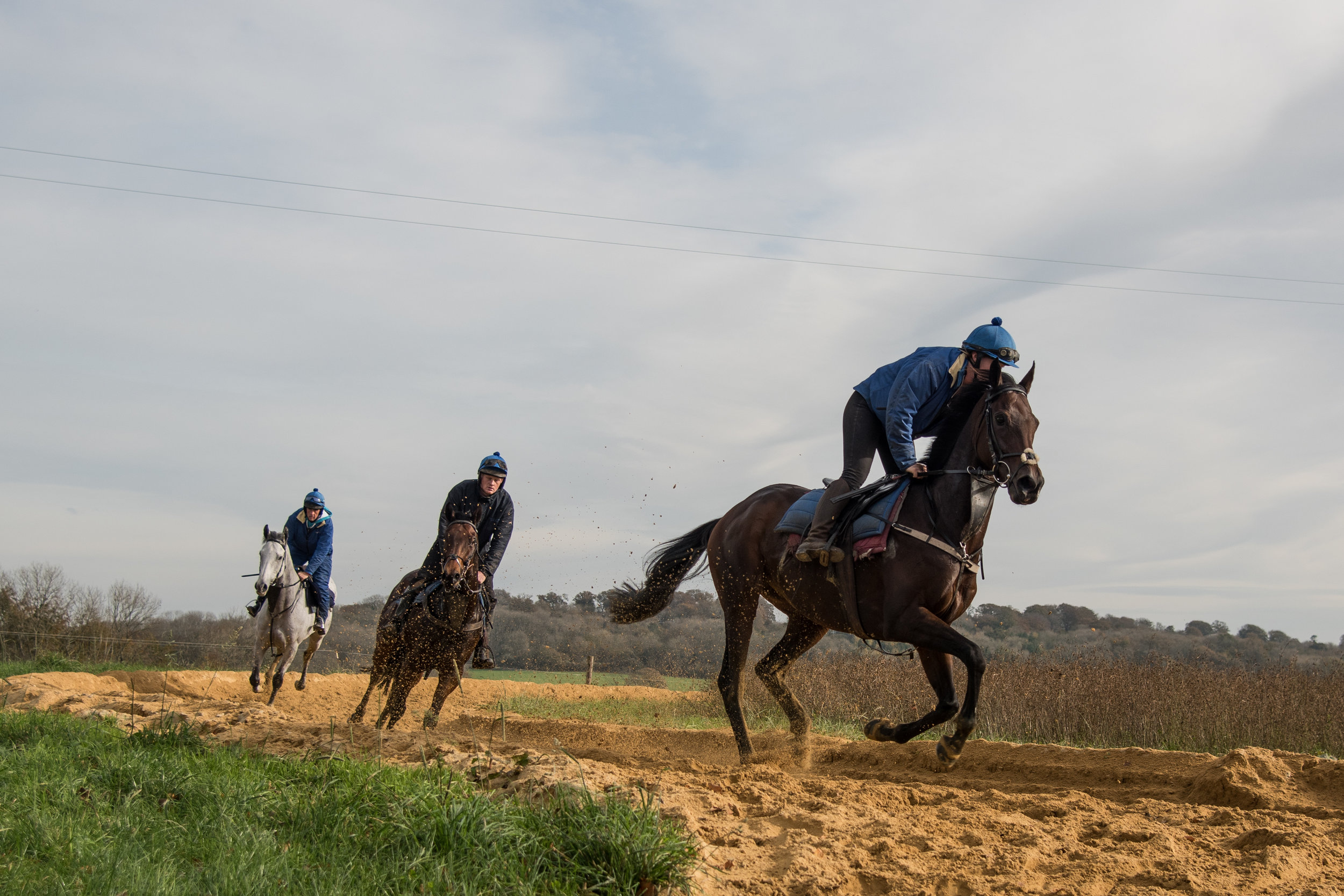
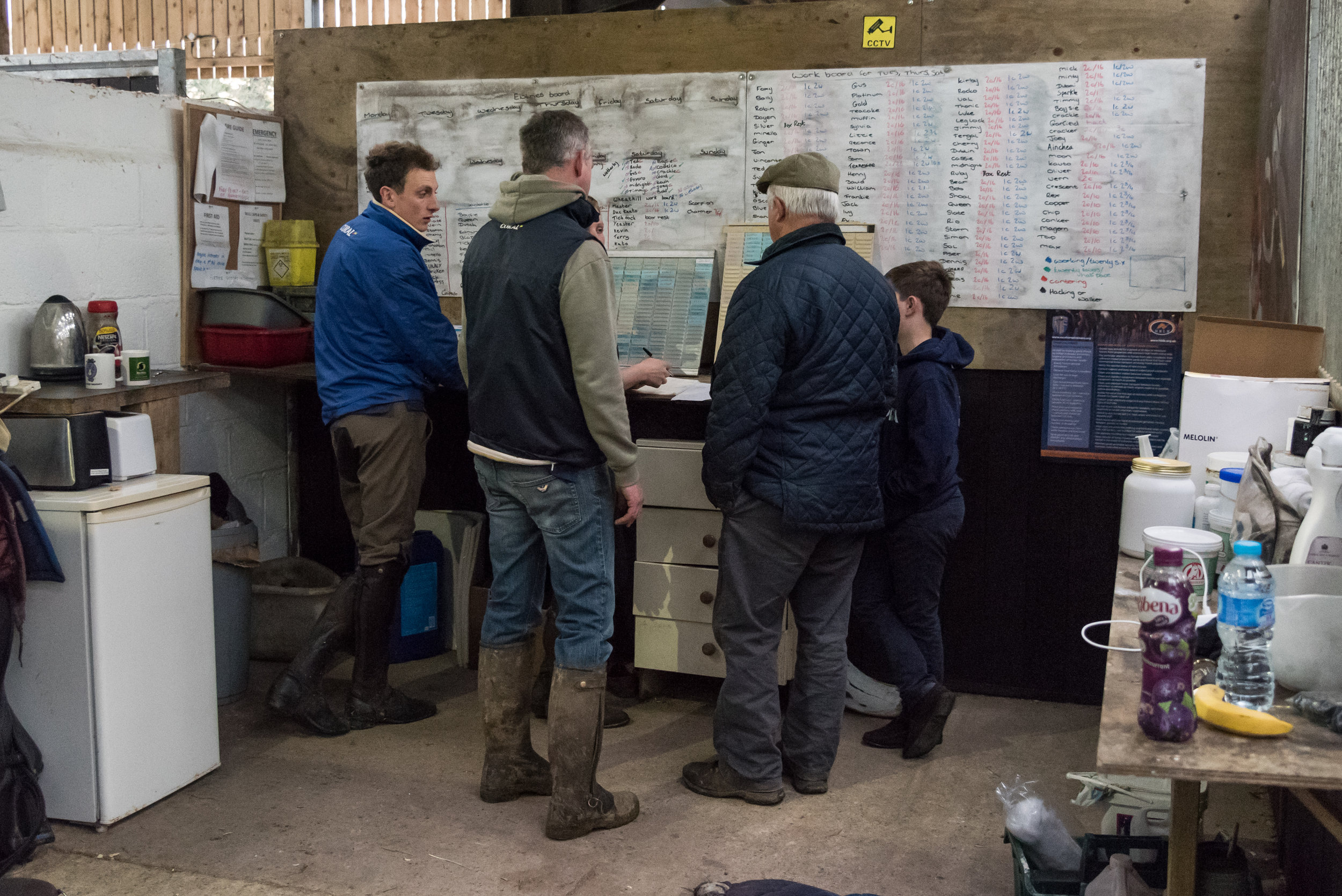
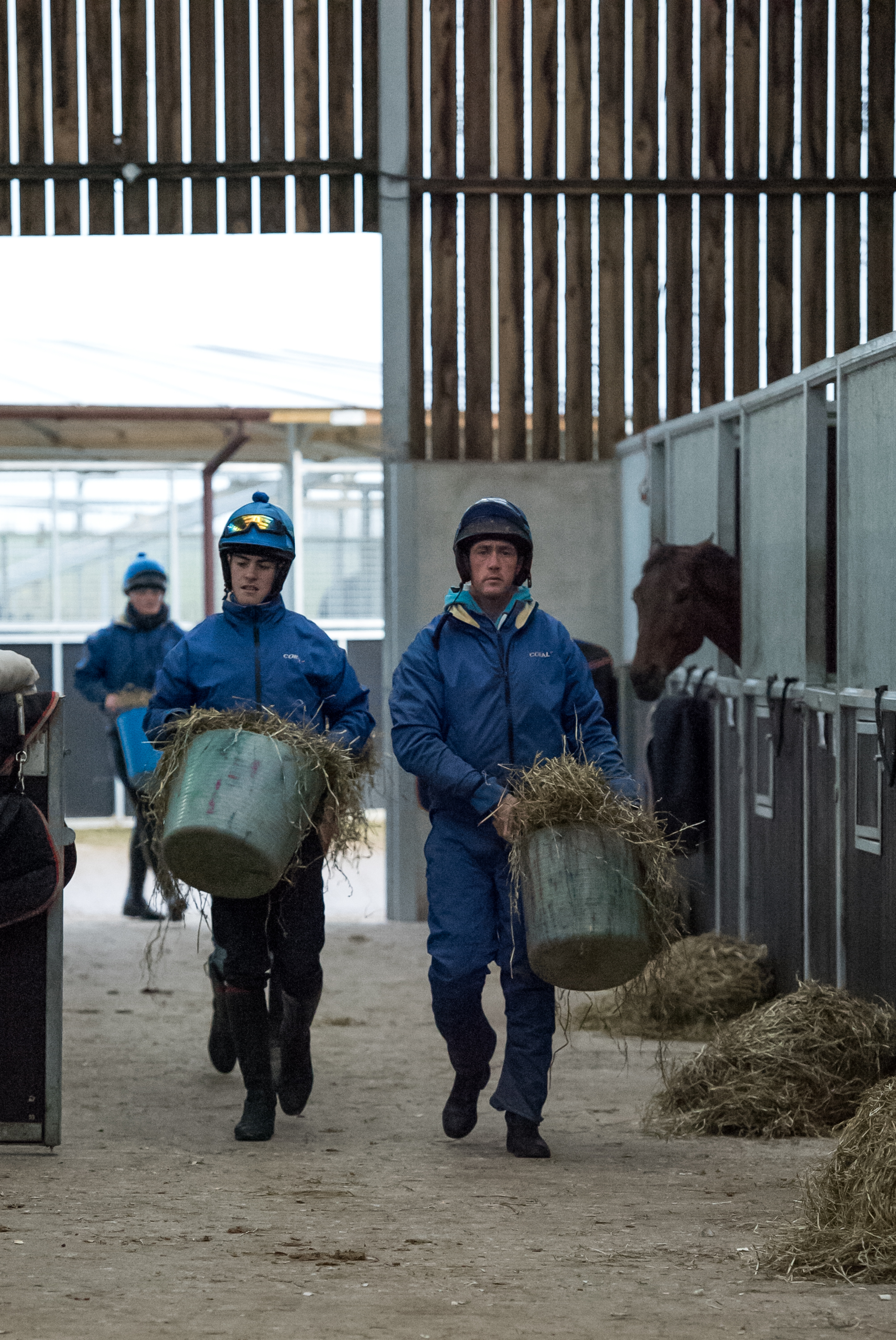
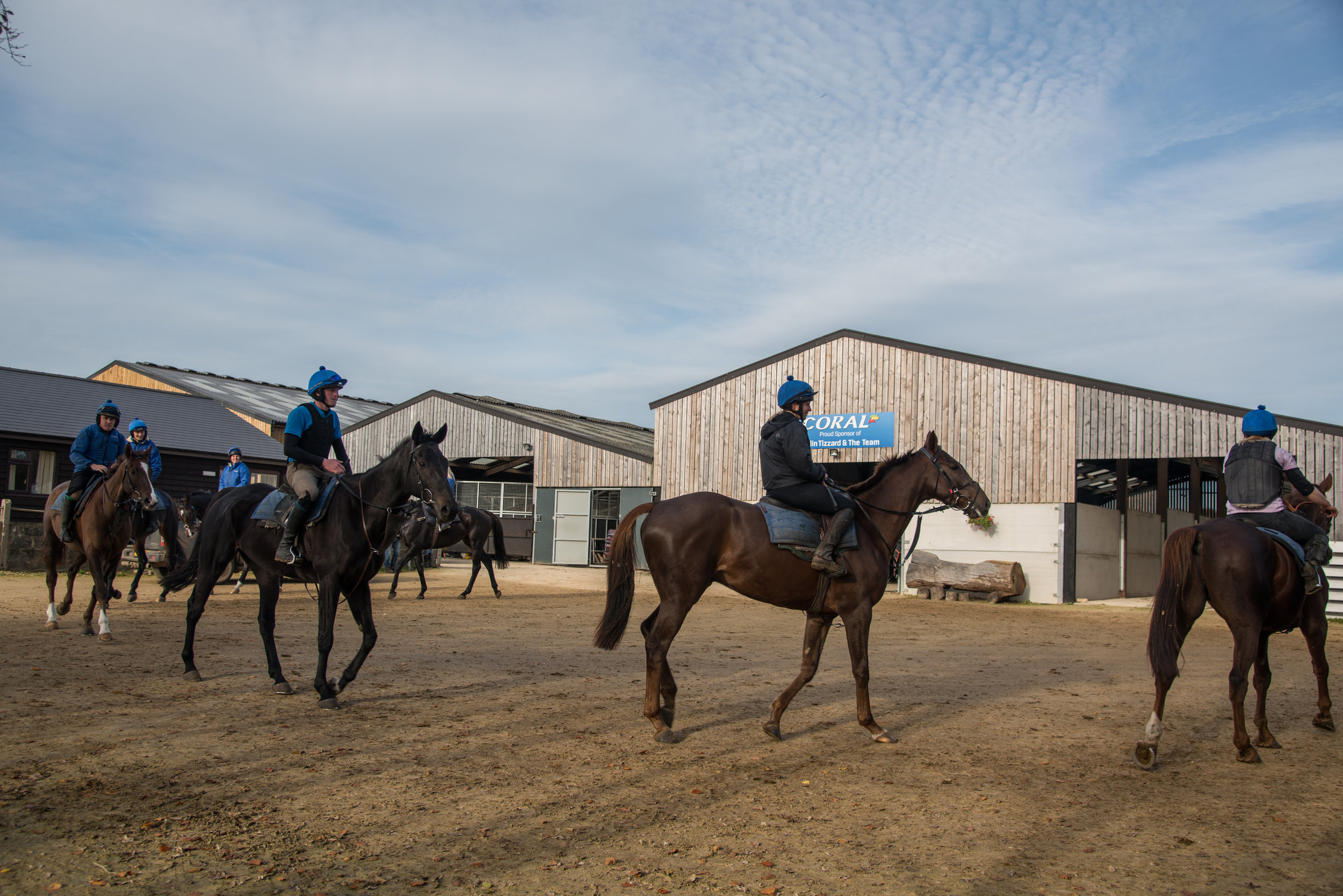
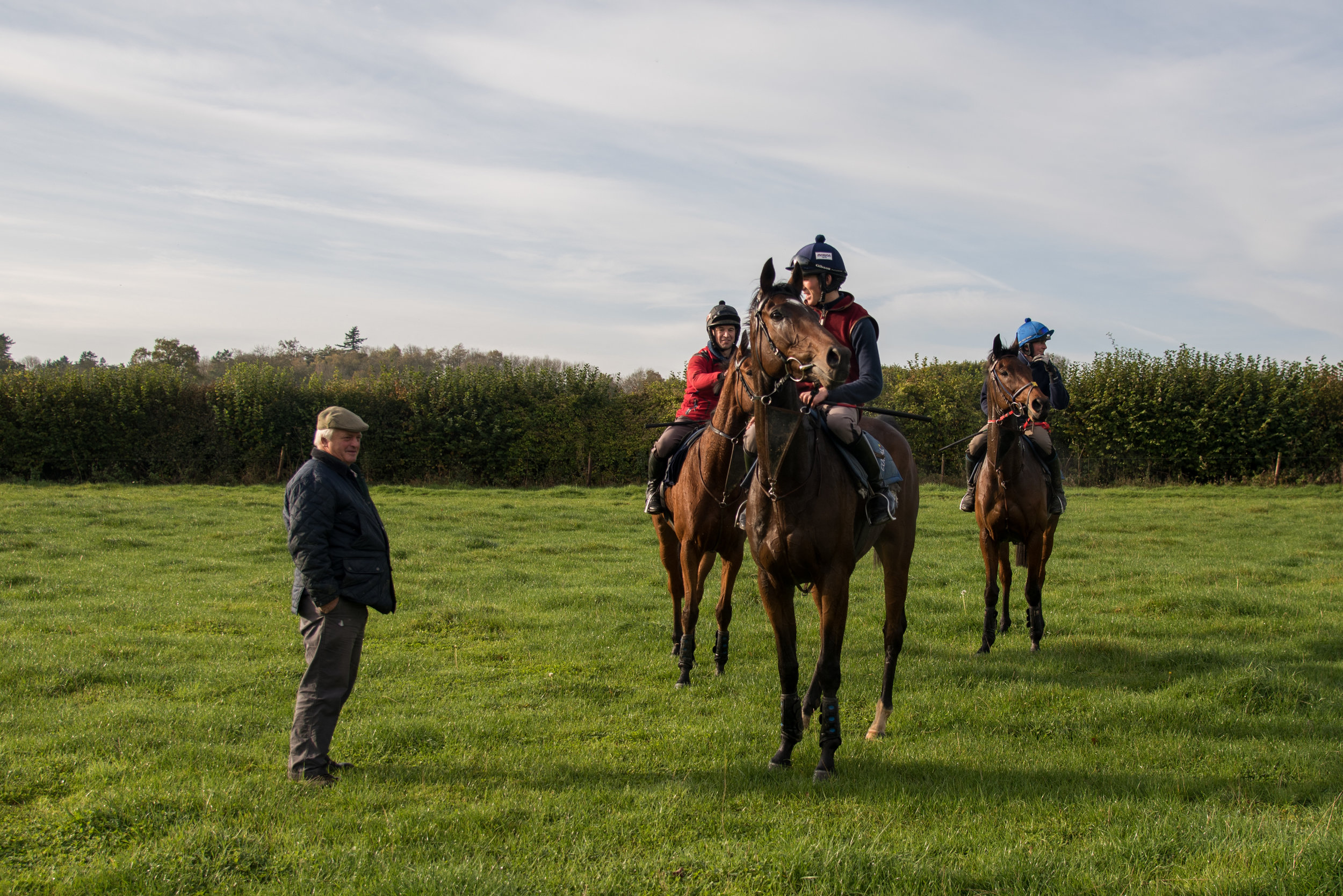
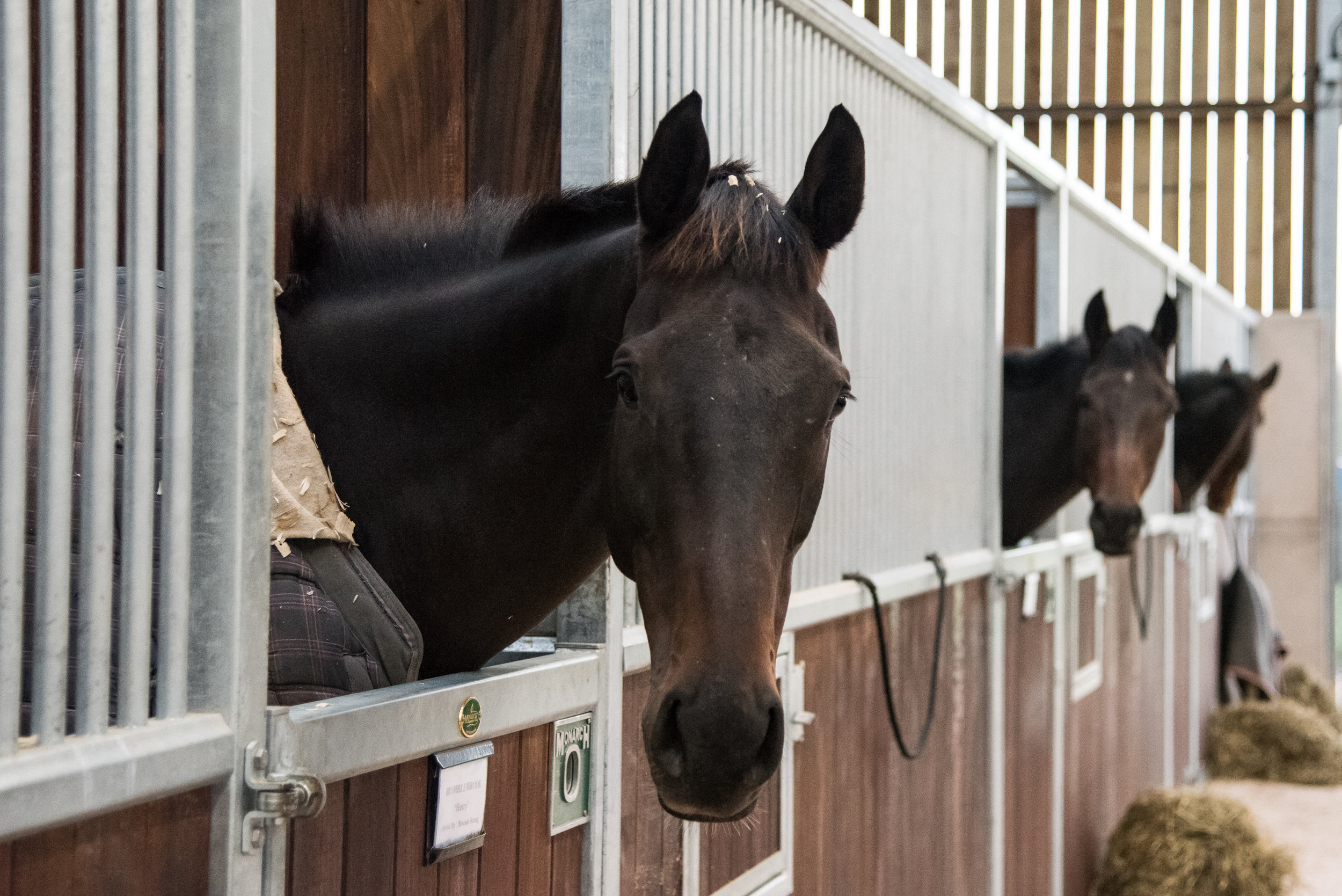
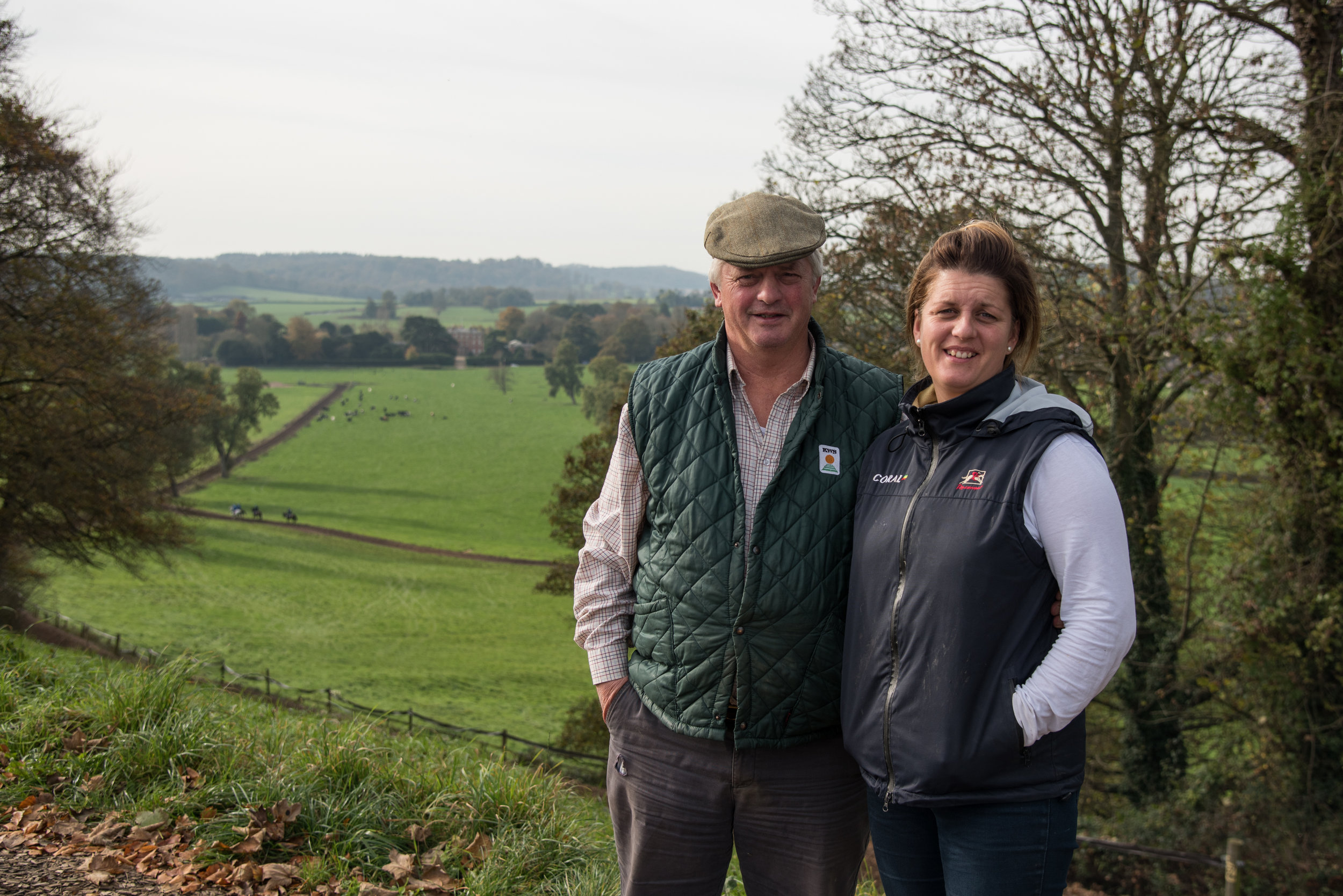
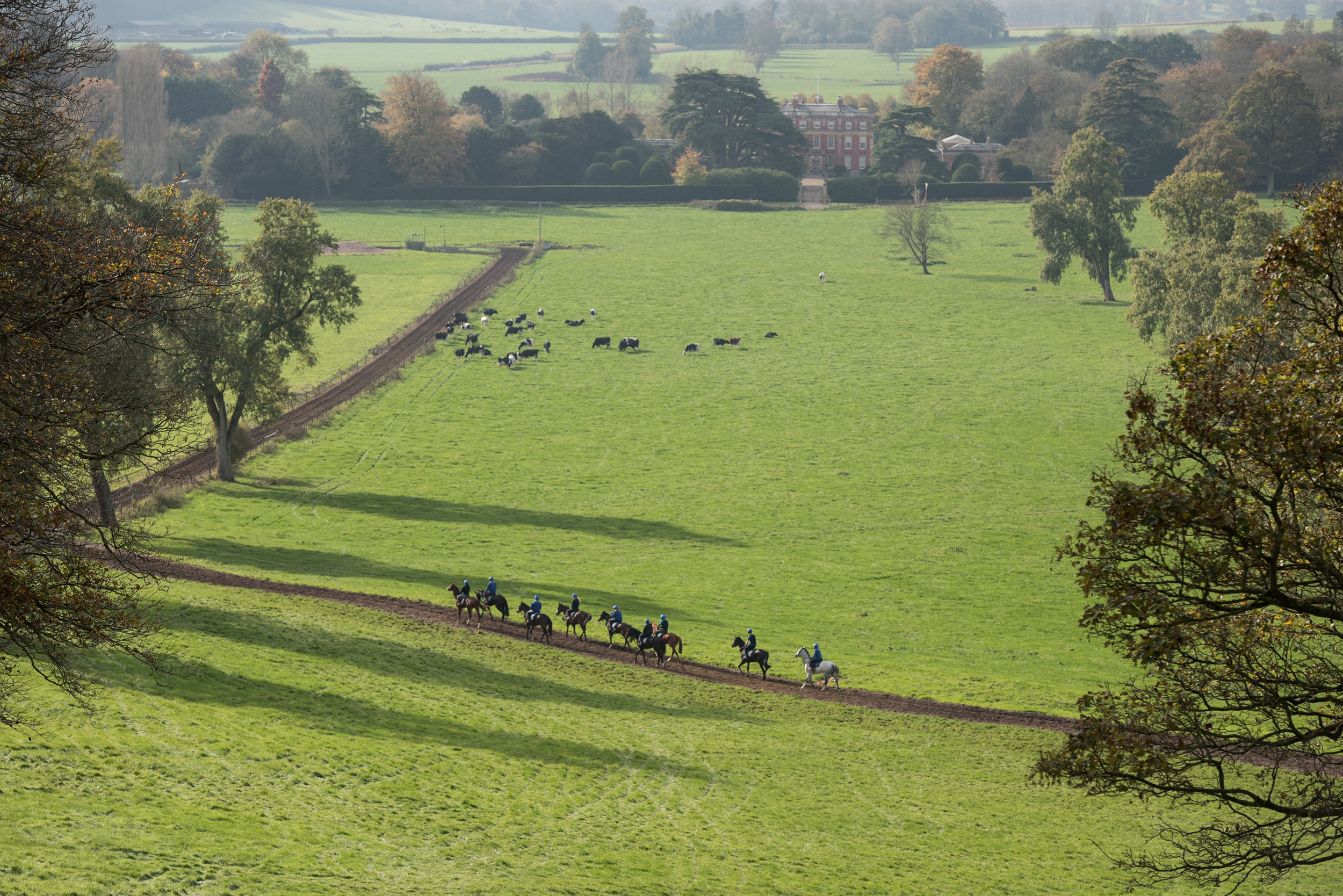
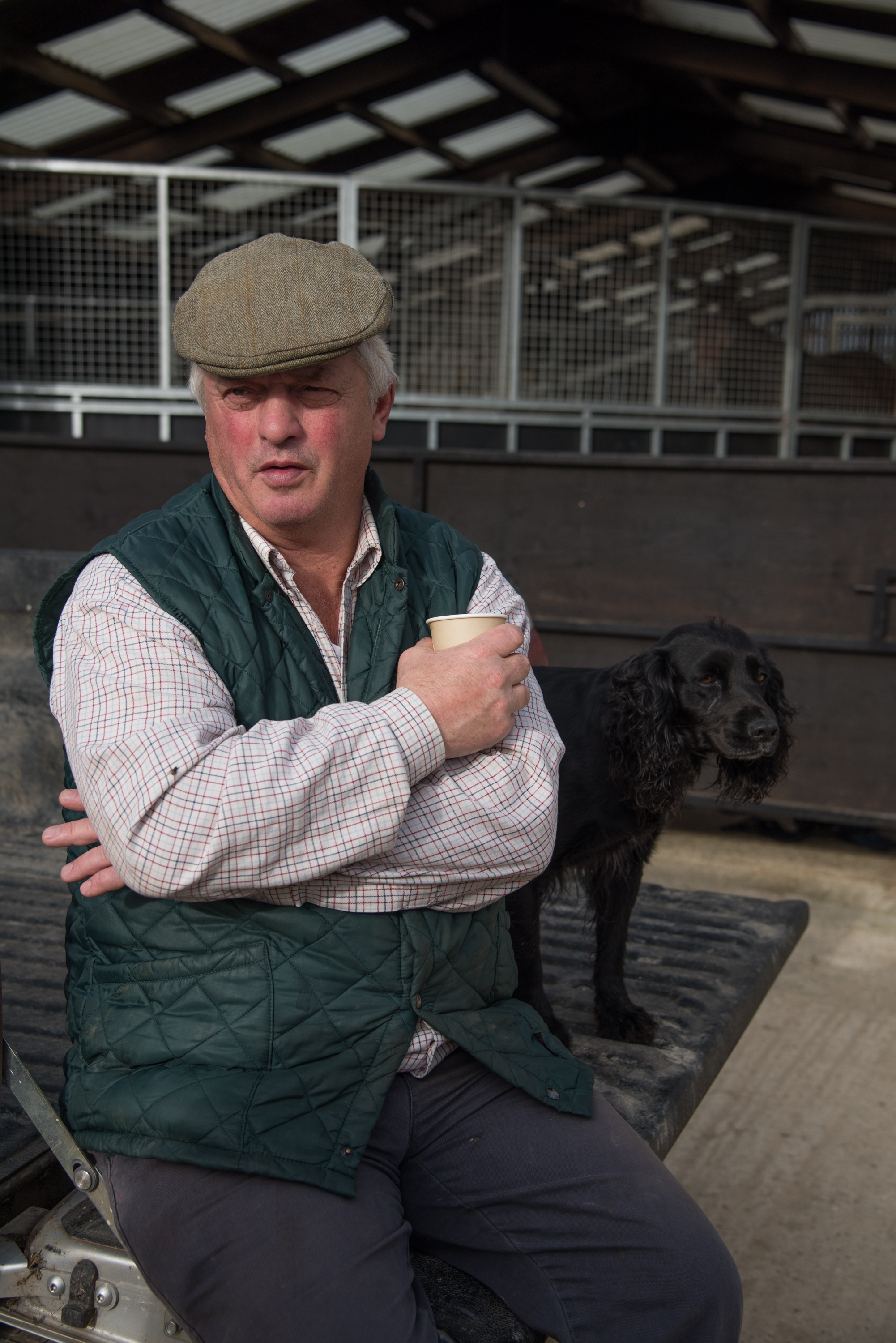

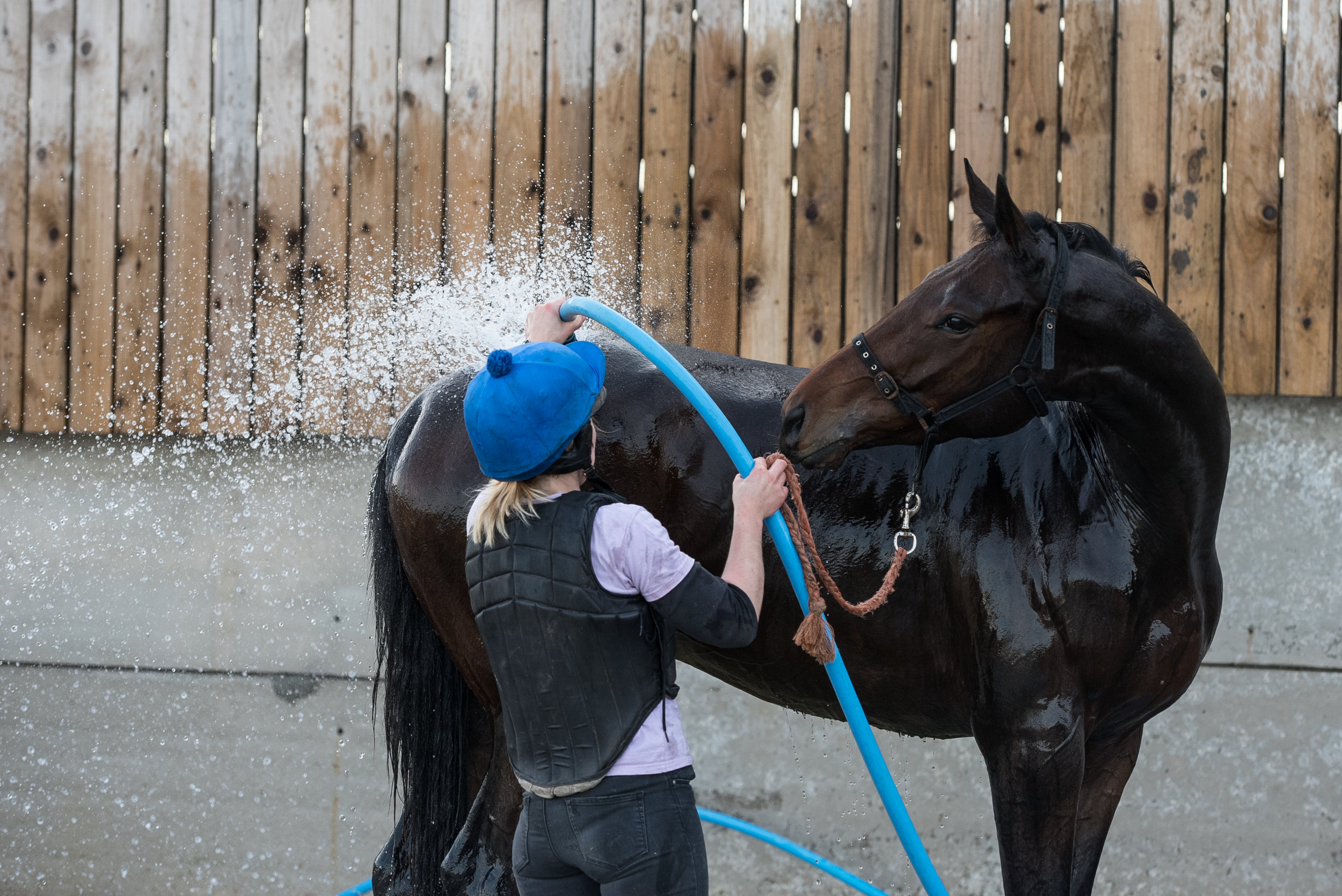
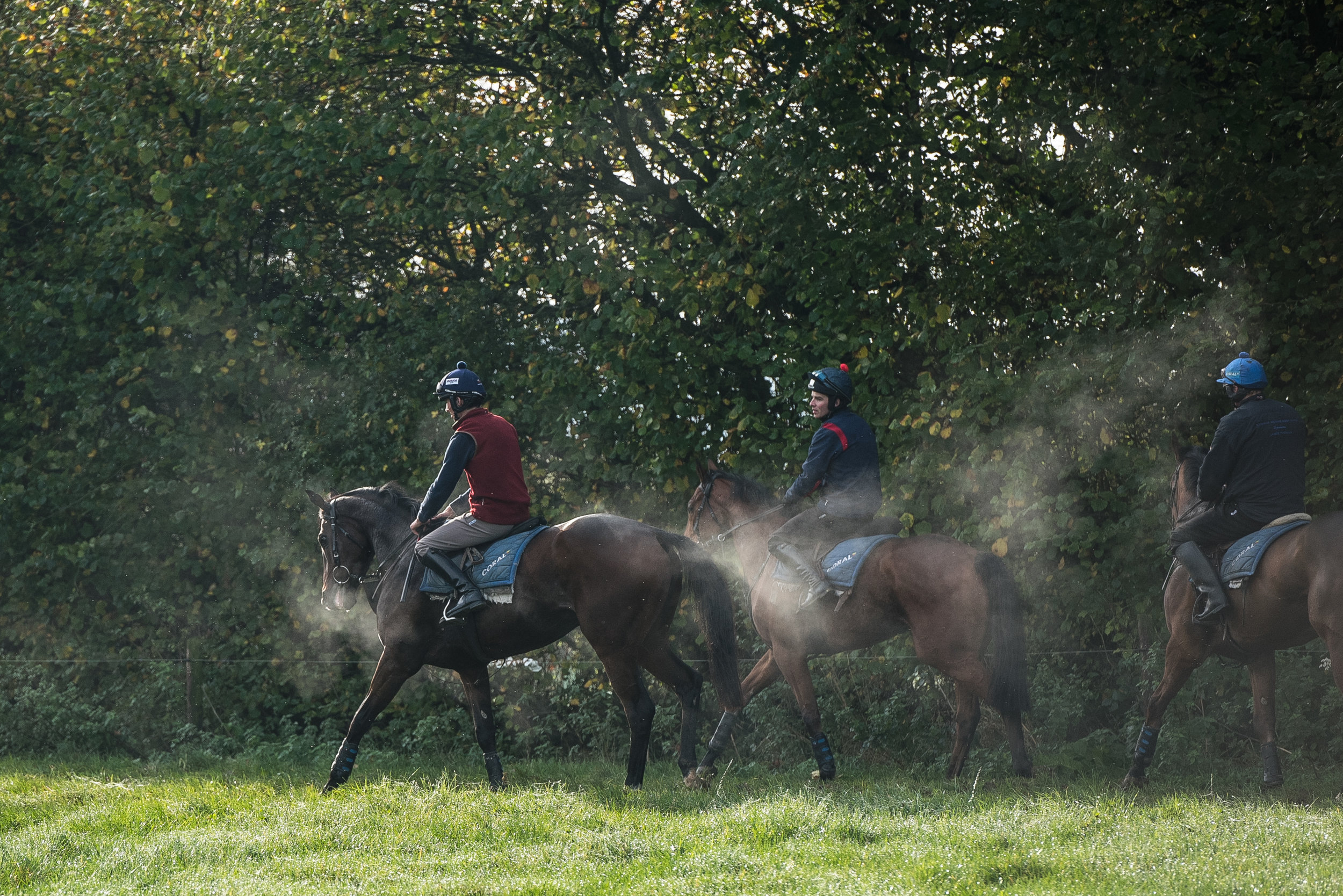
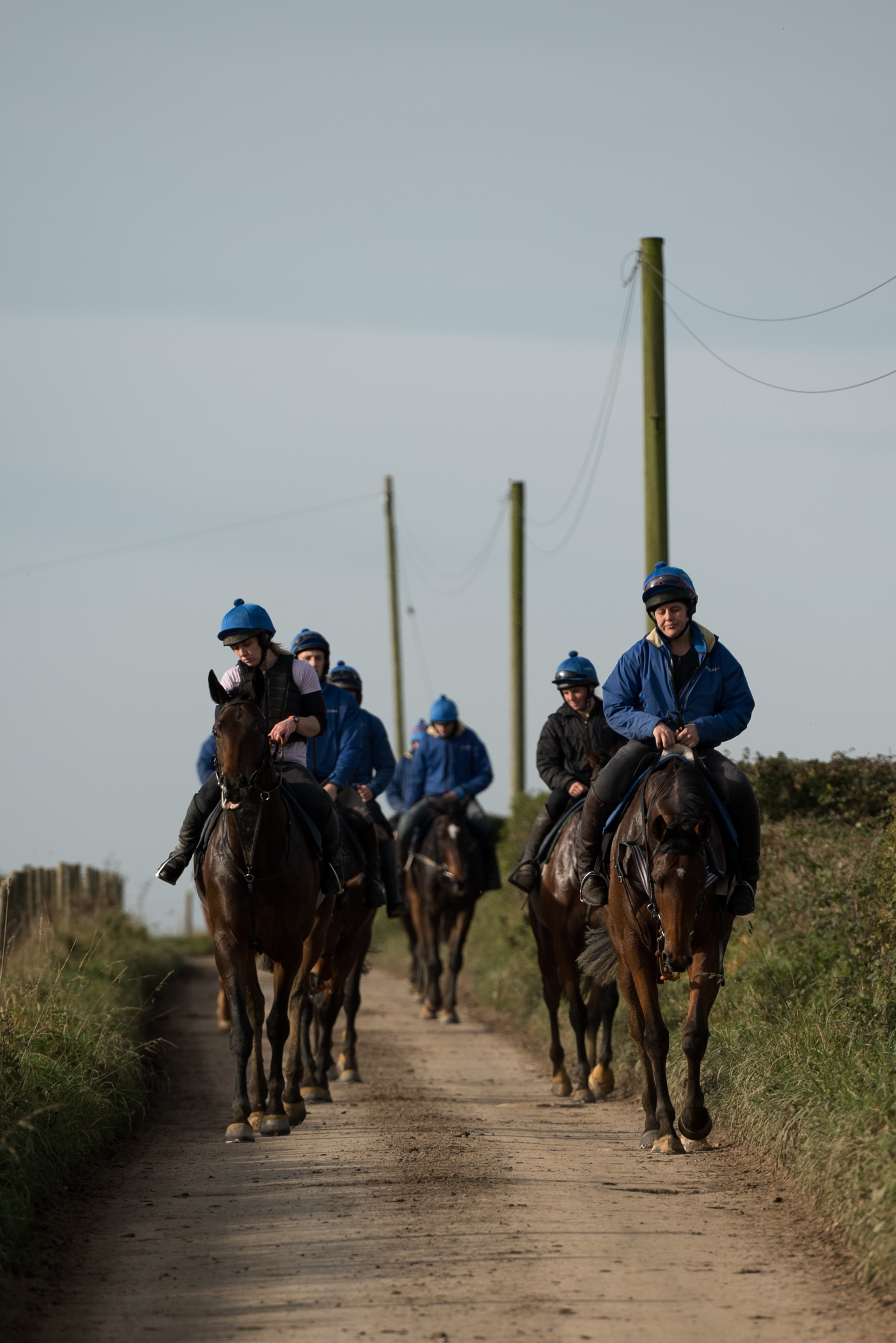
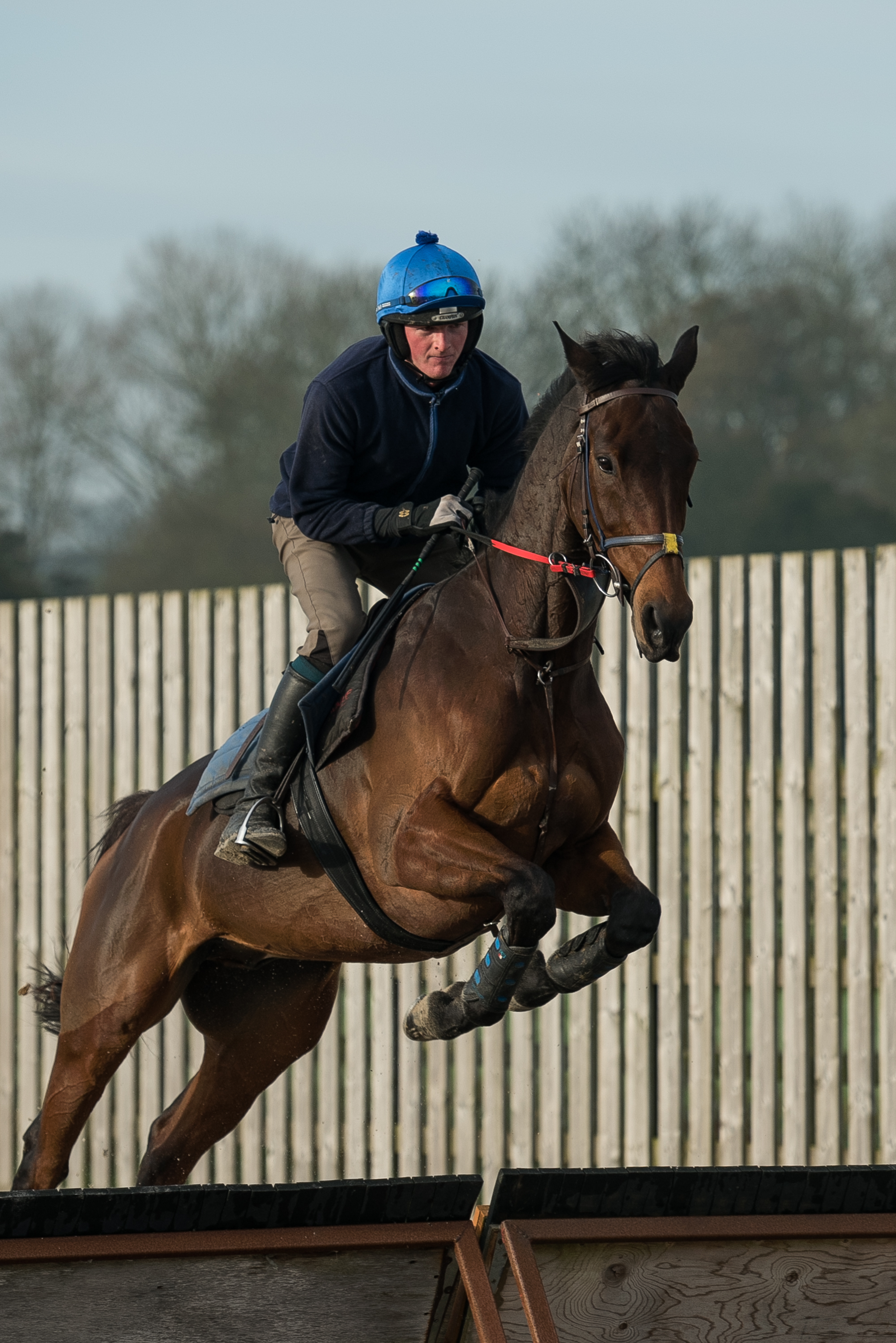
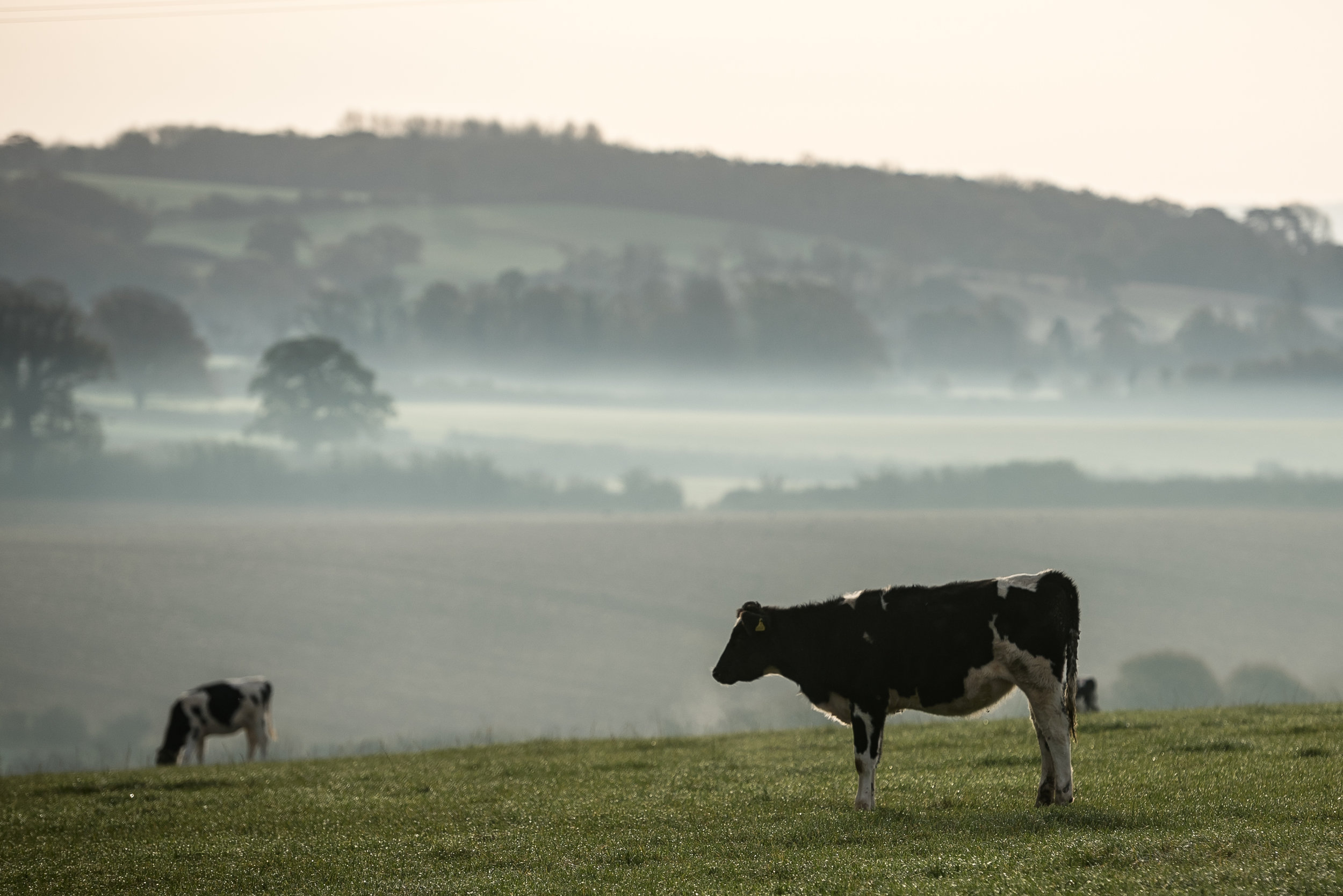
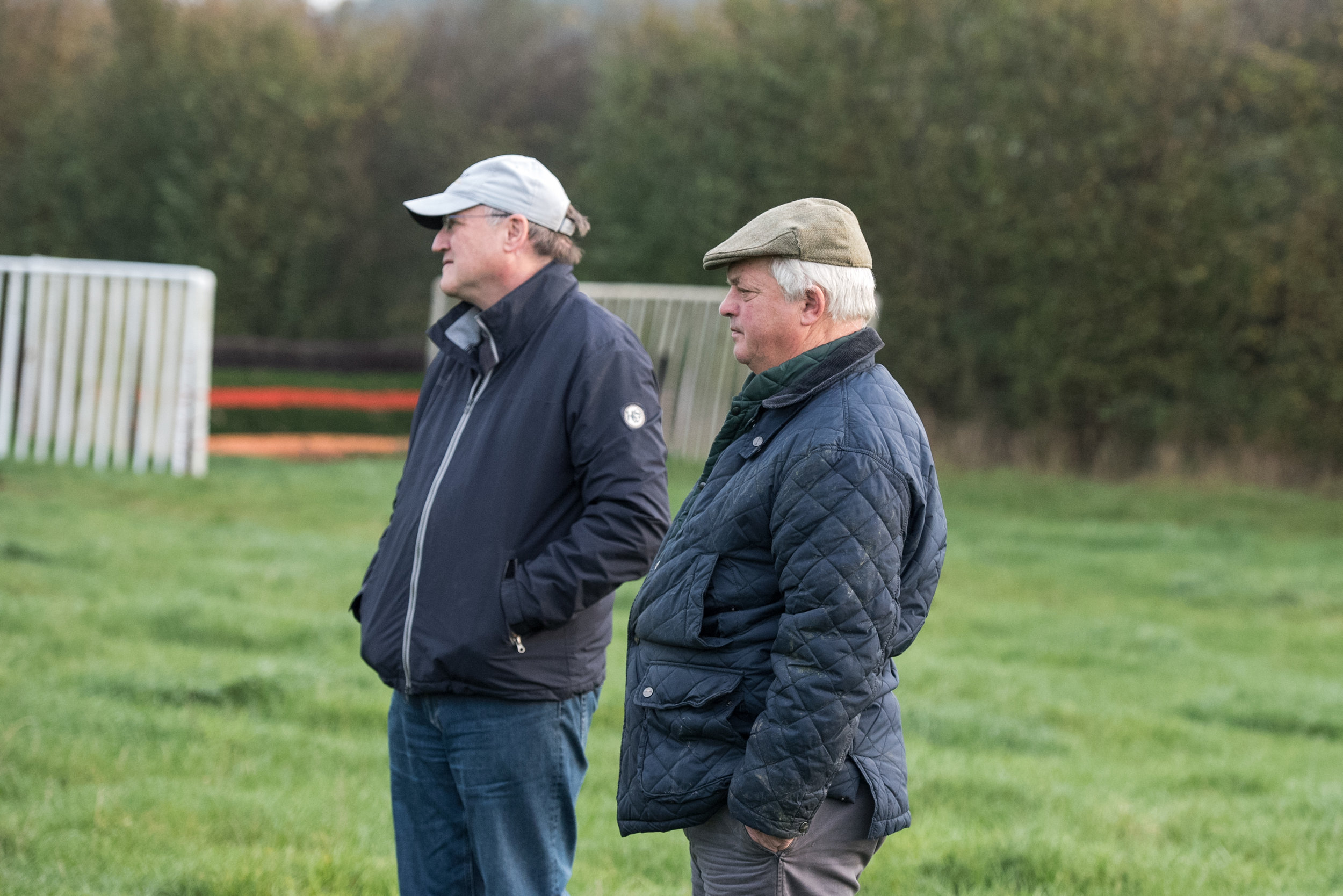
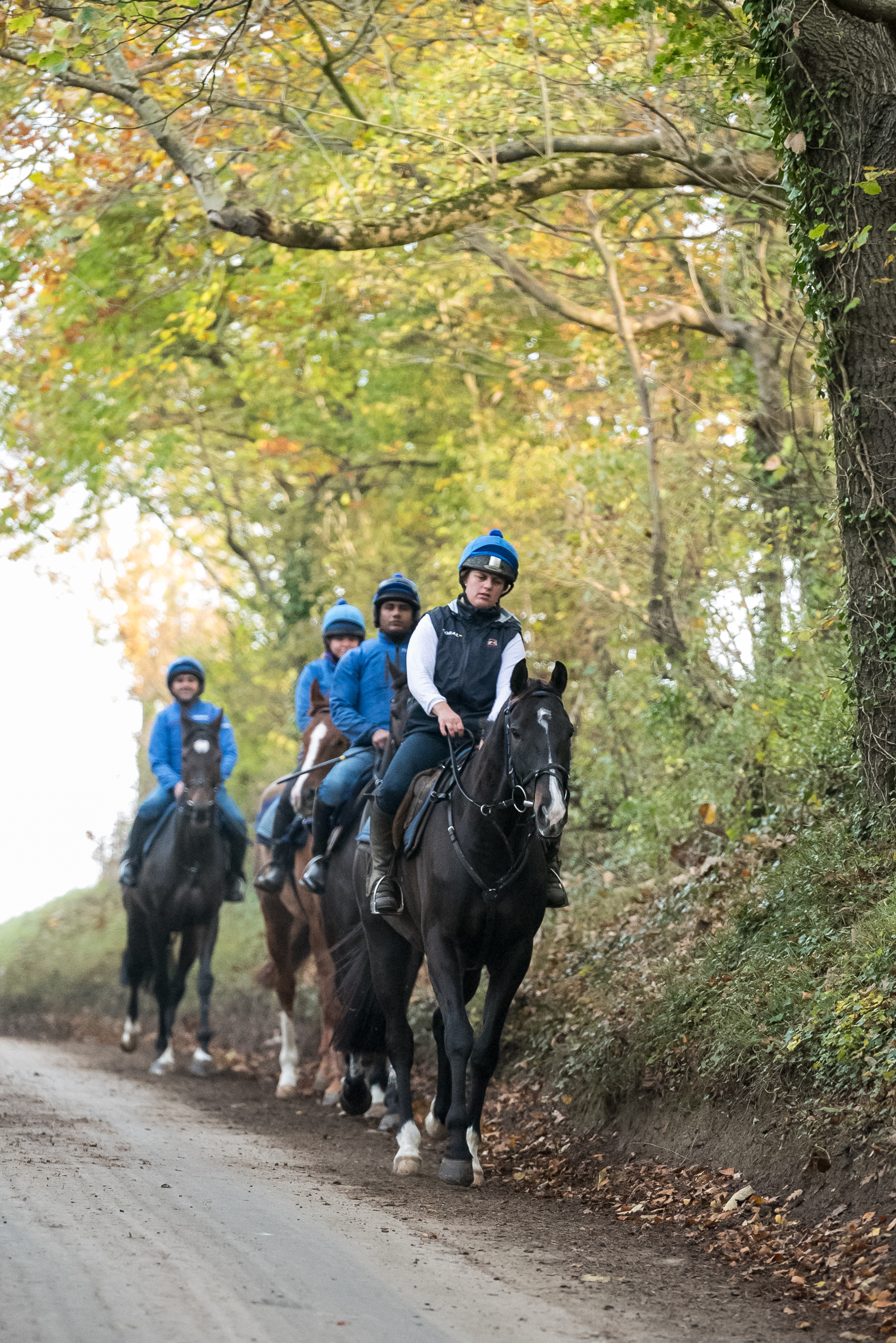
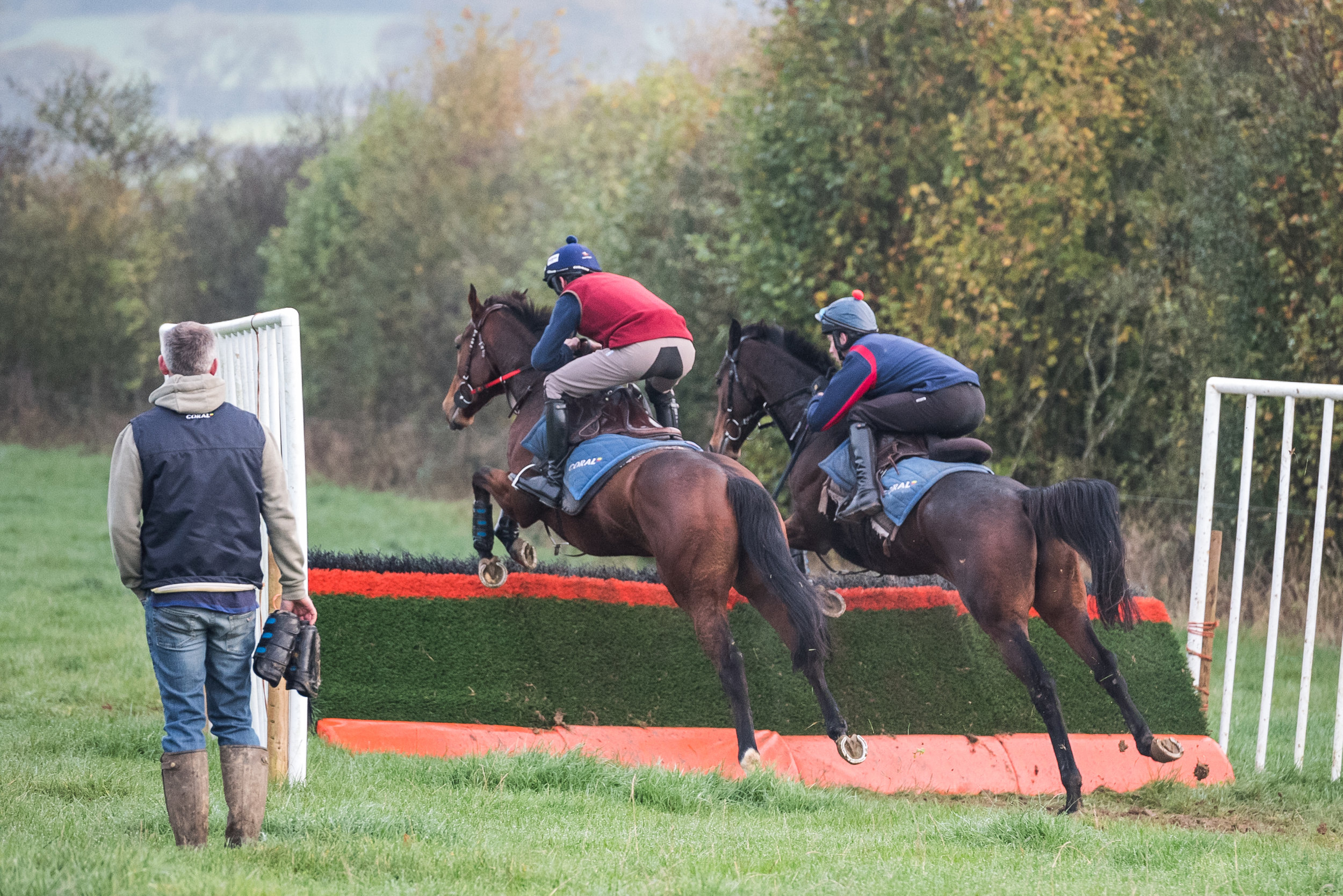
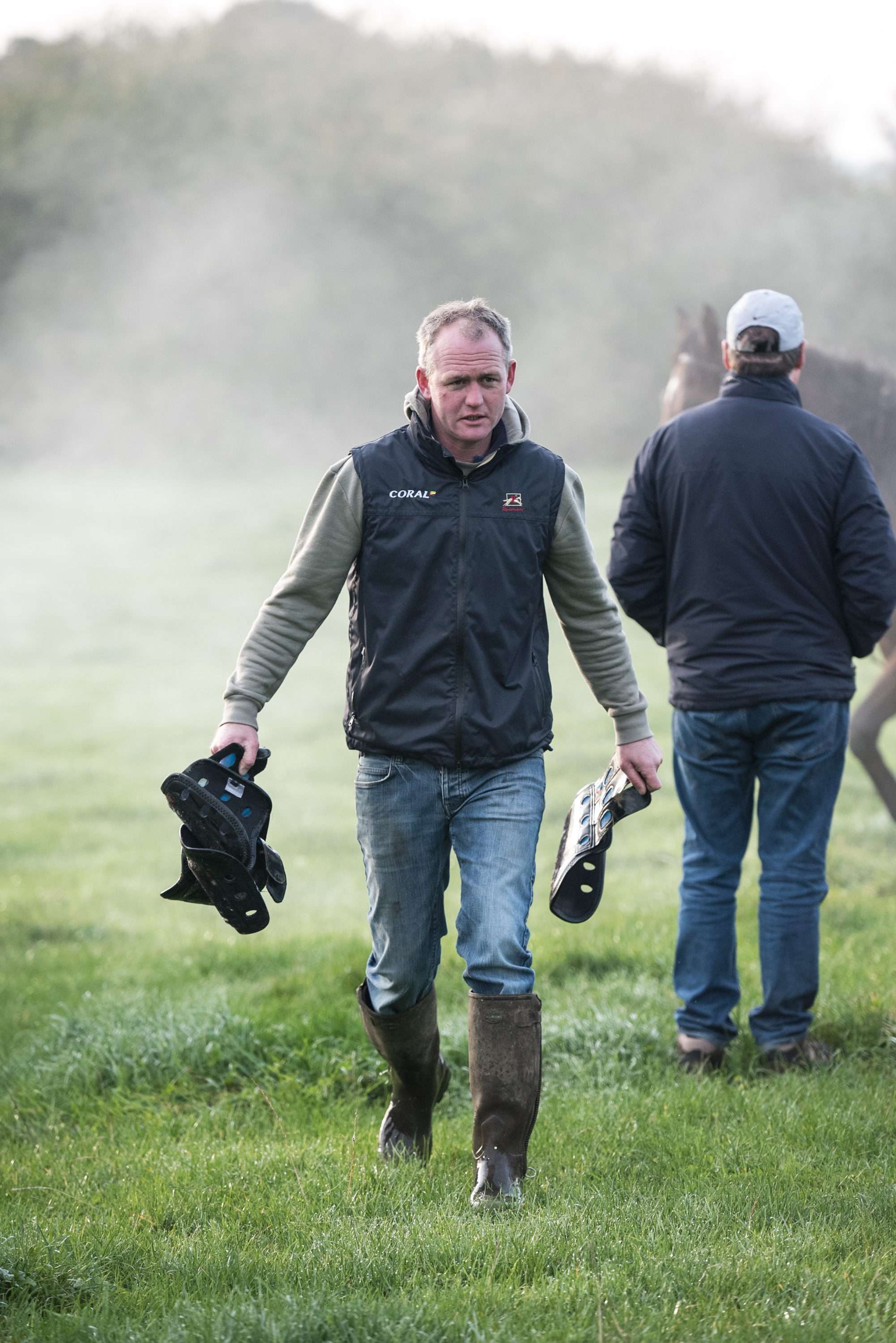


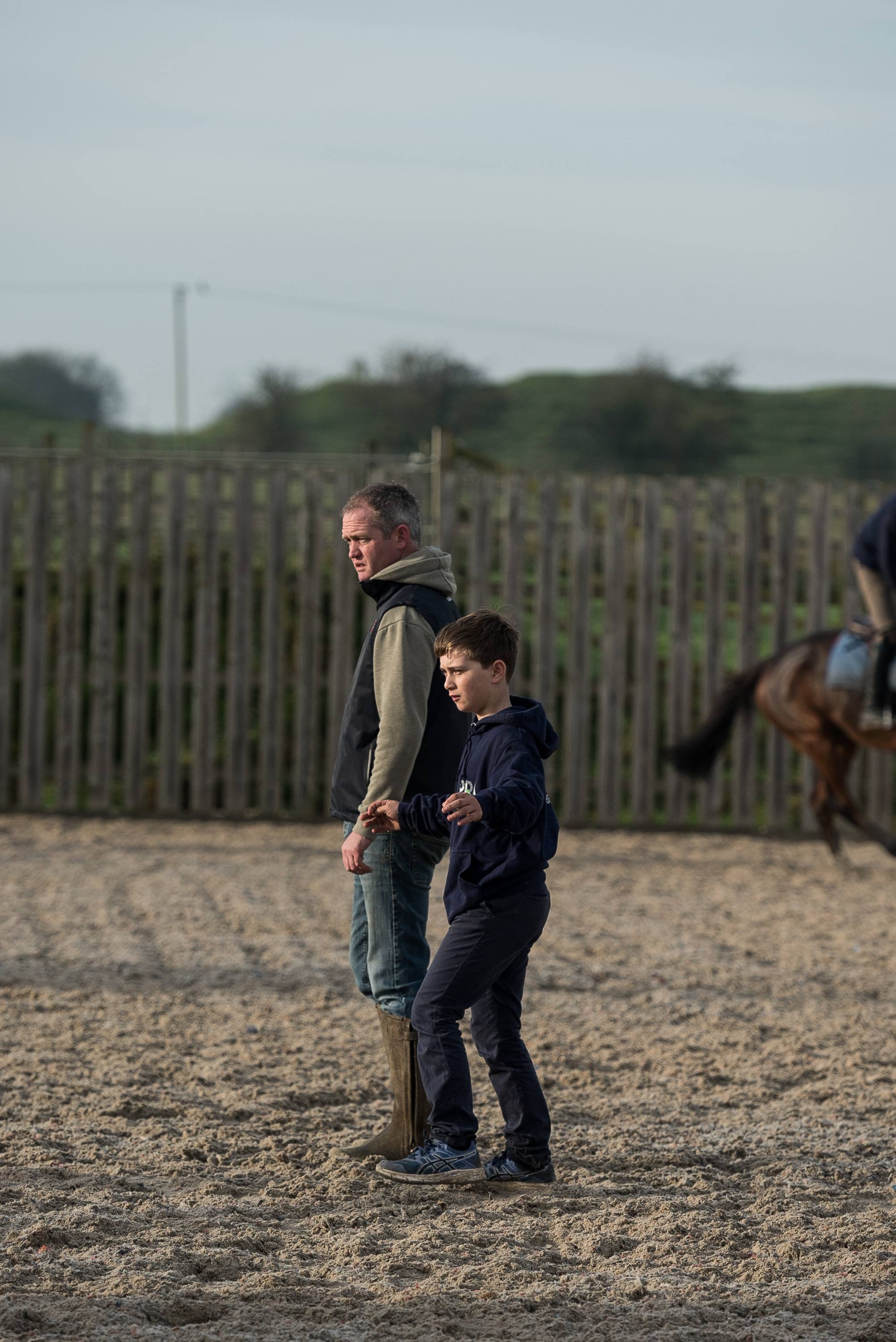
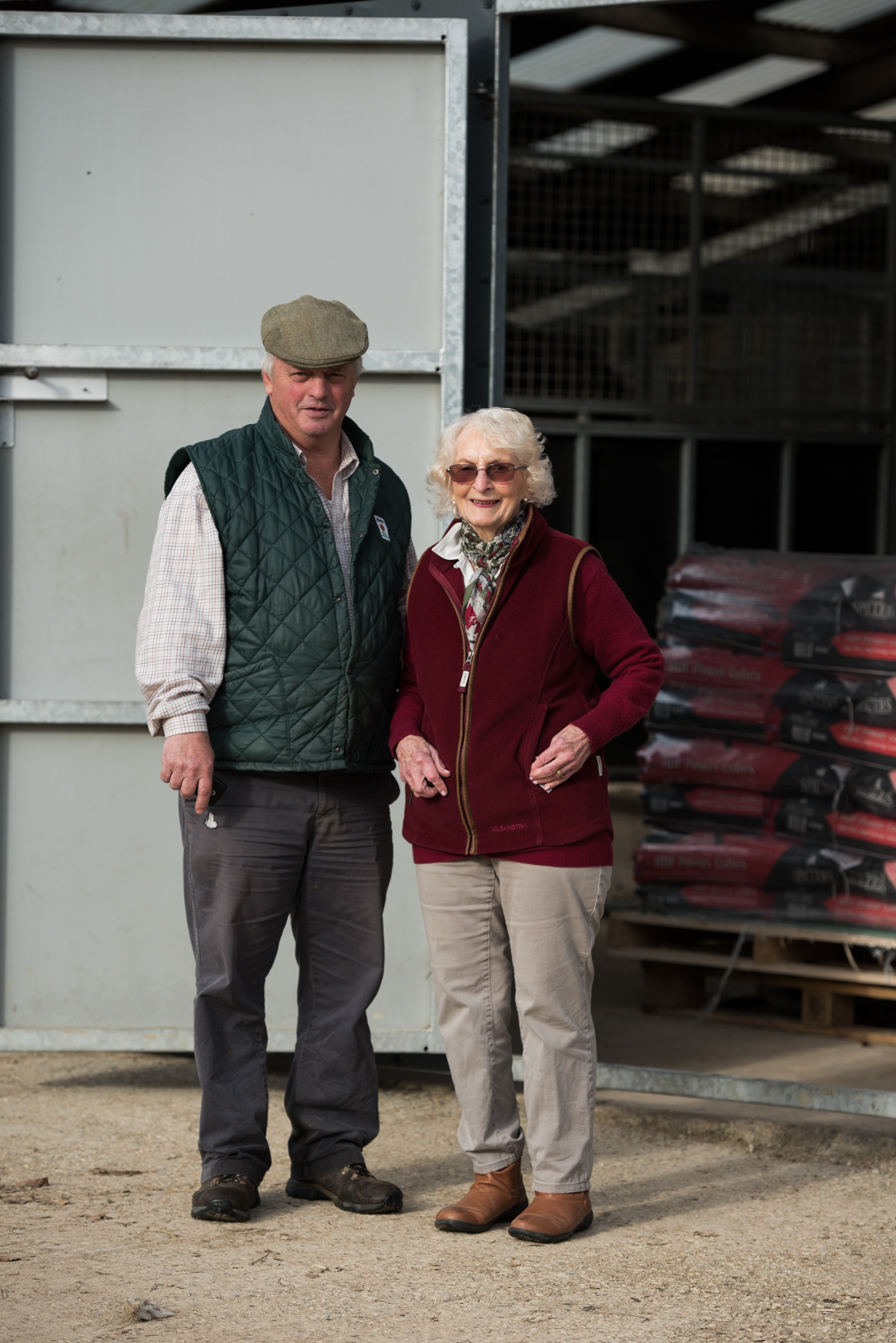
Jump racing across Europe - how is the sport developing?
CLICK ON THE IMAGE TO READ THE ARTICLE ONLINE
This article appeared in - European Trainer, Issue 55, October to December 2016
Laurent Viel - Rise of a French National Hunt racing star
CLICK ON IMAGE TO READ ARTICLE
THIS ARTICLE FIRST APPEARED IN - EUROPEAN TRAINER - ISSUE 41
Changing methods for preparing NH store horses
CLICK ON IMAGE TO READ ARTICLE
THIS ARTICLE FIRST APPEARED IN - EUROPEAN TRAINER - ISSUE 41
Lucy Wadham: a trainer with a dual purpose
CLICK ON IMAGE TO READ ARTICLE
(European Trainer - issue 36 - Winter 2011)
Guillaume Macaire - champion jumps trainer in France for many years
Guillaume Macaire is the current champion jumps trainer in France, a title he has held since 2003. He is based in the Charente Maritime region of France at La Palmyre racecourse. In 2006 he ran 231 different horses and regularly campaigns horses across Europe.
Aurelie Dupont-Soulat (European Trainer - issue 17 - Spring 2007)
Guillaume Macaire is the current champion jumps trainer in France, a title he has held since 2003. He is based in the Charente Maritime region of France at La Palmyre racecourse. In 2006 he ran 231 different horses and regularly campaigns horses across Europe.
In 2006 he wrote a regular column in Paris-Turf in which he provided insight into his runners, discussed current issues in the racing world and would provide his opinion on sensitive subjects.
Guillaume, tell us how you came into racing?
I was born in Compiègne in 1956, I frequented the racecourse at an early age. My family wasn’t involved in racing but when I went, I fell in love with it. The pictorial, timeless side of Compiègne’s racecourse certainly had a big impression on me. After a short career as an amateur rider, I started training a few horses in Compiègne, exercising my horses on the forest’s sand gallops. I then moved in Maisons-Laffitte for 2 years, then fate drove me to the south-west of France, where races were well-attended, I went to La Roche Chalais (Dordogne), I won races regularly, improved my results every year and discovered La Palmyre where I moved to12 years ago.
What are the advantages of training at Royan-la-Palmyre?
The variety of the region attracted me, as well as the track on the racecourse, there’s the nearness of the sea with big beaches, a pine forest and its paths in sand.
When I arrived, the racecourse’s sand track wasn’t really exploited; some trainers had worked on it, one of them Martial Boisseuil (well-known in Arabian racing) had had a certain amount of success from 1975 to 1990 without however leaving the borders of the Southwest of France. The facility has several jump tracks, hurdles, steeple-chase fences and cross-country jumps, and now English fences and hurdles, also the addition of sand in order to have a testing gallop reminds me of the English up-hill gallops. Here, horses must maintain their rhythm and use their back. This allows me to work in good conditions and to make really good jumpers.
I’ve trained in different places and always used the same basics, I adapt to the facilities offered by each place. Here, in La Palmyre, I use the quality of the sand as natural ground and make the best of it. But what is positive here would not be anywhere else, all the methods are good but it’s necessary to adapt oneself. Good horses make the difference.
Could you explain to me your training methods, what do you consider very important?
All the horses intended to work here are pre-selected on their pedigree, on their appearance and on their movement, as only these criteria will allow them to improve their technique in order to be more fluent and more successful. Due to this selection I quickly have an opinion about each horse, if it has “attached legs and a welded kidney” it’s not worth working any more.
I’m talking here about the horses I choose, those for which I assure an “after-sale service”; there are exceptions, other horses I wouldn’t have chosen are brought to me and they are still able to win races. According to the proverb “the good horses make the good trainers”.
I like some of my horses to come to training several times and go back to the fields to recover or simply to grow if needed. They arrive for the first time in the winter as 2 or 3 year olds. Before that, they are broken in and pre-trained by people I know, who know the way I want my horses to be worked. I like to do interval training, as I mostly train jumpers, it allows to build the horse’s fitness without killing it (it’s used a lot with humans anyway); I put bandages on all of them, they help the horse’s back to carry a rider in the right way and they help for the animal’s submission and relaxation. In their first month of training, I school them 3 or 4 times a week in a closed arena with 4 hurdles and deep sand. Indeed my inspirational mentor Baron Finot, (a leading jumping trainer in the 1880’s) whose methods I adopted and adapted to our time and whom rich painting (gouaches and watercolours) I admire had said: “the good jumpers are those who are used to jumping when they’re young”.
The arena is compulsory to me, I say it’s like a pianist is nothing without his scales, he has to practice, so the jumping technique is the main point for a jumper’s career and we have to practice. Then, depending on the horse’s behaviour and its physical ability to bear the training it will either run in the spring of its 3rd year or it will go back to the field to take advantage of the spring grass and will return in the autumn stronger.
Just as each person is unique amongst the universe’s inhabitants, my jumpers are individuals. I train each one of them regarding how it responds in order to get a certain standard, the horse’s quality will do the rest. My work is to form them as studious pupils. The trainer’s art is to find good horses and to find quickly enough if they’re worth it or not.
Feeding is of prime importance in a racehorse’s life; it’s important to respect nature. For this I have all my horses on shavings and the racks are always full of hay (from the area of Crau) which avoids them to be bored in their stable and is a great help for proper digestion. They also eat oats and in the morning and bran mash in the evening (they have it even when they’re away racing, as I own several pressure-cookers).
Another essential thing to me is the horse walker, it replaces the lunging work that was formerly used a lot when people had time. I was the first trainer in France to buy one. It is surely not an economy of staff, but allows the horse to work muscularly and mentally freely without a direct constraint from the rider’s weight and hand.
The walker is used daily for different purposes, a horse that needs to let off steam before concentrating on the work for the track, a horse with a back problem or a horse that needs to recover after the races.
I use a scale, horses are regularly weighed, especially before and after a race in order to know their exact condition. The optimum weight is a precious indicator of the state and health of the horse.
The work list is my puzzle for every day, adapting every horse with his/her rider then adapt them to each string according to the work required. I have as well to adapt to the new horses, their progress whilst keeping their objectives in mind.
No one can imagine how much the quality of a regular and constant work made in the morning is related - and improves - the final result.
Tell me about your staff?
My team consists of about 30 people; it’s a pyramid system whereby each person has their place and their function from the bottom to the top. In the summer we attract English, Irish and now Swiss riders who combine their holiday with a French racing experience. Noel Williams, Alan King’s assistant, spent some time with us last year and seemed pleased by what he discovered here and by the French racing customs, it complemented what he already knew. It is interesting for everybody to exchange different points of view as each country has its own habits.
You like to run horses in England, why?
I consider the level of competition is very high in Great-Britain, our best horses are sold and cross the channel when they’ve shown really good things there. There’s a conquering side in winning races abroad! It is the circumstances that brought me to England with Jair du Cochet, who won a Group 1 race (the Welsh Finale Junior Hurdle at Chepstow) first time out there. He didn’t pass the vet twice, so, pricked in my pride I wanted to show he was a good horse in order to prove my honesty. He adapted very well in England and ran only there, with a certain success. It is impossible for a horse to run everywhere all year through - except for The Fellow who was an extraterrestrial as he had won the Cheltenham Gold Cup and the Grand Steeple Chase de Paris. I take an outstanding pleasure running in England as this for me is the homeland of the jumping races, a consecration for every trainer to win over there. But I want to go there only with a first class chance or if an English owner of mine wants to see his horse run over there. If I have good entries for a horse who knows Auteuil I’ll stick there.
What are your hopes for 2007?
I hope we can continue where 2006 left off and to find more time for my favourite hobby – painting horses.
Paul Nolan - from complete beginner to leading National Hunt trainer in 10 years
It is at times assumed that a background in horses is almost essential for anyone to succeed at training but one individual that is certainly putting paid to such preconceived notions is Paul Nolan.
Ryan McElligott (European Trainer - issue 13 - Spring 2006)
It is at times assumed that a background in horses is almost essential for anyone to succeed at training but one individual that is certainly putting paid to such preconceived notions is Paul Nolan.
Nolan (37) is now firmly established as one of the leading National Hunt trainers in Ireland and his rise through the ranks has been nothing short of remarkable when one hears that a decade ago his experience with horses was minimal at best. From Enniscorthy in Wexford in the south eastern corner of Ireland, Nolan hails from an agricultural tradition.
“I came from a completely agricultural background. The family had 150 acres and were sheep and tillage farmers. I was involved in farming myself but I might as well have been picking blackberries. Farming was a total waste of time, it was completely non-profitable. There was no way that my parents could make a living off it and that I would be able to rear a family off it as well,” he reflects.
For one that lacked a traditional grounding in racing, Nolan has certainly made up for that over the last eight years and has managed to make his name in the hugely competitive amphitheatre of Irish National Hunt racing. In winter when racing is down to three or (at most) four fixtures a week, the standard at even the most ordinary of race meetings can be very high and it is in this environment that Nolan has had to make his mark.
It was about ten years ago that his thoughts began to turn away from farming but things could have turned out very differently for him. “I was very nearly going to go to Australia but it was the love of hurling (one of Ireland’s national sports and one where Nolan represented his county with distinction at the highest level) and the fact that I don’t like straying far from home which kept me here”.
Having taken the decision to stay at home, he then decided to put an interest and liking for horses to practical use. A six month spell with vet Tom O’Shea and a year with top trainer Jim Bolger gave Nolan the experience to set out on his own. Despite starting from humble origins, his talents didn’t take long to elevate him to the forefront of the Irish jumping scene.
“When I came home we started out with two point-to-pointers. I was charging only a minimal amount and the owners were supplying the oats but both horses won for us. Then we moved up to ten and now we have between 60 and 70 in training,” he says.
It is almost exactly eight years ago that Nolan sent out his first winner on the track. The horse in question was Nibalda, a Kambalda gelding that cost Ir2,300gns and obliged in a two-and-a-half mile Leopardstown maiden hurdle.
“Nibalda wasn’t expensive but horses don’t know what they cost and I certainly wouldn’t turn away a horse on account of what they cost”.
In fact, Nolan’s preference for buying horses is to see that the relevant individual has a good front leg: “The front leg and the shape of it is very important. I don’t like jumpers being back of the knee, you’ve got trouble keeping them sound and they don’t last as long as other horses. You like a horse to walk well but the front legs are so important. They are the wheels and ninety percent of horses lose time on the track if they are not right”.
After Nibalda’s success, Nolan continued to do well with inexpensively bought horses but his success over the last four seasons has enabled him to train a better standard of horse and thus compete at a higher level. It is by now a regular occurrence to see his representatives make more of an impact in the country’s top jumping races.
To have one’s first winner at a track like Leopardstown is a significant boost for anyone’s career but the victory that has been the cornerstone for much of Nolan’s success was that of Say Again in the 2002 Galway Hurdle.
The week long Galway festival is undoubtedly one the most important weeks in the year in the domestic racing calendar and indeed Galway Hurdle day regularly attracts the biggest crowd of the year to a racing fixture in Ireland. Nolan could not have picked a better stage for one of the biggest winners of his career and it was after this success the size of his string began to increase significantly towards what it is today.
Say Again, Cloone River and Accordion Etoile are three of the best horses Nolan has trained and all three are traditional National Hunt types. Their trainer has also done well with useful ex-flat recruits but it is the jumping bred horses that have provided him with much of his success. “They stay more honest to the game for longer,” remarks the Wexford-based handler.
However, Nolan notes the mindset of many owners coming into racing is now making life that bit more difficult for National Hunt-bred horses as the emphasis has shifted on to producing results as quickly as possible.
“National Hunt horses are being broken earlier to be that bit more forward and patience is hard to come by as people want answers as soon as possible. You are better off telling owners that their horse isn’t going to run for a year because it is so backward rather than building up people’s hopes and then trying to explain where things went wrong”.
A feature of Nolan’s successes has been the involvement of his family and his brother James serves as assistant trainer: “He’s a key man. He’s great to work and loves his job. My father plays a very important role and I can’t say enough about Brendan my head man. He’s been with me since the start and is top class”.
Ask the trainer about what he thinks are the most important aspects of training racehorses and the response is instantaneous – health and fitness. The brittle nature of the thoroughbred and the ephemeral nature of racehorse training are already well documented and they are perhaps no more evident than during the winter months of the national hunt season.
“It’s so hard to keep a horse right and keep him fit. It terms of their health, the time I spent working with a vet was certainly help but you have to try and keep them sound as well. Flat trainers do very little different to jumping trainers but the National Hunt is much harder on their bodies and limbs. I also think it is very important to keep them in the right frame of mind,” he comments.
As personable, amiable and helpful an individual as one could ever meet, Paul Nolan has done exceptionally well to make his way to prominence in the National Hunt world. Interestingly when asked as to what was the most difficult aspect of embarking on a career as a racehorse trainer he comes up with a very refreshing response.
“The worry of failure and not doing well. People said that we were crazy and that we didn’t know what we were getting into. Thankfully luck was on our side and we are now making a living out of it and hopefully we will continue to be able to do so”.
Similarly, when asked about his ambitions for the future the trainer adopts the understated approach that has been the hallmark of his career and has brought him to where he is now: “If I could keep in the top ten trainers in the country I’d be happy”.
Conventional wisdom and traditional beliefs dictated that somebody like Paul Nolan would struggle to make an impact but his talents have shone through to make him one of Ireland’s brightest training recruits. Big races and high profile successes, such as that of Dabiroun at last year’s Cheltenham festival, have already come his way and his is a name that we will be hearing much more of in years to come.

























